NHK WORLD > NHK WORLD TV > BENTO The Global Lunchbox Project
-
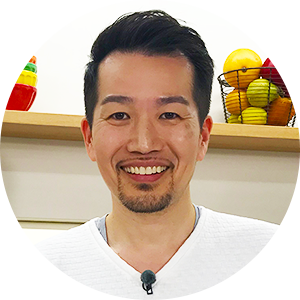
- Marc Matsumoto
-
Marc Matsumoto is a private chef, culinary consultant and TV presenter with a base of clients around the world. Born in Japan, and raised between the US and Australia, Marc developed an early love for travel and a broad palette of global flavors. He believes that by making wholesome delicious food accessible to people of all backgrounds, the world becomes a better place.
-

- Maki Ogawa
-
Maki Ogawa's books have been translated into three languages and are sold around the world. Yum Yum Bento Box is credited with starting the recent bento boom. She also loves to post pictures and recipes on social networks like Facebook and Instagram and she's been featured by news outlets from around the world. Many of her bento ideas come about when she's cooking for her two sons. Fans love her delicious, easy-to-make, kawaii bento ideas!
-
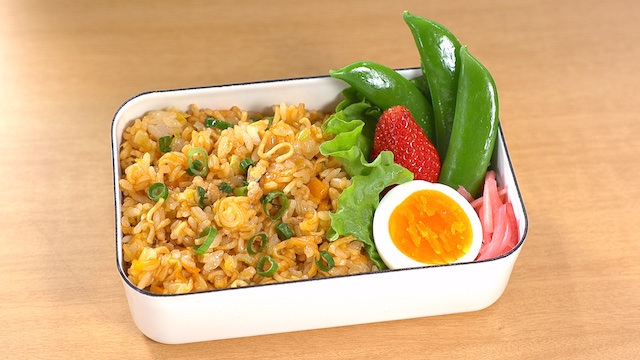
- BENTO RECIPES
- from Episode 20 / Season 7.
- Sobameshi (Fried Yakisoba-and-Rice) Bento
- (688 kcal)
-
 by Marc Matsumoto
by Marc Matsumoto
Bento contents:
- Sobameshi
- Frill lettuce
- Snap peas
- Strawberry
- Hard-boiled egg
- Benishouga
Ingredients:
Makes enough to pack into 2 bentos
- 1 pack unseasoned instant ramen, about 100 g
- 200 g leftover rice
- 2 tbsp Worcestershire sauce
- 1 tbsp oyster sauce
- 1 tbsp ketchup
- 1 tbsp vegetable oil
- 60 g cabbage, finely diced
- 40 g carrots, finely diced
- 120 g chicken
- 1/3 cup water (about 80 ml)
- 1 scallion, chopped for garnish
Directions:
1.Put the pack of ramen noodles in a zipper bag and crumble with your hands.
2.Wet your hands and crumble the rice so there are no big clumps.
3.Make the sauce by whisking the Worcestershire sauce, oyster sauce, and ketchup in a bowl.
4.Stir-fry the cabbage and carrots together with the oil over medium-high heat.
5.When the vegetables are mostly cooked through, add the ground chicken and crumble it up. When the chicken is cooked, add the crumbled ramen noodles and water. Cook while constantly stirring until no liquid is left in the pan.
6.Add the rice, and stir-fry the mixture until the rice has heated through.
7.Drizzle the sauce evenly over the sobameshi and toss it together to finish.
8.Garnish with chopped scallions.
-
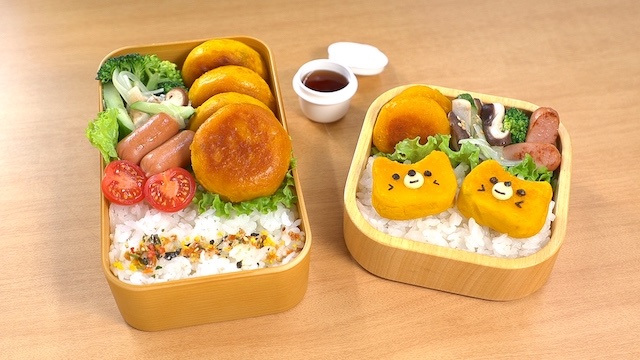
- BENTO RECIPES
- from Episode 20 / Season 7.
- Pumpkin Mochi Bento
- (For adults 846 kcal, For kids 431 kcal)
-
 by Maki Ogawa
by Maki Ogawa
Bento contents:
- Cooked rice (220 g for adults, 105 g for kids)
- Pumpkin Mochi
- Broccoli
- Sweet pickled cucumbers, onions, and shiitake mushrooms
- Sausages
- Lettuce
- Furikake rice seasoning
- Sweet and savory sauce (as desired)
- Cherry tomatoes (for adults)
- Kitty Pumpkin Mochi (for kids)
Ingredients:
For Pumpkin Mochi
(for 4 big + 4 kids-size mochi)
- 240 g kabocha squash
- 2 tbsp + 2 tsp potato starch
- 1 slice cheese
- 10-15 g butter
For the sweet and savory sauce
- 1 tbsp + 1 tsp sugar
- 1 tsp sake
- 2 tsp soy sauce
- 4 tbsp water ★
- 1 tsp potato starch ★
For the Kitty Pumpkin Mochi
- Pumpkin Mochi
- Sliced cheese
- Nori
Directions:
For Pumpkin Mochi
1.Peel the kabocha and boil till tender.
2.Mash the kabocha and knead with potato starch to make a dough.
(If the kabocha is watery, add more potato starch; if it’s flaky, add milk.)
3.Divide the dough into four 40 g and four 20 g pieces.
4.Fold the cheese into fourths and cut into six stacks. (Make two of the stacks slightly smaller for the kid’s mochi.) This will give you 24 pieces of cheese.
5.Save 2 pieces for the kitty decoration and use the remainder to stuff the mochi.
6.Melt the butter in a frying pan and place the mochi. Fry both sides 2 minutes each to a golden brown.
7.Remove and set aside. Add the sauce ingredients except for the ones marked with ★ into the pan and bring to a boil. Turn off the heat and add the mixture made with the ★ ingredients.
8.Drizzle the mochi with sauce just before eating.
For the Kitty Pumpkin Mochi
1.Set aside 20 g of kabocha dough to form the kitty shapes.
2.Fry with the rest of the kabocha mochi.
3.Use a round cookie cutter to cut out the muzzles from the cheese. Use nori for the eyes, nose, mouth, and whiskers.
4.Set aside the mochi to cool before adding the parts.
-
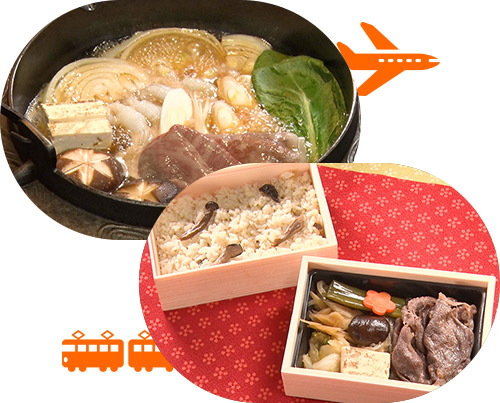
- BENTO TOPICS
- from Episode 20/ Season 7.
- Kobe
-

Bento Topics. Today from the port city of Kobe in Hyogo Prefecture. Kobe was one of the first ports to open up to foreign trade in the late 19th century. The city developed under the strong influence of Western culture.
-
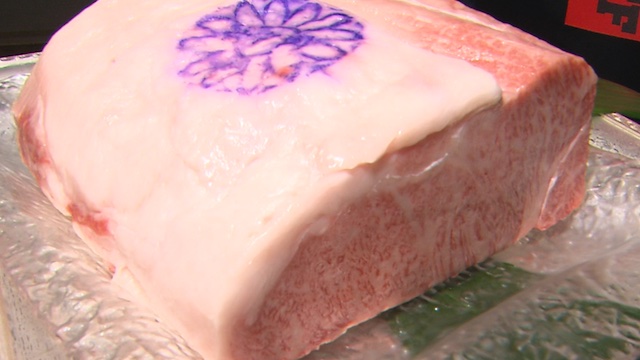
From Kobe, the custom of eating beef spread throughout Japan. Carefully selected from cattle raised in Hyogo Prefecture, only the highest quality beef is certified as Kobe beef. Tender and sweet, Kobe beef is recognized as one of the world’s premium beef brands.
-
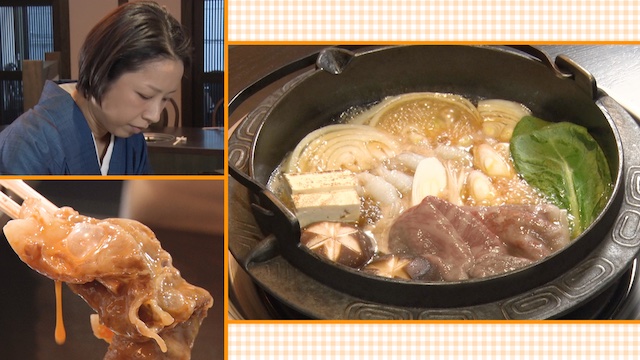
This beef restaurant has been in business for over 60 years. Its signature dish is sukiyaki. Paper-thin slices of beef are seared in an iron pot and simmered in soy sauce, sugar, mirin, and sake. The meat is typically dipped in beaten egg.
-
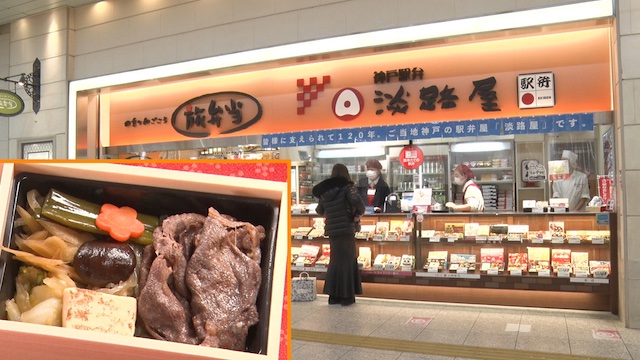
Kobe offers a specialty ekiben, or station bento, that features a variation of sukiyaki packed with beef and vegetables.
-
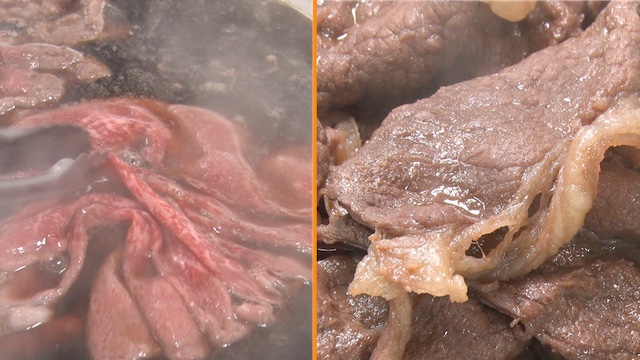
To bring out the flavor of Kobe beef, the seasoning is not as sweet as traditional sukiyaki.
It takes experience to know how to cook the beef so that it tastes good even when cold. It’s crucial not to overcook and lose the umami. -
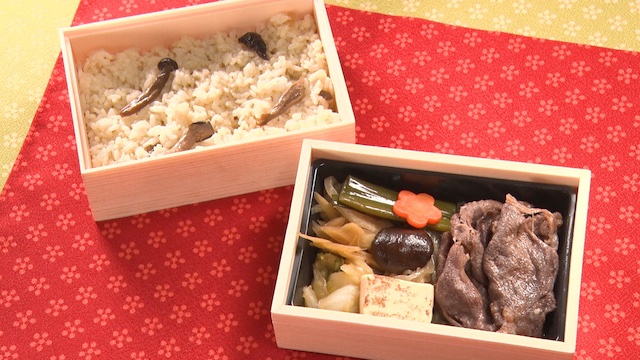
The aromatic mushroom rice is cooked in chicken stock. It highlights the flavor of the tender beef.
Sukiyaki made with the finest Kobe beef, coupled with mushroom rice. What a feast!
-
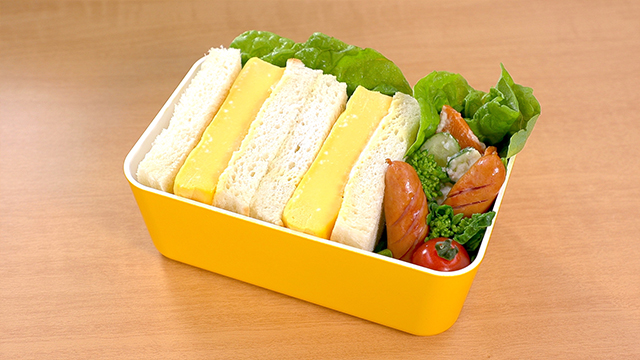
- BENTO RECIPES
- from Episode 19 / Season 7.
- Dashimaki Egg Sandwich Bento
- (856 kcal)
-
 by Marc Matsumoto
by Marc Matsumoto
Bento contents:
- Dashimaki Egg Sandwich
- Sanchu lettuce
- Nanohana
- Schau Essen sausages
- Small cherry tomatoes
- Potato salad
Ingredients:
Makes enough to pack into 1 bento
- 2 tsp potato starch
- 1/4 tsp salt
- 100 ml dashi
- 3 eggs
- 1 tbsp mayonnaise
- 1 tsp Japanese hot mustard
- 1 tsp honey
Directions:
1. Line the container you plan to make the egg in with plastic wrap to keep the egg from sticking.
2. Add the potato starch, salt, and dashi to a bowl and whisk together with chopsticks to dissolve the salt.
3. Add the eggs to the dashi mixture and beat together with chopsticks until the mixture is smooth. Pour it into the mold and place it in the center of a microwave oven.
4. Cook the egg at 600 watts for 2 minutes or until it starts to puff a little around the edges. Stop the microwave and scramble the eggs with chopsticks, breaking up any big curds.
5. Continue to cook the egg for another 30 seconds or until the edges start to puff and scramble again.
6. Finally, cook the egg for another 1 minute or until the egg is fully set. Cover the egg so it does not dry out, and let it cool to room temperature.
7. Mix the mayonnaise, mustard, and honey in a small bowl to make the honey mustard sauce.
8. Once the egg has cooled to room temperature, assemble the sandwich by topping one slice of bread with the egg.
9. Spread the honey mustard on the other slice of bread and use it to sandwich the egg. Slice the sandwich in half to pack it into a bento box.
-
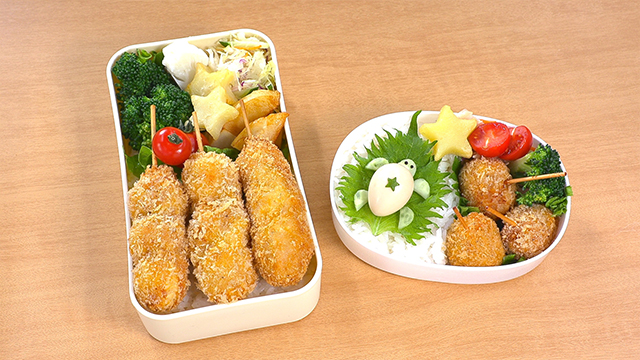
- BENTO RECIPES
- from Episode 19 / Season 7.
- Fried Meat-wrapped Quail Eggs Bento
- (For adults 975 kcal, For kids 457 kcal)
-
 by Maki Ogawa
by Maki Ogawa
Bento contents:
- Cooked rice(225 g for adults, 110 g for kids)
- Fried Meat-wrapped Quail Eggs
- (3 eggs per skewer for adults (x 3), 1 per skewer for kids (x 3)
- Broccoli
- Cauliflower
- Fried potato wedges
- Cherry tomatoes
- Lettuce
- Coleslaw
- Shiso leaf (for kids)
- Turtle decoration (for kids)
Ingredients:
For Fried Meat-wrapped Quail Eggs
(3 skewers for adults, 3 mini skewers for kids)
- 12 boiled quail eggs
- 6 slices pork loin (thinly sliced)
- A pinch each of salt and pepper
- Vegetable oil for frying
- Batter
- Beaten egg
- Panko breadcrumbs
- Flour
For the turtle decoration
- 1 boiled quail egg
- Mentsuyu
- Cucumber
- Nori
Directions:
For Fried Meat-wrapped Quail Eggs
1. Drain the boiled quail eggs and pat dry. Thread three eggs onto a skewer for adults, and make three skewers. For kids, thread one egg onto a toothpick, and make three mini skewers.
2. Wrap the skewers with sliced pork.
3. Sprinkle with salt and pepper, dust with flour, then dip in beaten egg and bread.
4. Heat the oil to 170 degrees C and deep-fry for about two minutes.
For the turtle decoration
1. Soak the quail egg in mentsuyu for at least 15 minutes.
2. Cut a 3 mm slice from a cucumber.
3. Use a U-shaped cookie cutter for the turtle parts.
For the head: cut out a piece of cucumber so that it will align with the curve of the egg.
4. For the four flippers: cut out two U-shapes and cut diagonally in half.
5. Set out the turtle parts and place the egg on top.
6. Use nori for the eyes and cut out a star-shape from cucumber peel to place on top of the egg to complete the turtle shell.
-
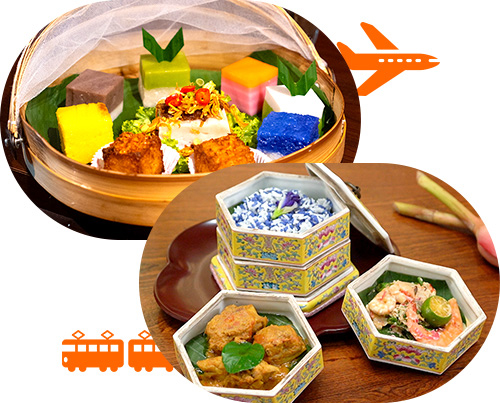
- BENTO TOPICS
- from Episode 19/ Season 7.
- Malaysia
-

Bento Topics. Today, from the Malaysian island of Penang. These colorful houses, lined up in a row, symbolize Penang’s diverse cultural heritage. These houses are in the Peranakan style—a term used for the distinct mixture of Chinese, Malay, and Western cultures.
-
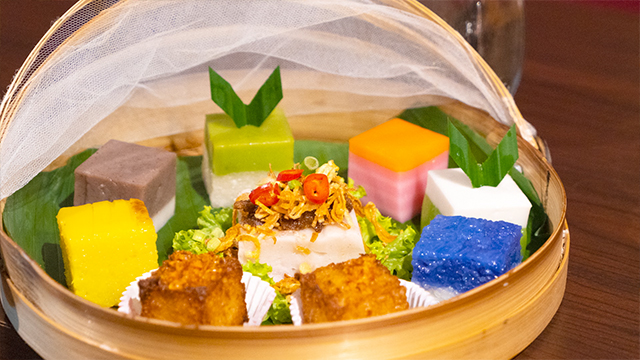
Colorful steamed pastries called Nyonya kuih showcase the intricate and colorful designs that are a hallmark of Peranakan culture and its Nyonya cuisine. Made with natural ingredients like corn and butterfly peas, they’ve grown popular even outside of Malaysia.
-

Bento maker Tarina is passing on the Peranakan culture by teaching Nyonya cuisine. She’s come to the market to buy the ingredients she’ll need to make a bento packed with Nyonya-style dishes.
-
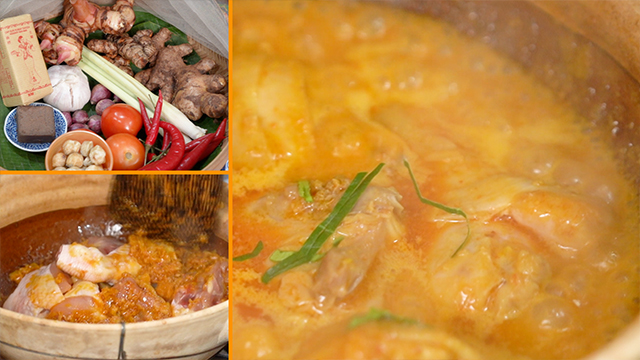
Kari kapitan is a Nyonya-style chicken curry featuring a complex blend of nine spices, as well as tomatoes and coconut milk. Rich, creamy, fresh, and flavorful, Nyonya cuisine is a feast of color and flavors.
-
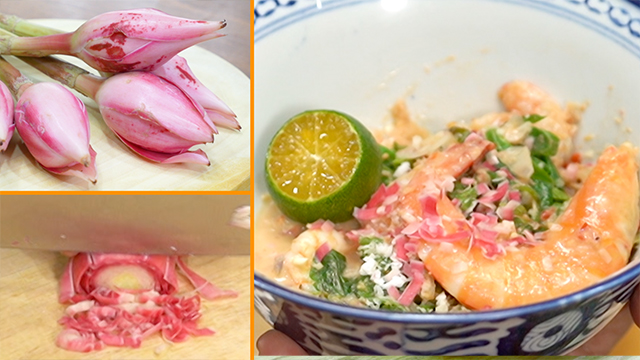
Tarina prepares a salad which features a sweet wild fern dressed in a coconut milk and shrimp dressing. She tops the salad with fragrant torch ginger flowers, an essential ingredient in Nyonya cuisine.
-
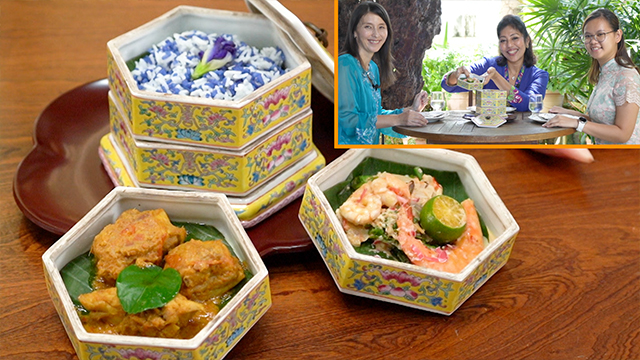
Tarina uses a traditional Peranakan bento box made more than 200 years ago. Each tier holds a different food: chicken curry, colorful salad, and rice colored with butterfly pea flowers. Tarina’s bento looks like a jewelry box. She invites her friends for lunch!
-
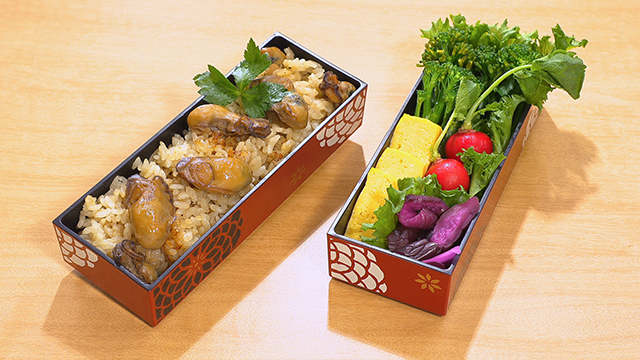
- BENTO RECIPES
- from Episode 18 / Season 7.
- Oyster Rice Bento
- (403 kcal)
-
 by Marc Matsumoto
by Marc Matsumoto
Bento contents:
- Oyster Rice
- Frill lettuce
- Tamagoyaki
- Radishes with leaves
- Stick broccoli
- Shibazuke
- Mitsuba
Ingredients:
Makes enough to pack into 2 bentos
- 240 g small shucked oysters
- 1 tsp baking soda
- 15 g ginger, sliced thinly
- 60 ml sake
- 3 tbsp soy sauce
- 2 tbsp mirin
- 310 g Japanese short-grain rice
- Water
Directions:
1. Add the oysters and baking soda to a bowl. Mix well by hand until the oysters have released a significant amount of grey liquid. Rinse and drain multiple times until the water runs clear. Drain well.
2. Add the sliced ginger, sake, soy sauce, and mirin to a pot and boil. Continue to cook until the mixture no longer smells like alcohol (another minute or so).
3. Add the oysters to the pot and bring them to a boil. Skim off any foam that floats to the surface, leaving behind as much liquid as possible. Once you've removed most of the foam, turn down the heat to maintain a simmer and cook the oysters for 8 minutes.
4. Let the oysters cool to room temperature in the liquid.
5. Add the rice to a strainer and wash while agitating by hand until the water runs mostly clear. Drain well and add it to a pot.
6. Once the oysters have cooled to room temperature, remove and discard the ginger slices. Strain the oysters over a bowl, reserving the braising liquid.
7. Pour the braising liquid into a large liquid measuring cup. Add water, so you have 415 milliliters (1 3/4 US cups) of liquid, and pour this into the pot with the rice.
8. Cover the pot with a lid and bring the mixture to a boil or until you see a steady stream of steam escaping from the lid. Turn down the heat all the way, and set a timer for 12 minutes.
9. When the timer goes off, turn off the heat and let the rice steam for another 10 minutes without opening the lid.
10. When the rice is steamed, fluff it with a rice paddle and top it with the reserved oysters.
-
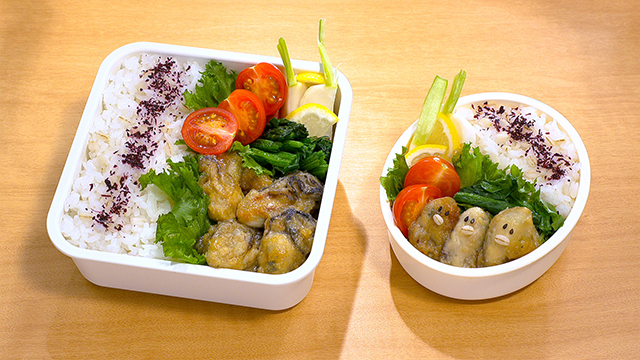
- BENTO RECIPES
- from Episode 18 / Season 7.
- Miso-butter Oyster Bento
- (For adults 561 kcal, For kids 297 kcal)
-
 by Maki Ogawa
by Maki Ogawa
Bento contents:
- Miso-butter Oysters
- Barley rice (cooked—240 g for adults, 120 g for kids)
- Cherry tomatoes
- Boiled spinach
- Japanese turnips pickled in salt and lemon
- Lettuce
- Furikake rice seasoning
- Baby chick decoration (for kids)
Ingredients:
For Miso-butter Oysters(serves 2-3)
- 20 oysters for cooking (approx. 260 g)
- 15 g miso
- 10 g unsalted peanut butter
- 10 g sugar
- 30 g sake
- 15 g butter
- 3 tbsp potato starch (for rinsing the oysters)
- Additional potato starch for dredging the oysters, as needed
For the baby chick decoration
- Black sesame seeds
- Cooked barley (from the barley rice)
Directions:
For Miso-butter Oysters
1. Place the oysters in a bowl, sprinkle with 3 tbsp potato starch, and rub gently about 10 times.
2. Rinse under running water to remove the potato starch and impurities.
3. Pat dry with paper towels.
4. Add the miso, peanut butter, sugar, and sake to a small bowl and whip until fully incorporated.
5. Sprinkle potato starch over a tray to coat the oysters.
6. Heat a frying pan over low heat and melt the butter. Add the oysters before the butter starts to brown and cook each side for 1 minute and a half, or a total of 3 and half to 4 minutes.
7. Add the miso sauce and simmer for 10 to 20 seconds.
For the baby chick decorations:
Use barley and sesame seeds to make the oysters look like baby chicks.
-
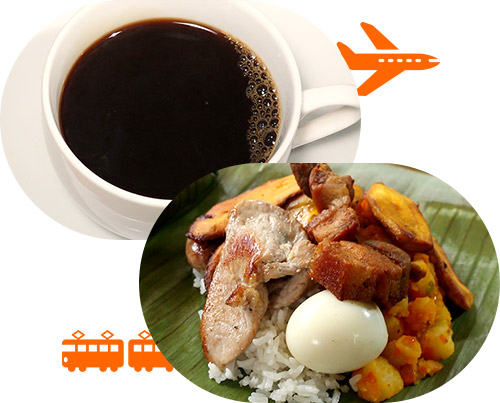
- BENTO TOPICS
- from Episode 18/ Season 7.
- Colombia
-

Today, from the South American country of Colombia, one of the world’s leading producers of coffee.
-
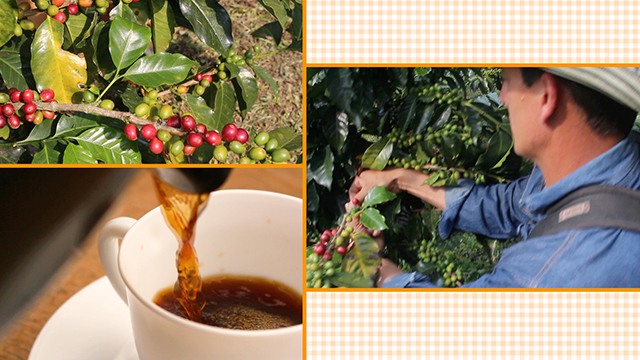
Columbia’s climate is ideal for producing premium-grade coffee. Coffee beans thrive in places with marked differences in daytime and nighttime temperatures as well as a good balance of wet and dry periods. A secret to good coffee is to pick the beans by hand to avoid breaking the branches.
-
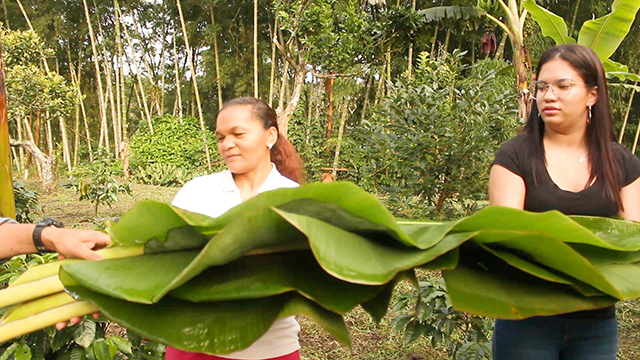
Plantain trees with distinctive giant leaves protect the coffee trees from excessive sunlight. Both the fruit and the leaves are essential to making traditional Colombian bentos. Omaira and her daughter, Ámbar, will show us how to make the bentos they serve at the coffee plantation.
-
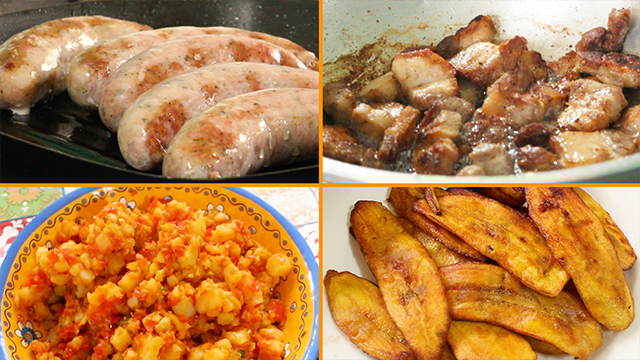
Toasted plantain leaves are used to wrap various dishes to make “fiambre,” a traditional meal commonly eaten by people who work outdoors. Today's fiambre includes fried plantains, chorizo sausages, pork chops, deep-fried pork belly, and a stewed vegetables fragrant with cumin.
-
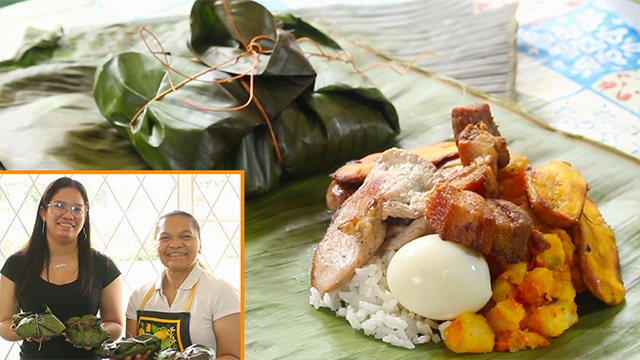
They heap the rice onto the toasted plantain leaf and cover it with the five dishes, plus a boiled egg, before wrapping.
Using natural resources close at hand as a sustainable container reflects the wisdom of the past.
They deliver the fiambre to the farm workers. -
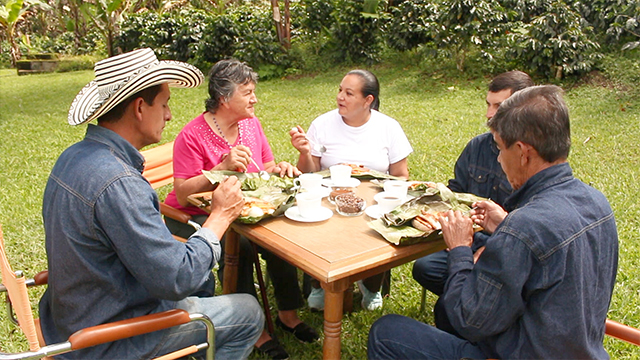
They’ve all worked up a hefty appetite and dig into the fiambre. They enjoy their meal with a cup of coffee made with the fruits of their labor. A perfect pairing.
-
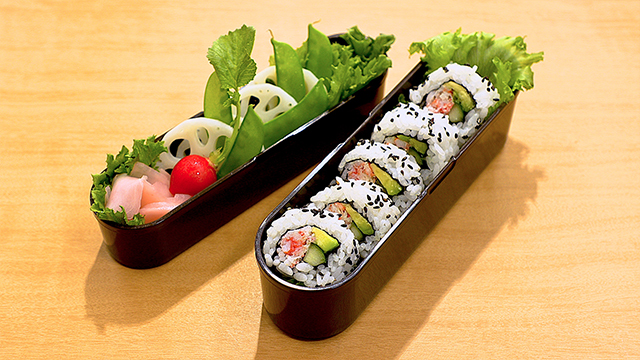
- BENTO RECIPES
- from Episode 17 / Season 7.
- California Roll Bento
- (337 kcal)
-
 by Marc Matsumoto
by Marc Matsumoto
Bento contents:
- California Roll
- Renkon (lotus root) & sugar peas
- Radish
- Gari
- Frill lettuce
Ingredients:
Makes enough to pack into 4 bentos
- 4 tbsp rice vinegar
- 3 tbsp sugar
- 1 tsp salt
- 700 g cooked Japanese short-grain rice (2 rice cooker cups)
- 120 g crab meat
- 70 g cucumber
- 1 avocado
- 1 tbsp black sesame seeds
- 2 full sheets nori
Directions:
1. To make the sushi rice, cook the rice with 2 tablespoons less water than you would typically use to make the rice.
2. To make the sushi vinegar, whisk together the rice vinegar, sugar, and salt until everything is dissolved.
3. Once the rice is cooked, dump it into a large bowl and pour the sushi vinegar over it.
4. Mix the vinegar into the rice using a folding and cutting motion to break up any clumps of rice. Be careful not to mash the individual grains of rice. Use a fan to cool the rice as you mix it. When the rice is done, cover it with a damp towel.
5. Trim the ends off of the cucumber and slice it in half lengthwise. Save half of the cucumber to use in another dish. Cut the remaining half in half again lengthwise (into 2 quarters). Slice the seeds out of the center of the cucumber and cut each strip of cucumber in half lengthwise.
6. Cut the avocado in half and remove the pit. Peel each half of the avocado. Slice each half of the avocado into 6-8 wedges.
7. Fold the nori in half across the narrow side, and tear it in half.
8. Place a sheet of nori on top of a sushi mat and spread a handful of sushi rice (about 170 g) across the top edge.
9. Wet your hands and press the rice to spread it down towards the bottom edge until the nori is covered in an even layer of rice.
10. Sprinkle some black sesame seeds on top of the rice in an even layer.
11. Flip the rice and nori over and spread 30 grams of crab meat along the bottom edge of the nori. Add a cucumber stick in front of the crab, and then top with 3-4 wedges of avocado.
12. Use the sushi mat to roll the bottom edge of the nori up and over the fillings to make it meet the nori on the other side.
13. Continue rolling until the seam is at the bottom, and then use the sushi mat to compress the roll and finalize its shape.
-
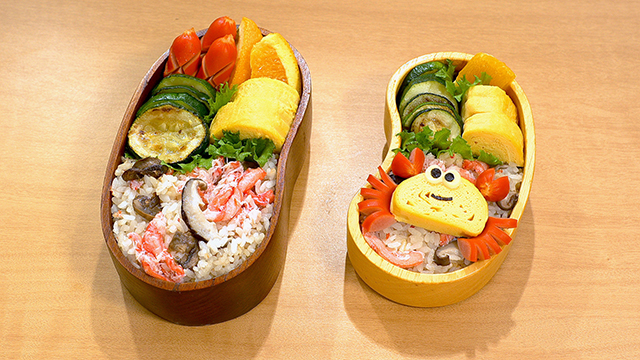
- BENTO RECIPES
- from Episode 17 / Season 7.
- Crab Rice Bento
- (For adults 423 kcal, For kids 248 kcal)
-
 by Maki Ogawa
by Maki Ogawa
Bento contents:
- Rice (230 g for adults, 100 g for kids)
- Crab rice
- Sauteed zucchini
- Tamagoyaki rolled omelet
- Red sausages
- Lettuce
- Orange wedges
- Crab decoration (for kids)
Ingredients:
For Crab Rice(yields 2 rice cups)
- 2 rice cups (360 g) rice
- 150 g crab meat
- 70 g mushrooms (1 shiitake, 4 brown mushrooms)
- 1 1/2 tsp salt
- 1 tbsp sake
- 1/2 tsp soy sauce
- 2 g sugar
For crab decoration
- Sausage
- Nori
- Cheese
Directions:
For Crab Rice
Prep: Cut the mushrooms into thin slices and freeze overnight.
1. Rinse the rice and soak in water for 30 minutes.
2. Add the rice, sake, soy sauce, salt, and sugar to the rice cooker. Pour water up to the 2-cup level marking for white rice on the inner bowl.
3. Add the frozen mushrooms and 75 g crab meat and press the start button to cook.
4. Add the remaining 75 g of crab meat to the cooked rice and let it steam for 10-15 min.
5. Mix and fluff the rice.
For the crab decoration
1. Make crisscross incisions along the sausage and boil for 30 seconds.
2. Cut the sausage into 3 sections.
3. Cut the middle section horizontally in half.
4. Make an incision in the tip of each end section, and 3-4 incisions in the two halves of the middle section. Boil for 30 seconds.
5. Use a round cookie cutter to cut out two pieces from a slice of cheese. Use nori for the eyes and mouth.
6. Place the sausages around the tamagoyaki to form the crab shape and decorate with the cheese and nori.
- Shimane Special
- from Episode 17/ Season 7.
-
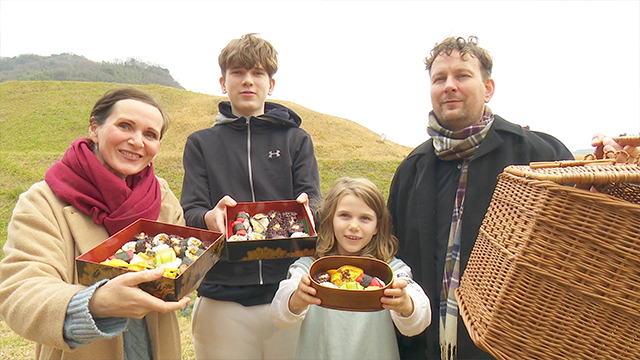
Shimane is home to about 9,000 foreign residents, some of whom are avid bento makers. Anja lives in Matsue, Shimane's largest city. She came to Japan seven years ago because of her husband's work. A few years ago, she opened a restaurant to promote vegan cuisine in Matsue. Her restaurant offers a variation of German and Japanese cuisine. Both her family and her regular customers adore her food.
-
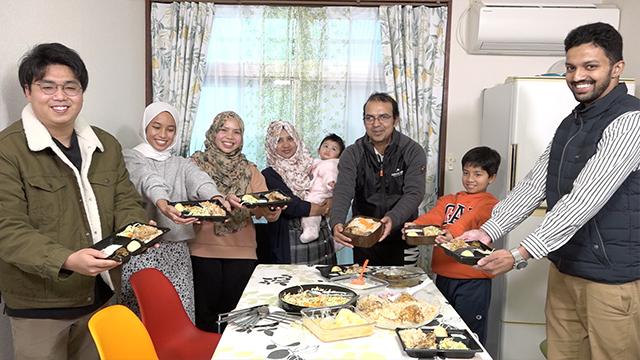
Dr. Riaz, a professor at Matsue’s Shimane University, is from Bangladesh. He and his wife Nazma host a meal for colleagues and exchange students at their home. They prepare an assortment of dishes made with halal ingredients. But that's not all: everyone also gets to pack a bento to take home to enjoy later. The students just love getting a taste of home.
-
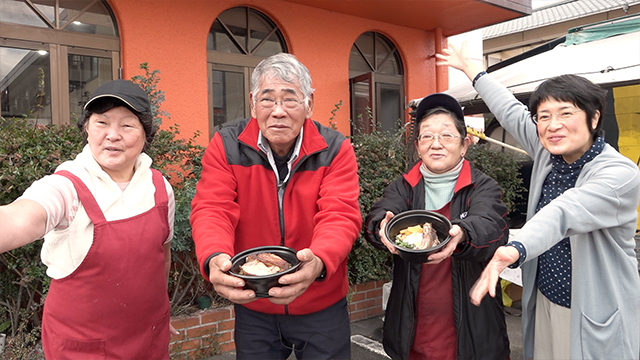
Izumo is the second largest city in Shimane after Matsue. Sergio, a second-generation Japanese-Brazilian, is the owner of a Brazilian restaurant that has become a home away from home for Brazilians in Japan. Sergio moved to Japan with his family about three decades ago, ago and opened his restaurant seven years ago. Four years ago, he started a farm with his friends to grow cassava, a vegetable that he wants to popularize in Japan.
-
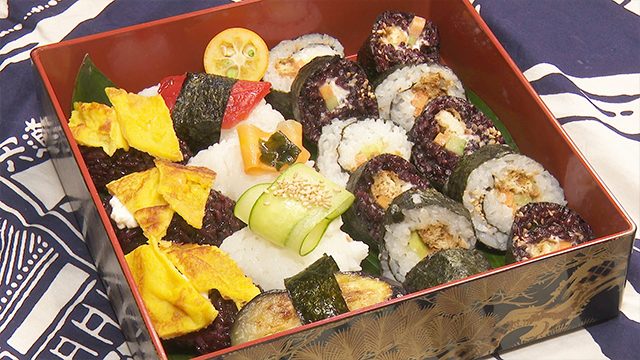
Anja prepares a vegan sushi bento for a family picnic. She wraps black rice in thinly sliced fried tofu to make a vegan sushi roll. She prepares a sushi topping of grilled bell peppers marinated in kombu that look just like tuna. She also prepares sushi topped with a rolled omelet made with an egg substitute: chickpeas and tofu. A medley of vegan treats that taste as good as they look.
-
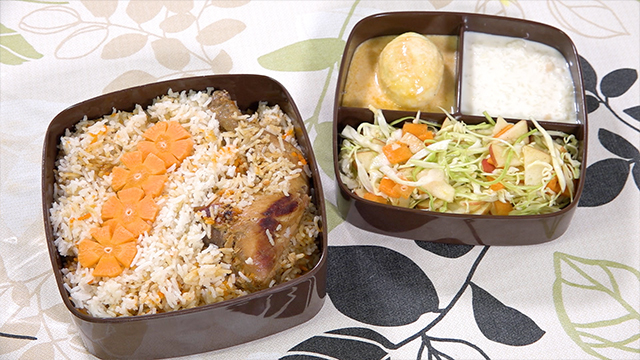
The main dish is chicken biryani, a dish of spicy chicken and rice. It's popular throughout South and Southeast Asia. Chicken marinated in yogurt is simmered in a paste made with garlic, ginger, chili, and other spices. On the side, eggs simmered in curry and milk.
For dessert: sweet rice pudding. Everyone enjoys the delicious meal. Dr. Riaz says that his bentos help bring people together, transcending boundaries. -
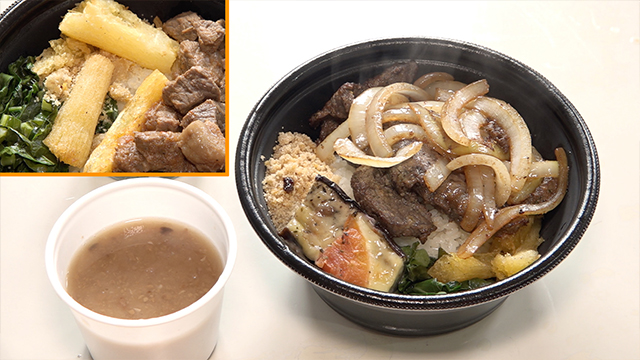
Sergio’s restaurant prepares made-to-order bentos. The most popular bento, beefsteak with fried onions, always includes a bowl of savory bean stew seasoned with garlic. Fried cassava chips are another popular choice. These chips have even made their way into the local school lunch program! Sergio’s cuisine reflects his passion to serve as a bridge between the Brazilian and Japanese communities.
-
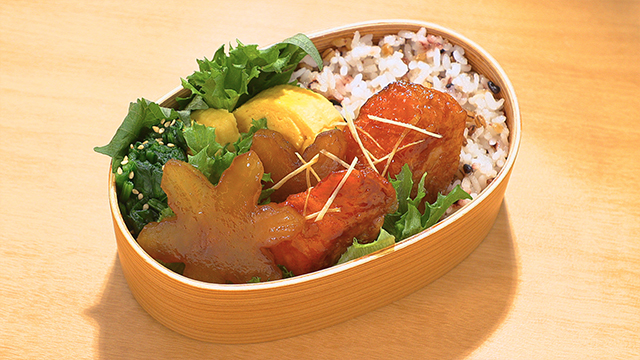
- BENTO RECIPES
- from Episode 16 / Season 7.
- Salmon Daikon Bento
- (560 kcal)
-
 by Marc Matsumoto
by Marc Matsumoto
Bento contents:
- Salmon Daikon
- 16-grain rice
- Frill lettuce
- Tamagoyaki
- Spinach furikake-ae
Ingredients:
Makes enough to pack into 2 bentos
- 370 g daikon, peeled and cut into 1 cm thick rounds
- 1/2 tsp salt
- 190 g boneless skinless salmon filets
- 1 tbsp potato starch
- 1 tbsp vegetable oil
- 2 cups (473 ml) dashi stock
- 3 tbsp 3S sauce (equal parts soy sauce, sake, sugar)
- Ginger, peeled and sliced into thin threads
Directions:
1. Bring the dashi and salt to a boil in a wide saucepan or frying pan. Add the daikon slices and cover with a drop lid. Reduce the heat to maintain a gentle simmer.
2. Cook the daikon for 10 minutes or until a toothpick can be passed through. The daikon should still be a little firm.
3. Turn off the heat and let the daikon cool to room temperature in the dashi. It's best to let the daikon rest overnight in the fridge while soaking in the dashi, but if you're pressed for time, you can continue.
4. If you would like to use cookie cutters to cut the daikon into shapes, you can do that now, but reserve the dashi for later.
5. Dust the salmon with potato starch.
6. Heat a frying pan over medium-high heat, and then add the vegetable oil and starch-coated salmon. Pan fry until browned on one side, then flip and brown the other side.
7. Remove the salmon from the pan and use paper towels to soak up as much of the oil from the pan as possible.
8. Add the 3S sauce and 2 tablespoons of the dashi from the daikon. Bring the mixture to a boil and reduce the sauce until it is thick and syrupy.
9. Add the daikon to the sauce and flip each piece repeatedly until glazed. Remove from the pan and add the salmon. Then, glaze with the remaining sauce.
10. Garnish with ginger threads.
-
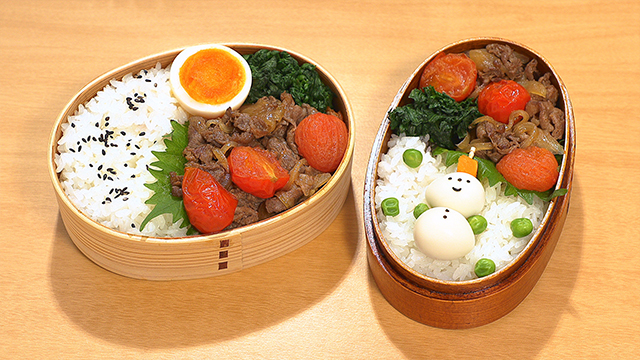
- BENTO RECIPES
- from Episode 16 / Season 7.
- Tomato Sukiyaki Bento
- (For adults 680 kcal, For kids 395 kcal)
-
 by Maki Ogawa
by Maki Ogawa
Bento contents:
- Rice (240 g for adults, 120 g for kids)
- Tomato Sukiyaki
- Shiso leaves
- Boiled shungiku chrysanthemum leaves
- Hard-boiled egg(for adults)
- Black sesame seeds(for adults)
- Snowman decoration(for kids)
Ingredients:
For Tomato Sukiyaki:
Makes enough to pack into 2-3 bentos
- 5-6 cherry tomatoes (70-80 g)
- 180 g thinly sliced beef trimmings
- 80 g onion
- 1.5 tbsp sugar
- 1.5 tbsp soy sauce
- 1 tbsp sake
For the snowman decoration
- Quail eggs
- Carrot
- Green peas
Directions:
For Tomato Sukiyaki
1. Cut the cherry tomatoes in half.
2. Cut the onion into thin slices.
3. Preheat and oil the pan, then stir-fry the beef.
4. Once the beef is browned, add the onions.
5. Stir-fry until the onions are wilted, then add the tomatoes.
6. Give it a light stir and add the sugar, soy sauce, and sake. Bring to a boil, then reduce the heat to medium-low and simmer for 4 minutes.
For the snowman decoration
1. Skewer a couple of quail eggs and a piece of boiled carrot from a bag of frozen mixed vegetables.
2. Use nori for the eyes, nose, and mouth.
3. To form the arms, place two green peas, also from the bag of mixed vegetables, by the eggs.
-
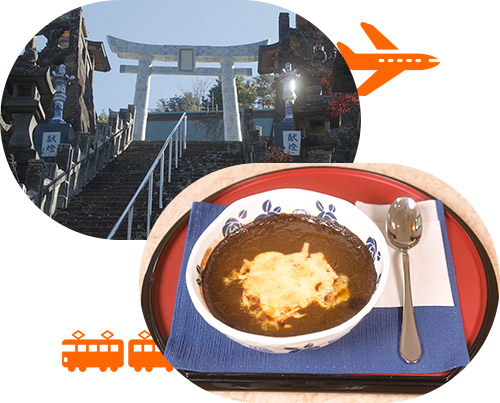
- BENTO TOPICS
- from Episode 16/ Season 7.
- Arita
-

Today, from one of Japan’s most famous pottery towns: Arita, in Saga Prefecture.
The town’s heritage is reflected in its unique porcelain shrine gate, as welll as streets lined with walls built with scraps from the kilns. -
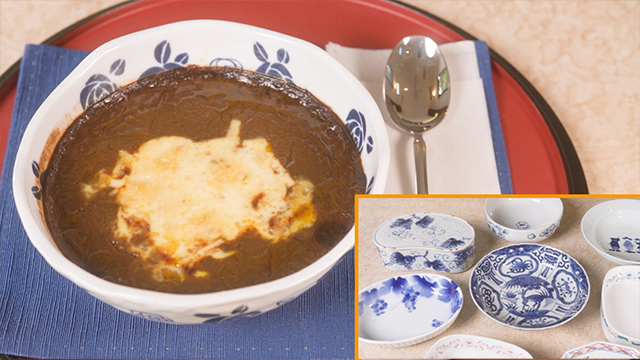
Arita ware, fired at temperatures of over 1,200 degrees Celsius, is heat-resistant. That makes it it ideal for the local station’s specialty bento, or ekiben, which features curry on rice—baked in Arita bowls! Customers get to keep the bowl their bento comes in. With a variety of designs, it sells over 100,000 units annually.
-
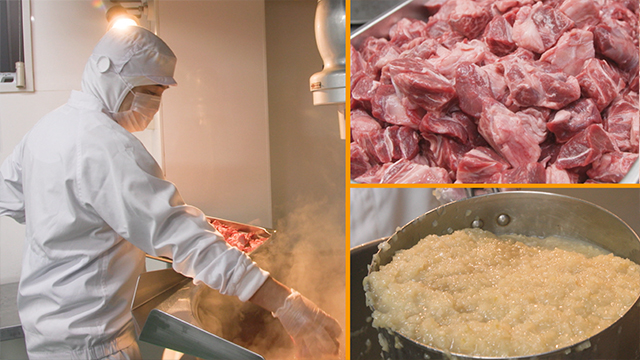
The curry is made with premium grade Saga beef, onions, and other ingredients from local farms. The rich beef and sweet onions make a rich curry base.
-
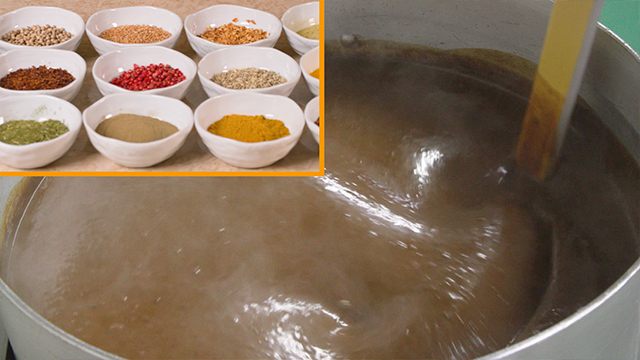
After adding an original blend of 28 spices and roux to thicken the sauce, the curry is simmered for a week until the beef is tender enough to melt.
-
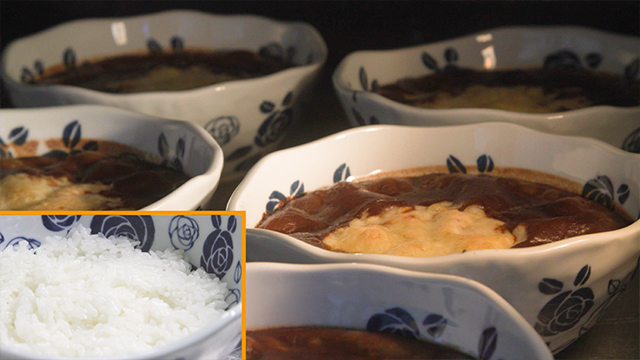
The rich curry is poured over local rice in an Arita ware bowl. It’s then topped with cheese and baked in an oven until it’s done.
-
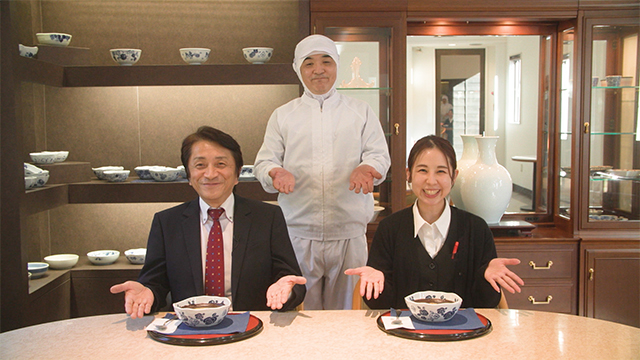
The heat-resistant Arita ware bowls are perfect for the baked cheese curry bento.
-
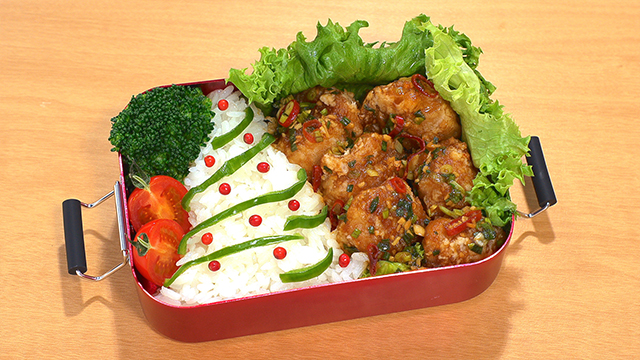
- BENTO RECIPES
- from Episode 15 / Season 7.
- Kara-age with Tangy Scallion Sauce Bento
- (865 kcal)
-
 by Marc Matsumoto
by Marc Matsumoto
Bento contents:
- Kara-age with Tangy Scallion Sauce
- Rice
- Broccoli
- Cherry tomatoes
- Frill lettuce
- Green pepper, sliced into rings and salted
- Pink peppercorns
Ingredients:
Makes enough to pack into 2 bentos
For chicken
- 310 g chicken thighs, cut into bite-sized pieces
- 1 tbsp sake
- 1 tsp soy sauce
- 2 tsp potato starch + more for dusting
For sauce
- 25 g scallions, finely chopped
- 10 g ginger, minced
- 1-2 dried red chili peppers, with seeds removed and cut into rounds
- 1 1/2 tbsp soy sauce
- 1 tbsp rice vinegar
- 1 tbsp sugar
- 1 tsp toasted sesame oil
Directions:
1. Add the chicken thighs, sake, soy sauce, and potato starch into a bowl and mix together. Let this marinate for at least 30 minutes or up to overnight.
2. Preheat a pot of oil to 170 degrees C (340 degrees F) and prepare a wire rack lined with 3 sheets of paper towels.
3. Add a few tablespoons of potato starch into a bowl and use it to dust the marinated chicken in a thick, even layer of starch.
4. Add all sauce ingredients to a bowl and mix until the sugar has dissolved.
5. Fry the chicken until golden brown and cooked through (you can cut a big one in half to check). Transfer the chicken to the rack to drain.
6. While the chicken is still hot, toss the pieces in the sauce to coat, then immediately transfer them out of the sauce to cool.
7. Once the chicken has cooled to room temperature, pack it into a bento box and top it with scallions and chili peppers from the sauce.
-
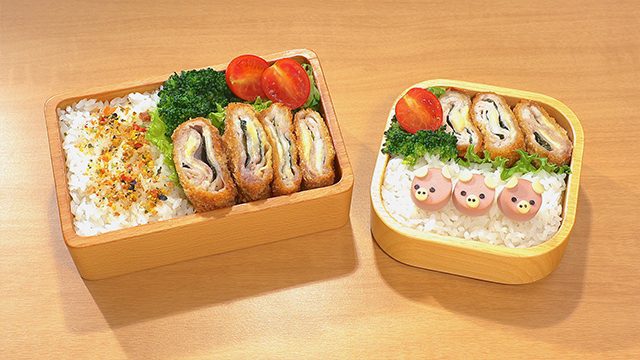
- BENTO RECIPES
- from Episode 15 / Season 7.
- Layered Katsu Bento
- (For adults 863 kcal, For kids 465 kcal)
-
 by Maki Ogawa
by Maki Ogawa
Bento contents:
- Rice (220g g for adults, 110 g for kids)
- Layered Katsu
- Broccoli
- Boiled cabbage
- Cherry tomatoes
- Lettuce
- Furikake rice seasoning (for adults)
- Three Little Piggies decoration (for kids)
Ingredients:
For Layered Katsu
(Yields 2)
- 10 slices thinly sliced pork loin (20 g per slice)
- 1 slice cheese
- 4-6 sweet basil leaves
- A pinch each of salt and pepper
- Vegetable oil for deep frying, as needed
- Batter
- Flour
- Panko breadcrumbs
- Egg
For the Three Little Piggies decoration
- Fish sausage
- Cheese
- Nori
Directions:
For Layered Katsu
1. Sprinkle salt and pepper on both sides of the sliced pork.
2. Cut the sliced cheese into 4 equal pieces.
3. Place a piece of cheese and a sweet basil leaf on a slice of pork.
4. Cover with another slice of pork, cheese, and a basil leaf. Repeat two more times to form four layers, and cover with a final slice of pork. (Each layered katsu uses five slices of pork. Choose relatively larger slices for the top and bottom.)
5. Tuck in the edges to keep the cheese from oozing out when fried, and wrap in plastic film to seal. (If possible, cool in the fridge for 10 minutes.)
6. Bread with flour, beaten egg, and panko. Fry for about 4 minutes in oil heated to 160 degrees C.
For the Three Little Piggies decoration
1. Cut the fish sausage into rounds.
2. Lightly brown both sides over low heat in an oiled pan.
3. Use a round cookie cutter to cut out 6 pieces from a slice of cheese (two pieces per pig).
4. Cut three of the cheese rounds in half for the ears. The remaining rounds are for the nose.
5. Place the cheese parts on the sliced fish sausage.
6. Use nori to form the eyes, nose, and mouth.
-
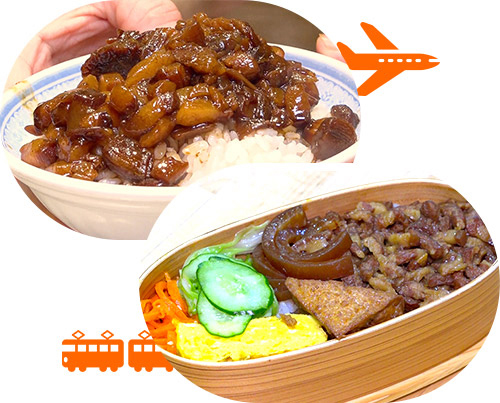
- BENTO TOPICS
- from Episode 15/ Season 7.
- Taiwan
-
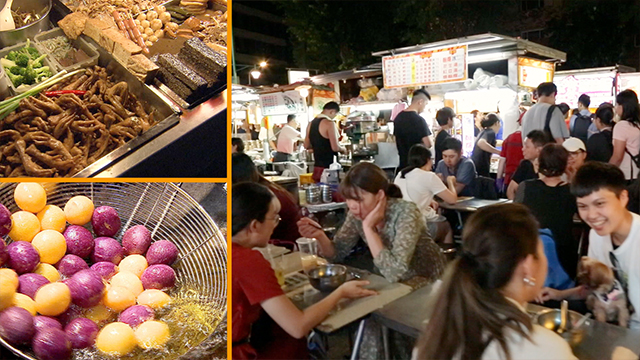
Today, from Taiwan. Night markets offer an array of Taiwanese delicacies. Everything is mouth-wateringly good.
-
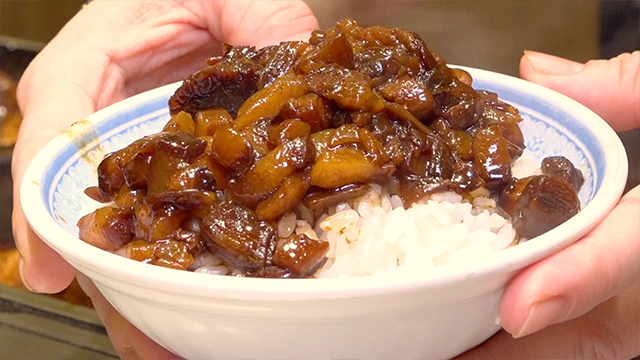
Taiwan’s ultimate comfort food is Lu Rou Fan: sweet and savory braised pork served over rice. It’s an all-time favorite in Taiwan. One Taipei restaurant is famous for its Lu Rou Fan.
-
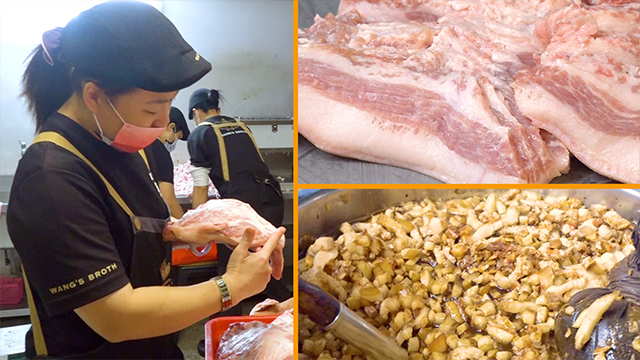
It uses pork jowls for its Lu Rou Fan. The combination of lean meat and rich fat makes it extra tasty. The jowls are simmered in a soy sauce-based soup with fried shallots, white pepper, and sugar. After hours of simmering, the melt-in-your-mouth Lu Rou Fan is done. Pour the rich meat and sauce over a bowl of rice, and it’s time to dig in.
-
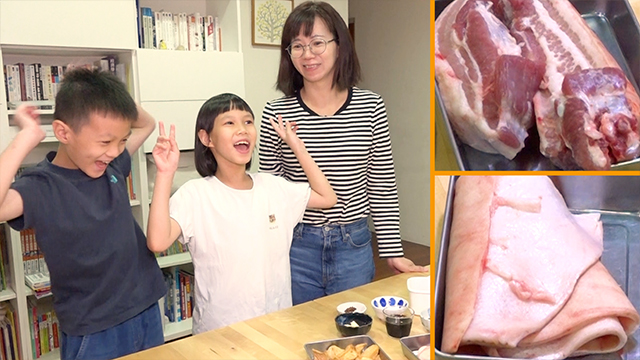
Bento maker Kaori makes a Lu Rou Fan bento with the help of her children, Ning and John. Her secret is to use pork belly and pork skin.
-
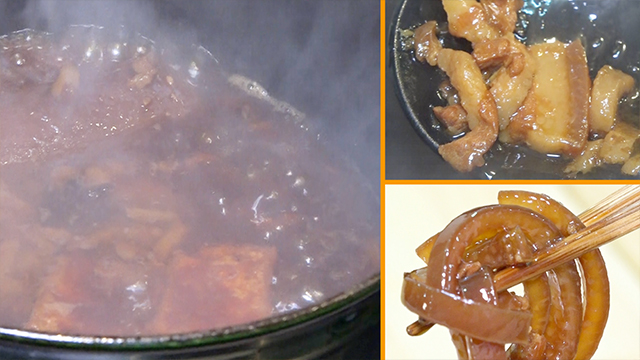
She uses star anise and coconut sugar to make a sweet and savory sauce in which she simmers the pork belly and skin. Pork skin is rich in collagen, so the sauce has a wobbly texture. The skin is full of flavor and is tender enough to melt in your mouth. No wonder the kids love it!
-
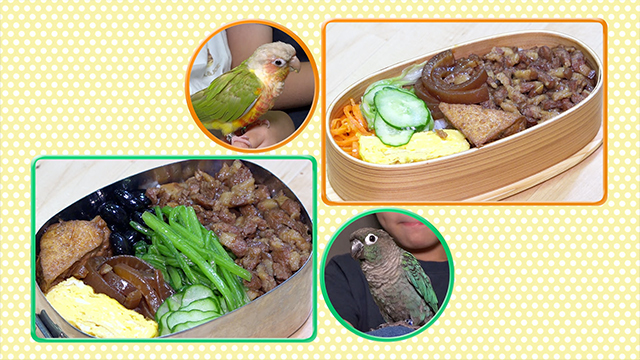
Ning and John help arranging the Lu Rou Fan and vegetables on rice. By using different colors, they create two different bentos in the same color scheme as their pet parakeets!
-
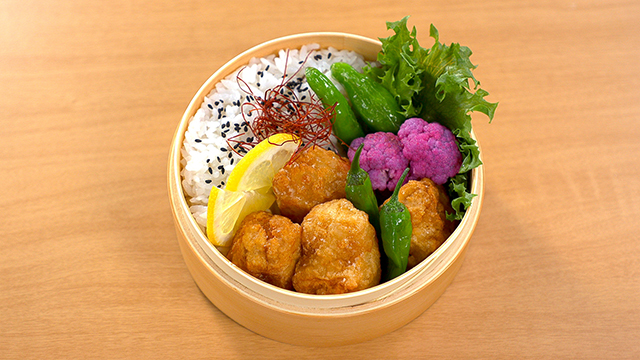
- BENTO RECIPES
- from Episode 14 / Season 7.
- Tofu Kara-age Bento
- (585 kcal)
-
 by Marc Matsumoto
by Marc Matsumoto
Bento contents:
- Tofu Kara-age
- Rice
- Black sesame
- Thread chili peppers
- Lemon
- Fried shishito peppers
- Purple cauliflower blanched and pickled in sushi vinegar
- Frill lettuce
Ingredients:
Makes enough to pack into 2 bentos
- 1 block tofu
- 2 tbsp sake
- 1 1/2 tbsp soy sauce
- 3 g grated garlic
- 3 g grated ginger
- 1/2 tsp kobucha, optional
- Potato starch, for frying
- Vegetable oil, for frying
Directions:
1. Set the tofu on a wire rack on a tray, then put another tray on top. Set a heavy weight (such as cans or a bottle of water) on top of the tray to press the tofu. Let drain for 1 hour.
2. To make the marinade, whisk the sake, soy sauce, garlic, ginger, and kobucha until combined.
3. When the tofu is done draining, wipe it dry with paper towels and then tear it into uneven pieces. Place the tofu chunks into the marinade and gently stir everything together. Marinate the tofu for 30 minutes, stirring occasionally.
4. When the tofu is done marinating, drain off any excess liquid and preheat a pot of oil to 170 degrees C (340 degrees F).
5. Roll the marinated tofu in a bowl of potato starch to coat evenly and lower the coated tofu into the oil.
6. Fry the tofu, occasionally flipping, until it just starts to brown. Remove the kara-age from the oil, then turn up the heat to 180 degrees C (355 degrees F).
7. Fry the tofu a second time until it is golden brown and crisp. Drain the tofu on a paper towel-lined rack and let cool completely before packing into your bento.
-
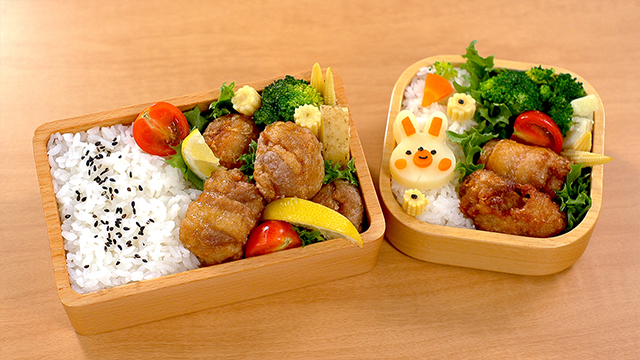
- BENTO RECIPES
- from Episode 14 / Season 7.
- Pork Belly Kara-age Bento
- (For adults 977 kcal, For kids 435 kcal)
-
 by Maki Ogawa
by Maki Ogawa
Bento contents:
- Cooked rice (170 g for adults, 85 g for kids)
- Pork Belly Kara-age
- Lemon wedges
- Cherry tomatoes
- Broccoli
- Sweet potato
- Young corn
- Bunny and Carrot decoration (for kids)
Ingredients:
For Pork Belly Kara-age (Serves 2)
- 4 thin slices (40 g each) pork belly
- 2 tbsp soy sauce
- 3 tbsp sake
- A pinch of grated ginger
- A pinch of grated garlic
- A dash of sesame oil
- Potato starch, as needed
- Vegetable oil for deep-frying, as needed
For the Bunny and Carrot decoration
- Cheese
- Boiled carrot
- Nori
Directions:
For Pork Belly Kara-age
1. Cut the pork belly in half.
2. Combine the seasonings in a bowl and marinate the pork belly for 5 minutes.
3. Pat dry with paper towels, then roll up into chunks.
4. Coat evenly with potato starch.
5. Heat the oil to 170 degrees C and place the rolled pork in the oil seam-side down.
*Leave them alone for about a minute to secure the seam.
6. After about 3 minutes, they’re done.
For the Bunny and Carrot decoration
1. Stack 2 slices of cheese and use a cookie cutter to cut out the bunny.
2. Cut a piece of carrot into 2 mm slices and boil for about 2 minutes. Cut out 2 rectangles and 3 circles to form the ears, nose, and cheeks.
3. Use nori for the eyes, nose, and mouth.
4. Cut a V-shape out of the remaining carrot to form the bunny’s carrot, and use broccoli for the carrot top.
-
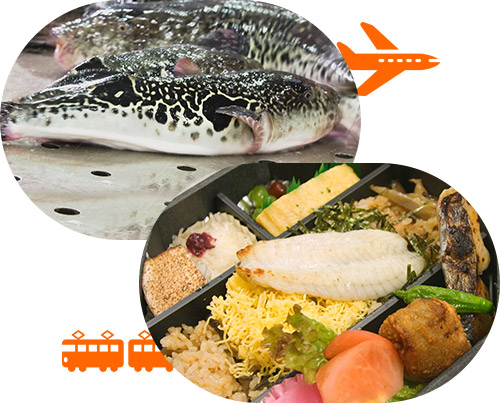
- BENTO TOPICS
- from Episode 14/ Season 7.
- Shimonoseki
-

Today, from one of the largest ports in western Japan: Shimonoseki in Yamaguchi Prefecture.
There are statues and decorations of fugu, or pufferfish, just about everywhere! -
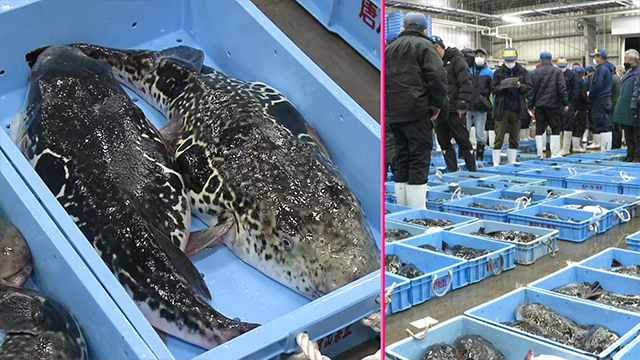
Shimonoseki has the only market in Japan specializing in fugu.
Over 1,500 tons of fugu are sold here each year.
Fugu can only be prepared by licensed professionals. That's because they're poisonous. But despite that, they're considered a delicacy in Japan. -
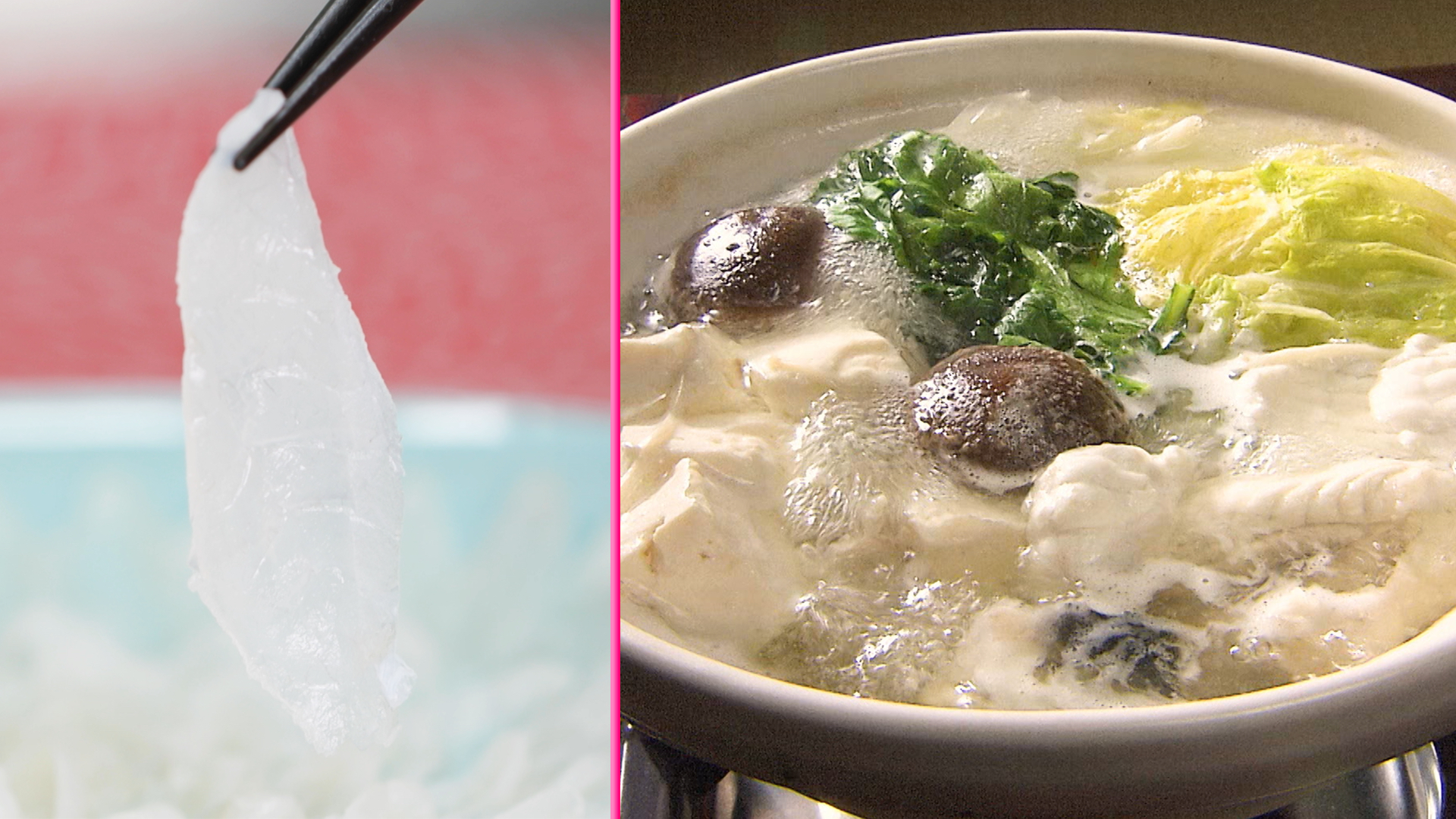
Fugu is usually sliced thinly and eaten as sashimi. It's the best way to enjoy its chewy texture.
Another classic fugu dish is nabe hotpot.
The broth is infused with the rich umami of fugu.
-
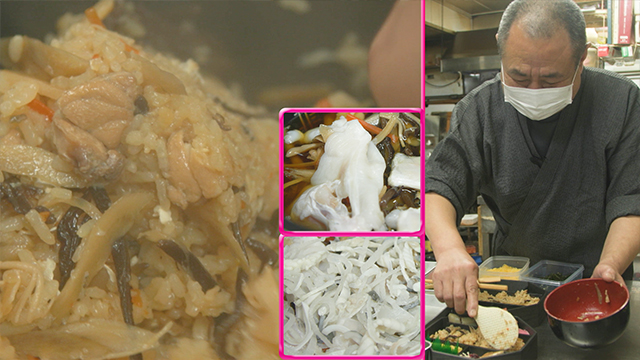
A historic ryokan makes a specialty bento packed with fugu.
The chef is especially proud of his rice, which is cooked with vegetables and fugu bones. The rice is infused with the rich umami from the fugu, and the skin gives it a chewy accent. -
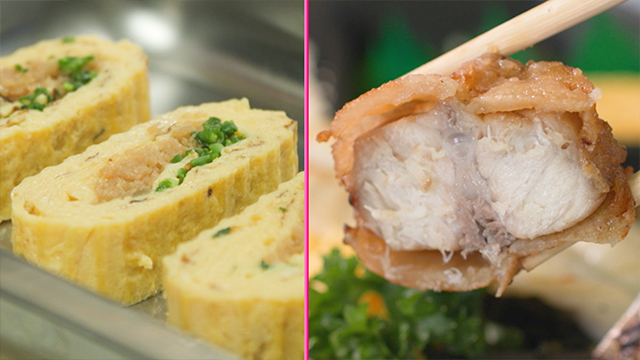
The bento also contains a tamagoyaki rolled omelet that contains minced fugu seasoned with soy sauce and green onions.
Another bento favorite, kara-age, is also made with fugu. It has a milder taste than chicken kara-age. -
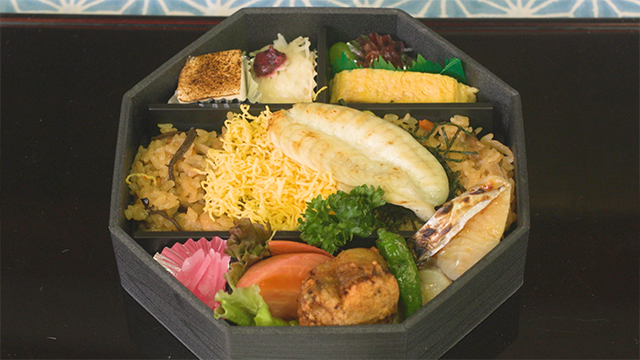
In the center is a serving of grilled fugu that's been sundried overnight to remove the excess moisture and concentrate the umami flavor. It's a favorite with local fishers.
A bento filled with a medley of fugu dishes. Yum!
-
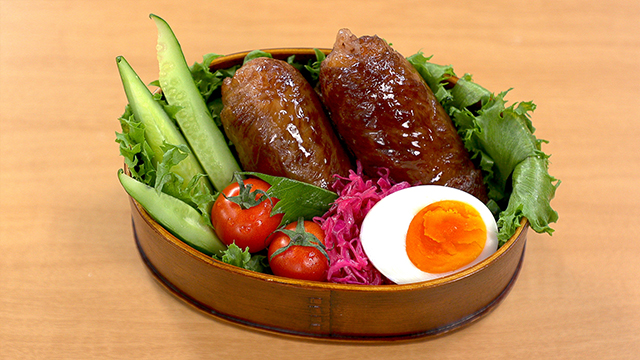
- BENTO RECIPES
- from Episode 13 / Season 7.
- Meat-wrapped Onigiri Bento
- (654 kcal)
-
 by Marc Matsumoto
by Marc Matsumoto
Bento contents:
- Meat-wrapped Onigiri
- Quick pickled red cabbage (shredded cabbage & sushi vinegar soaked overnight)
- Cucumbers
- Cherry tomatoes
- Frill lettuce
- Boiled egg
Ingredients:
Yields 4 Onigiri
- 350 g cooked rice (1 rice cooker cup)
- 2 tsp toasted sesame seeds
- 4 slices thinly sliced beef
- 2 tsp vegetable oil
- 3 tbsp 3S sauce (equal parts soy sauce, sake, sugar)
- Shiso leaves, for garnish
Directions:
1. Divide the rice into 4 portions, then shape each one into a cylinder using plastic wrap to keep the rice from sticking to your hands.
2. Sprinkle each rice ball with the toasted sesame seeds.
3. Wrap the onigiri with the beef.
4. Heat a frying pan over medium heat, then add the oil and meat-wrapped onigiri.
5. Fry the rice balls on all sides until browned.
6. When the beef is cooked through, wipe out any excess oil with a paper towel.
7. Add the 3S sauce and roll the onigiri around to glaze evenly.
-
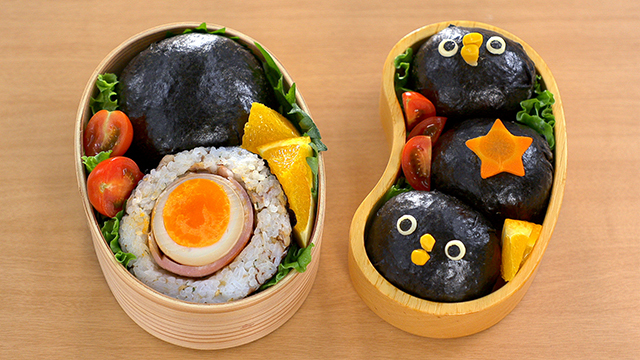
- BENTO RECIPES
- from Episode 13 / Season 7.
- Fireworks Onigiri Bento
- (For adults 754 kcal, For kids 431 kcal)
-
 by Maki Ogawa
by Maki Ogawa
Bento contents:
- For adults
- 1 Fireworks Onigiri (with seasoned egg wrapped in bacon, and mackerel-shiso rice)
- 1 Fireworks Onigiri (with crab sticks, tuna-mayo, and scrambled eggs)
- Cherry tomatoes
- Orange wedges
- Frill lettuce
- For kids
- 3 Fireworks Onigiri (with crab sticks, tuna-mayo, and scrambled eggs)
- Cherry tomatoes
- Orange wedges
- Frill lettuce
- Carrots
- Penguin decoration
Ingredients:
For Fireworks Onigiri (with seasoned egg wrapped in bacon, and mackerel-shiso rice)
(Yields 1)
- 1 sheet nori (cut to the size of the onigiri)
- 120 g cooked rice
- A pinch of salt
- 1 slice bacon (20 g)
- 2 shiso leaves
- 1 tsp sesame seeds
- 2 pieces dry pasta (1.4-2 cm long)
- 20 g canned mackerel in water
- A dash of soy sauce (approx. 1/2 tsp)
- Simmered egg
- 1 boiled egg
- 1 tbsp soy sauce
- 1 tbsp sake
For Fireworks Onigiri (with crab sticks, tuna-mayo, and scrambled eggs)
●For adults (yields 1)
- 1 sheet nori (cut to the size of the onigiri)
- 120 g cooked rice
- A pinch of salt
- A piece of lettuce (3 g)
- 2 crab sticks
- 15 g tuna-mayo
- 70 g canned tuna in oil
- A pinch each of salt and pepper
- 20 g mayonnaise (preferably Japanese)
- 13 g scrambled eggs
- 2 eggs
- 1.5 g sugar
●For kids (yields 1)
- 1/4 large sheet nori
- 60 g cooked rice
- A pinch of salt
- A piece of lettuce (3 g)
- 1 crab stick
- 7 g tuna-mayo
- 70 g canned tuna in oil
- A pinch each of salt and pepper
- 20 g mayonnaise (preferably Japanese)
- 5.5 g scrambled eggs
- 2 eggs
- 1.5 g sugar
For penguin decoration
- A small piece of cheese
- A small piece of nori
- 2 sweet corn kernels
- 1/4 stick dry pasta
Directions:
For the Fireworks Onigiri (with seasoned egg wrapped in bacon, and mackerel-shiso rice)
1. Add the soy sauce, sake, and boiled egg to a resealable food storage bag and marinate overnight.
2. Pat the egg dry and wrap with bacon. Secure with dry pasta.
3. Fry the wrapped egg in a non-stick pan. (Do not oil)
4. Drain the canned mackerel and sprinkle with soy sauce.
5. Sprinkle salt over the rice. Add the mackerel, shredded shiso leaves, and sesame seeds, and give it a quick toss.
6. Place a large piece of plastic wrap over a rice bowl or any other small bowl. Spread 60 g of rice and place the bacon-wrapped egg in the center.
7. Cover with the remaining 60 g of rice.
8. Bring the wrap together to twist and form a rice ball.
9. Remove the plastic wrap and wrap the onigiri with nori.
For the Fireworks Onigiri (with crab sticks, tuna-mayo, and scrambled eggs)
Tuna-mayo
1. Drain the tuna, add salt, pepper and mayonnaise, then mix.
Scrambled eggs
1. Beat the eggs and add the sugar.
2. Pour into a frying pan and scramble over low to medium heat.
1. Sprinkle salt over the rice.
2. Spread 30 g of rice over a sheet of plastic wrap and place the lettuce, scrambled eggs, crab stick, and tuna mayonnaise in the center.
3. Cover with the remaining 60 g of rice.
4. Bring the wrap together to twist and form a rice ball.
5. Unwrap, then wrap the onigiri in nori.
For penguin decoration
1. Skewer the reverse side of each of the corn kernels with dry pasta and stick into the onigiri to form the beak.
2. Cut out round pieces of cheese for the eyes, then stick on the onigiri. Use nori to form the pupils.
-
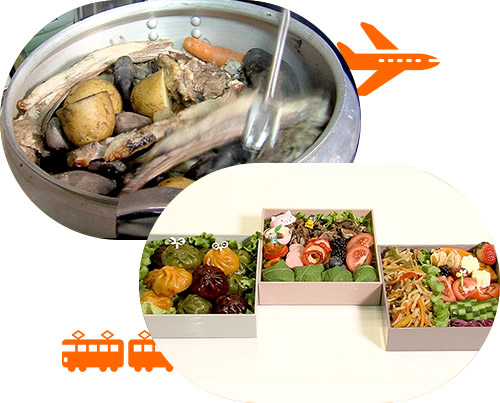
- BENTO TOPICS
- from Episode 13/ Season 7.
- Mongolia
-
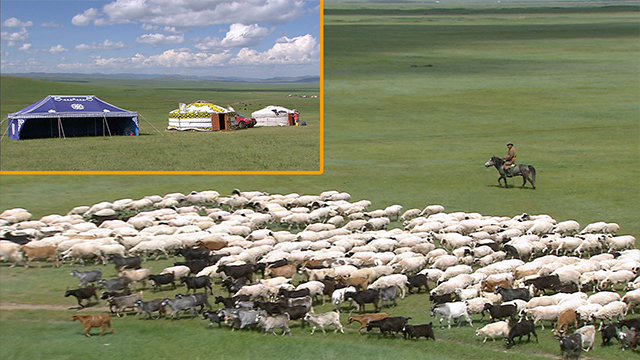
Today, from Mongolia, where many of the people live a nomadic lifestyle.
Livestock farming has been a way of life here since ancient times, providing people with a means to survive the harsh natural environment. They rely heavily on sheep. -
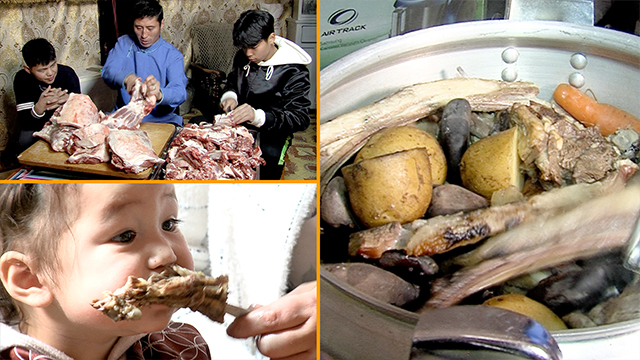
Khorgog is a classic dish of steamed mutton. A whole sheep's worth of meat is used, bones and all.
This dish utilizes hot stones, which are placed in a pot filled with meat and vegetables. The heat from the stones penetrates deep into the meat, making it tender and moist. -
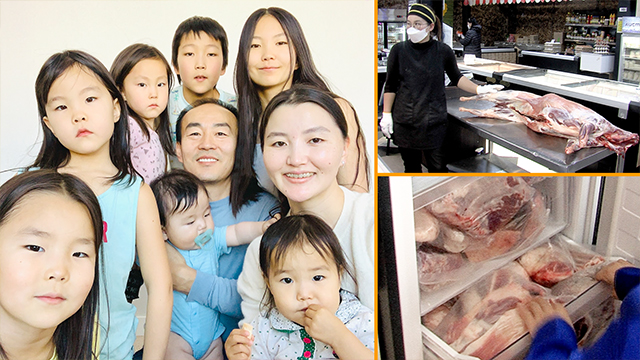
Dulguun is a bento maker who lives in the capital city of Ulaanbaatar. A mother of seven, she makes bentos for her family every day. She buys a whole sheep's worth of meat from the butcher and stores the cuts in a dedicated freezer.
-
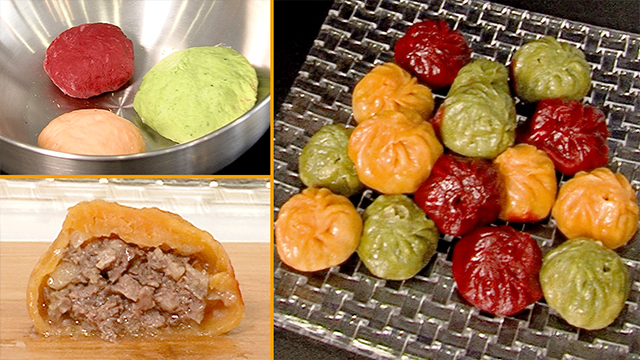
For today's bento, she's making buuz: dumplings stuffed with minced mutton. Dulguun makes her buuz colorful by kneading beets, spinach, and carrots into the dough.
-
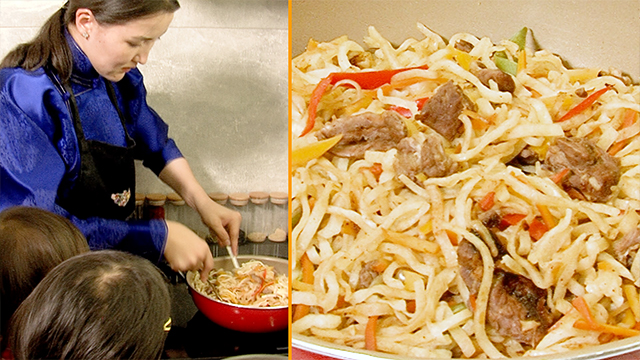
She also makes a colorful stir-fried dish of noodles, mutton, red bell peppers, beets, and carrots. It looks yummy!
-
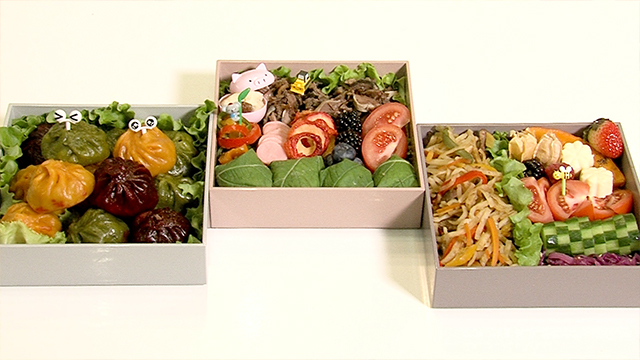
And for dessert, a curd cheese made from sheep's milk.
A bento packed with delicious dishes, thanks to sheep. Ideal for a family picnic at home.
-
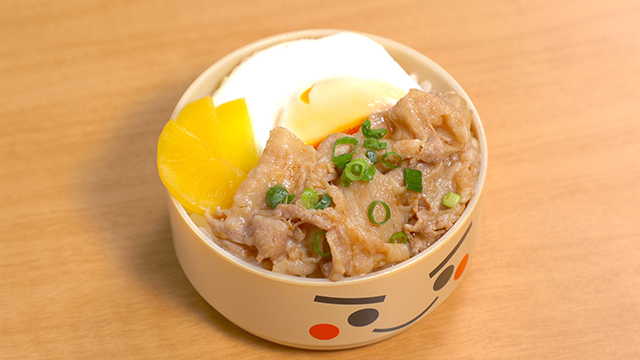
- BENTO RECIPES
- from Episode 12 / Season 7.
- Stamina Donburi Bento
- (625 kcal)
-
 by Marc Matsumoto
by Marc Matsumoto
Bento contents:
- Stamina Pork
- White rice
- Tsubozuke
- Steamed egg
Ingredients:
Makes enough to pack into 2 bentos
For Stamina Pork
- 170 g pork belly, sliced paper-thin for hot pot
- 60 ml dashi
- 7 g garlic, grated
- 4 g ginger, grated
- 1 1/2 tbsp soy sauce
- 1 tbsp sake
- 1 tsp sugar
- 1 scallion (stems sliced at an angle, greens chopped)
Directions:
For Stamina Pork
1. Prepare a bowl of cold water.
2. Bring a large pot of water to a boil. Add half of the pork belly and swish it around until it is cooked through, then transfer it to the cold water to stop the cooking. Repeat with the remaining pork belly.
3. Drain the pork belly well.
4. Prepare the sauce by mixing the dashi, soy sauce, sake, sugar, garlic, and ginger in a frying pan. Add in the scallion stems and bring the mixture to a boil.
5. When the scallions have softened, add the pork belly and toss to coat with the sauce. Cook until most (but not all) of the liquid has evaporated.
6. Pack the pork separately from the rice and garnish with the scallion greens. Pour the pork and sauce over the rice when you eat it. You can also top this with a fried egg for some extra protein.
For steamed egg
1. Break the egg into a small bowl and pour off the watery part of the egg white.
2. Heat a non-stick frying pan over medium-low heat. Gently add the egg into the pan from the bowl to give it a nice shape.
3. Turn down the heat to low and cook the egg until the egg white is mostly cooked through.
4. Add 2 tablespoons of water and cover the pan with a lid to steam the egg until the yolk is cooked.
-
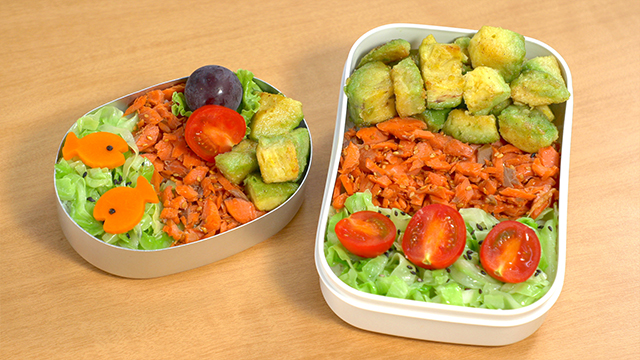
- BENTO RECIPES
- from Episode 12 / Season 7.
- Salmon Avocado Bento
- (For adults 751 kcal, For kids 321 kcal)
-
 by Maki Ogawa
by Maki Ogawa
Bento contents:
- Rice (240 g for adults, 120 g for kids)
- Salmon Soboro
- Butter-sautéed avocado
- Cabbage salad
- Cherry tomatoes
- Grapes
- Frill lettuce
- Little "fish" decorations
Ingredients:
For Salmon Soboro (yields 4-5 servings)
- 2 salmon fillets (150 g)
- 2 tbsp sake
- 2 tsp soy sauce
- 1 tsp sugar
- White sesame seeds, as needed
For the butter-sautéed avocado (yields 2 servings)
- 1 firm avocado
- 10 g butter
- A pinch of potato starch
- Salt and pepper
For the cabbage salad
- Cabbage leaves
- Sesame oil
- Granulated chicken soup
- Salt and pepper
- Black sesame seeds
For the little "fish" decorations
- Carrot
- Nori
Directions:
For the Salmon Soboro
1. Sprinkle salt over the salmon and refrigerate overnight.
2. Wrap in aluminum foil to seal.
3. Fill a shallow pot with water and bring to a boil. Add the salmon and boil for 30 seconds. Turn off the heat and cook in residual heat for 5 minutes.
4. Drain and set aside for 5 minutes to cool.
5. Unwrap the salmon and remove the skin and bones.
6. Add the salmon to a heated frying pan and flake. Season with sake, sugar, and soy sauce. Turn up the heat to boil off the sake.
7. Reduce the heat to low and simmer until there is no more liquid. Turn off the heat and sprinkle with white sesame seeds.
For the butter-sautéed avocado
1. Remove the skin and seed from the avocado and cut into 2-3 cm cubes.
2. Sprinkle with potato starch. (Do this right away to prevent discoloration.)
3. Melt the butter in a frying pan and sauté the avocado to a golden brown. Season liberally with salt and pepper.
For the cabbage salad
1. Boil 2 cabbage leaves (approx. 50 g) for 30 seconds.
2. Soak briefly in cool water and cut into thin strips.
3. Season with sesame oil, granulated chicken soup, salt and pepper. Sprinkle with black sesame seeds.
For the little "fish" decorations
1. Cut the carrot into 5 mm thick slices and boil for 4 minutes.
2. Use a cookie cutter to cut out the fish shapes.
3. Add nori for the eyes.
-

- BENTO TOPICS
- from Episode 12/ Season 7.
- Kawagoe
-
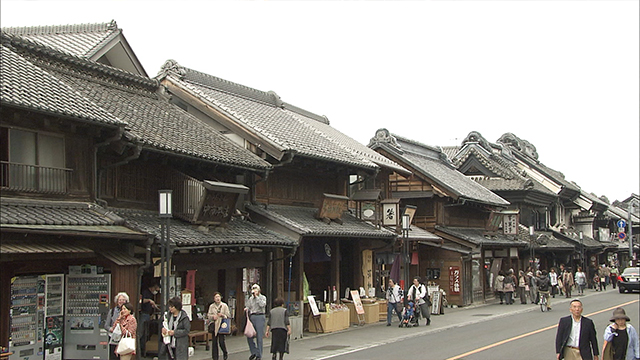
Today, from Kawagoe, a historic merchant town that allows visitors to step back in time to the Edo period. It’s a popular tourist destination.
-
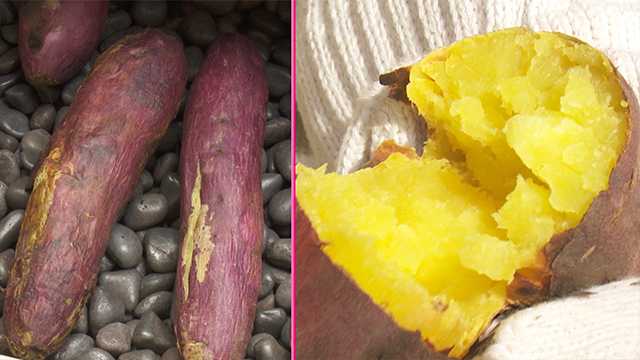
It’s famous for its yaki-imo: hot stone-baked sweet potatoes. They’re naturally sweet and fluffy and are a popular snack in Japan.
-
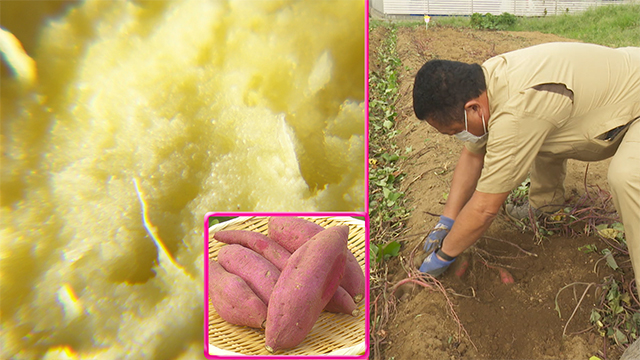
Sweet potato cultivation in Kawagoe began some 200 years ago in the Edo period.
Beni-aka, a variety grown in Kawagoe for generations, is known for its especially fluffy and velvety texture.
-
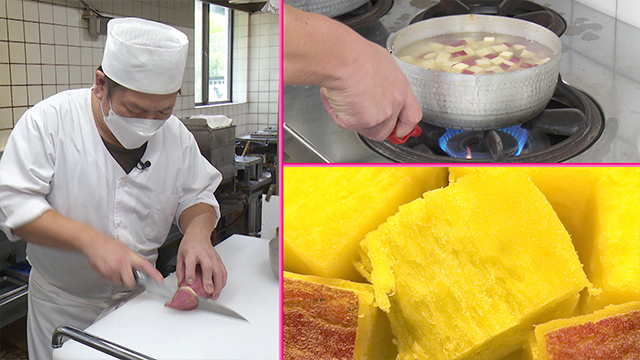
This sweet potato restaurant offers a specialty beni-aka bento.
The key to making the most of its qualities lies in boiling it properly. The potatoes aren't boiled all the way through; they're cooked through with residual heat.
This enhances the unique texture of the beni-aka. -
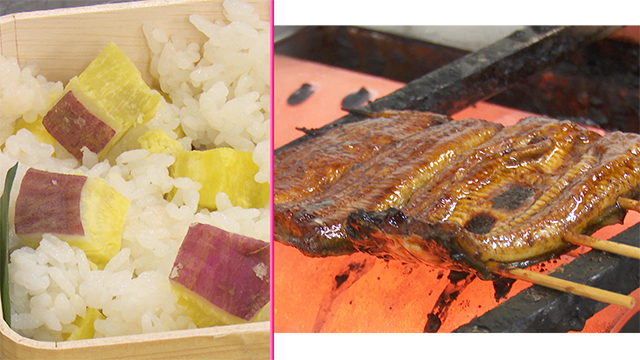
The cubed beni-aka is then layered into the rice. When it's time to eat, it's almost like digging up potatoes from the ground!
Unagi or broiled eel glazed with a sweet, soy-based sauce, is placed over the rice. Rich in protein, unagi was a popular pick-me-up for the merchants of old. -
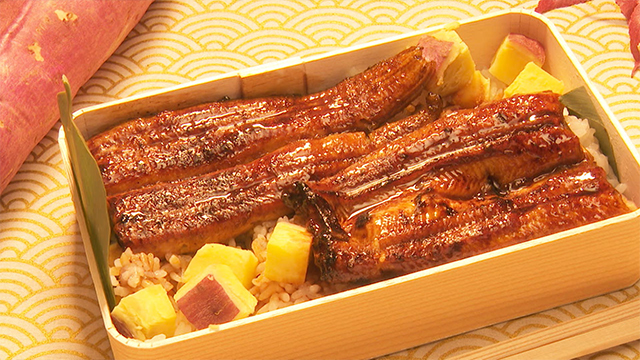
A Kawagoe specialty bento, packed with fluffy sweet potatoes.
It features a delectable harmony of sweet beni-aka potatoes and umami-rich unagi.
-
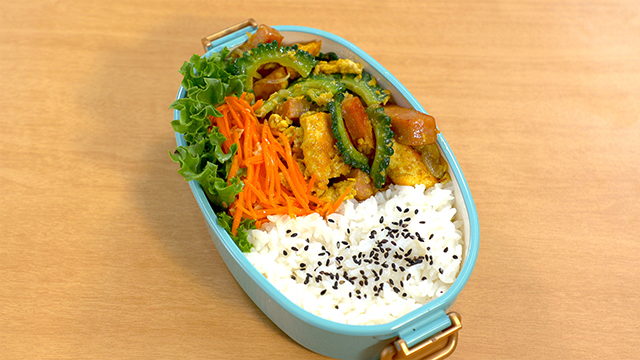
- BENTO RECIPES
- from Episode 11 / Season 7.
- Curry Goya Champuru Bento
- (577 kcal)
-
 by Marc Matsumoto
by Marc Matsumoto
Bento contents:
- Curry Goya Champuru
- Rice
- Shredded Carrot Stir-Fry
- Frill lettuce
- Black sesame seeds
Ingredients:
Makes enough to pack into 2 bentos
For Curry Goya Champuru
- 240 g bitter melon (200 g seeds removed), sliced 3mm thick
- 1/4 tsp salt
- 350 g firm tofu
- 2 tbsp vegetable oil
- 150 g luncheon meat, cut into 1/4-inch thick sticks
- 100 g onion, sliced thinly
- 2 tsp curry powder
- 1 tbsp soy sauce
- 1 tbsp honey
- 2 eggs, lightly beaten
For Shredded Carrot Stir-Fry
- 200 g carrots, shredded on a mandoline slicer
- 50 g drained canned tuna (1 small can)
- 1 tbsp toasted sesame oil
- 2 tsp soy sauce
- 4.5 g katsuobushi
- 2 tsp toasted sesame seeds
Directions:
For Curry Goya Champuru
1. Sprinkle the bitter melon with the salt and toss to coat evenly. Let this rest for at least 20 minutes to sweat.
2. Drain and place the tofu on a wire rack set in a tray, then place another tray on top. Add some weight to the top tray and let the tofu drain some more.
3. When the bitter melon has become limp, massage it with your hands to coax out more liquid. Then scoop it up and squeeze it between your hands to remove as much liquid as possible.
4. Drain the water that has come out of the tofu and tear it into bite-sized pieces.
5. Heat a frying pan over medium heat and add the oil and pieces of tofu. Fry the tofu on one side until it starts to brown, then flip the tofu over and brown the other side.
6. Push the tofu out towards the edges of the pan, then add the luncheon meat and onions. Brown the luncheon meat on one side, then flip and brown on the other side.
7. Add the squeezed bitter melon and curry powder, and then stir-fry until the bitter melon is a vibrant green.
8. Season with soy sauce and honey. Finish the Curry Goya Champuru by pouring over the beaten egg and scrambling the mixture together until the egg is cooked through.
For Shredded Carrot Stir-Fry
1. Stir-fry shredded carrots in toasted sesame oil with canned tuna. Season with soy sauce.
2. Finished with toasted sesame seeds and katsuobushi.
-
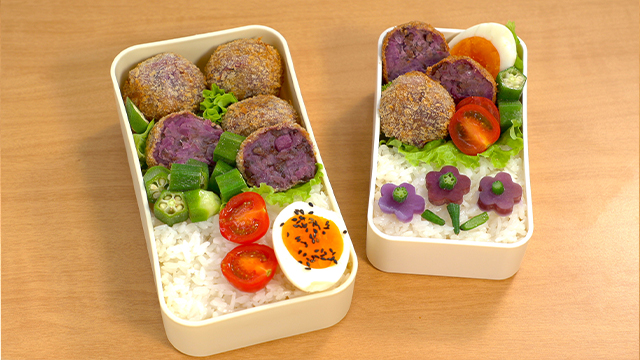
- BENTO RECIPES
- from Episode 11 / Season 7.
- Purple Sweet Potato Korokke Bento
- (For adults 853 kcal, For kids 548 kcal)
-
 by Maki Ogawa
by Maki Ogawa
Bento contents:
- Purple Sweet Potato Korokke
- Rice (240 g for adults, 130 g for kids)
- Cherry tomatoes
- Hard-boiled egg with goma-shio (salt and sesame seeds)
- Okra
- Frill lettuce
- Black sesame seeds (for adults)
- Purple sweet potato and okra "flowers" (for kids)
Ingredients:
For Purple Sweet Potato Korokke
- 1 purple sweet potato (approx. 220 g)
- 120 g ground beef
- 1/4 onion (60 g)
- 2 tbsp milk
- 10 g butter (or slightly less)
- Vegetable oil, as needed
- Batter
- Egg
- Flour
- Panko breadcrumbs
For the purple sweet potato and okra "flowers"
- Purple sweet potato
- Okra
Directions:
For Purple Sweet Potato Korokke
1. Add a dash of vegetable oil to a heated frying pan and sauté the ground beef. Once the color changes, add the minced onions, season liberally with salt and pepper, and continue sautéing.
2. Remove from heat and allow to cool.
3. Cut the unpeeled purple sweet potato into 1 cm thick slices. Set aside 2 slices for the flower decorations. Add to boiling water and simmer over low heat for 3 minutes. Just before draining, add the okra so that both the potatoes and okra are done at the same time. Cut the drained sweet potato slices into quarters. Add to boiling water and cook for 5 minutes. Reduce the heat to low and simmer for 7-8 minutes until tender.
4. Use a masher to mash the potatoes. There’ll be hardly any trace of the skin, but remove any large pieces if they bother you.
5. Add butter and milk and mix well.
6. Form into round balls, approx. 35 g each.
7. Bread with flour, beaten egg, and panko. Deep-fry at 170 degrees C.
For the sweet potato and okra "flowers"
1. Add the two remaining slices of sweet potato to boiling water and simmer for 4 minutes.
2. Remove from heat and soak the potato in water to keep from drying out before cutting.
3. Pat dry and cut into flower shapes with a cookie cutter.
4. Cut the okra into 3 mm slices and place a slice in the center of each flower.
5. Use the okra tips to create the flower stems. Pack the remaining sliced okra alongside the potato korokke.
-
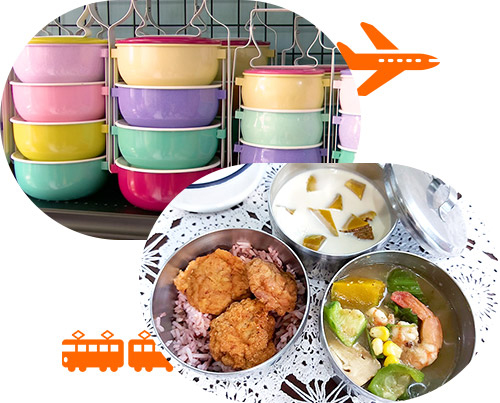
- BENTO TOPICS
- from Episode 11/ Season 7.
- Thailand
-
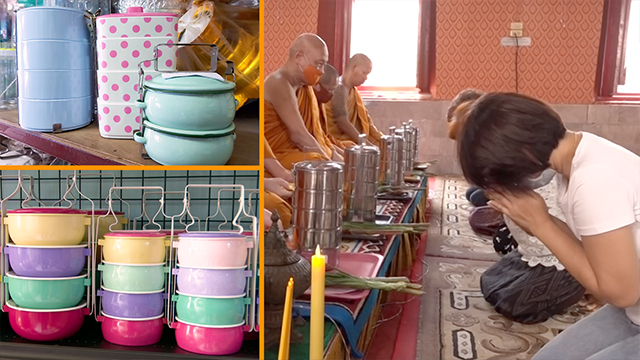
Bento Topics. Today, from the Buddhist country of Thailand. Giving alms to monks is a morning ritual that is believed to bring happiness and good fortune. The food is offered in a pinto, a traditional Thai bento box. In recent years, pintos have become more colorful and stylish, attracting attention from all generations.
-
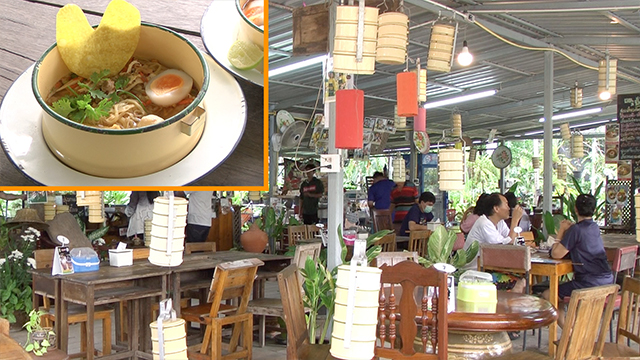
One restaurant features pintos in its décor as well as its food presentation. The owner began serving food in pintos to help pass on the tradition to the younger generation.
-
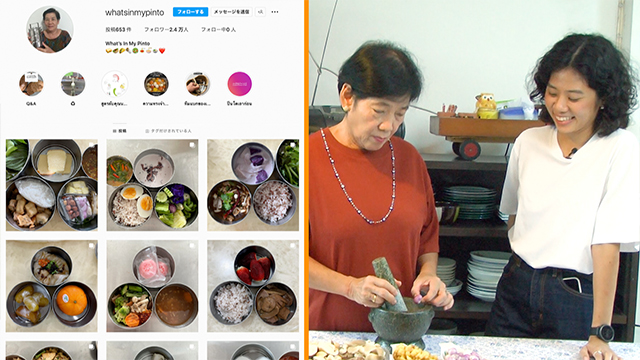
Pinto bentos are gaining a following on social media. About four years ago, Preaw began posting photos of the pinto bentos her mom Pon prepares for her everyday. Judging from her 20,000 followers, the pinto bentos packed with traditional Thai foods stir up feelings of nostalgia for home. Preaw is helping her mom make today's bento.
-
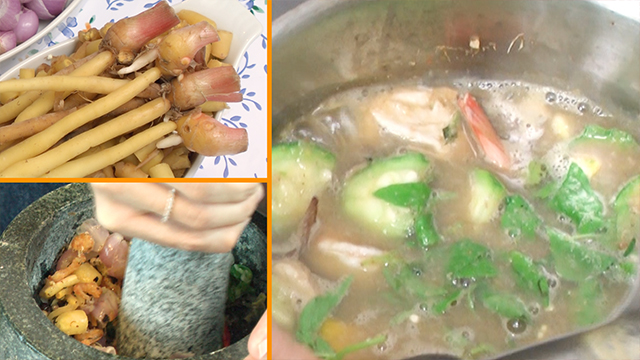
First, a traditional shrimp and vegetable soup. Krachai, or fingerroot, is a traditional herb used to mask fishy smells. It's ground with shrimp paste and pepper to season the shrimp and vegetables simmered in chicken broth, resulting in umami-rich soup that brings out the inherent flavors of each ingredient.
-
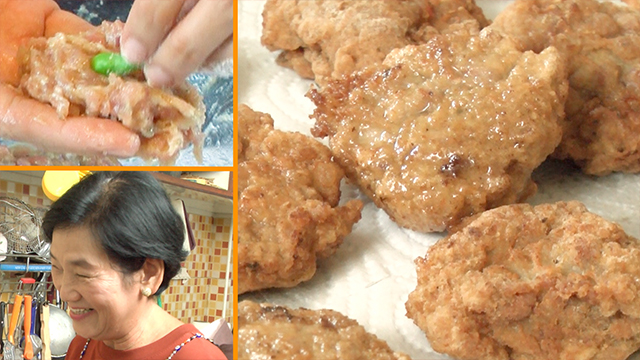
Next, Preaw tries her hand at making her mom’s favorite—deep-fried pork and salted fish meatballs with coriander paste. Pon likes to stuff the meatballs with chili pepper. She's delighted at her daughter’s efforts.
-
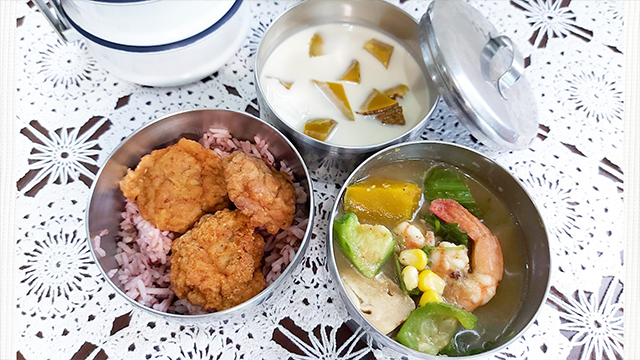
The bottom layer of the pinto contains a bed of mixed grain rice topped with the spicy meatballs. The next layer holds the soup. The final layer features a dessert of pumpkin in coconut milk.
The pinto bento, packed with traditional Thai food full of love, is done!
-
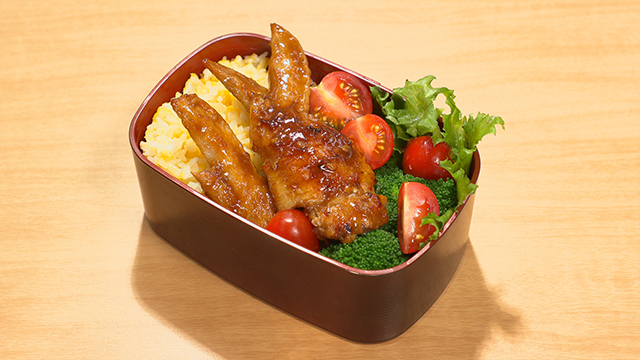
- BENTO RECIPES
- from Episode 10 / Season 7.
- Chicken Wing Gyoza Bento
- (618 kcal)
-
 by Marc Matsumoto
by Marc Matsumoto
Bento contents:
- Chicken Wing Gyoza
- Egg Fried Rice
- Boiled broccoli
- Small tomato slices
- Frill lettuce
Ingredients:
Makes enough to pack into 2 bentos
- 6 chicken wings
- 100 g ground chicken
- 20 g shiitake mushrooms, finely minced
- 20 g onion, finely minced
- 5 g ginger, grated
- 1 tbsp oyster sauce
- 1/4 tsp black pepper
- 1 tsp potato starch
- Additional potato starch, for dusting wings
- 2 tbsp 3S sauce (equal parts soy sauce, sake, sugar)
- 1 tbsp black vinegar
Directions:
1. Bend the chicken wings backward at the joint to free the two bones in the meaty part of the wing.
2. Use clean kitchen scissors to cut the cartilage between the two bones in the broad end of the chicken wing. Use your fingers to push the meat away from each bone, and pull the two bones out.
3. Add the ground chicken, minced shiitake, onions, ginger, oyster sauce, black pepper, and potato starch to a bowl. Knead with your hands until evenly combined.
4. Use a spoon to scoop the filling into the pocket formed in each chicken wing by removing the bones.
5. Add a few spoonfuls of potato starch to a tray and dust the wings with a thin, even layer of starch.
6. Preheat a non-stick frying pan over medium heat until hot, and then add the stuffed chicken wings with the thick side of the skin facing down.
7. Fry the chicken until golden brown on this side, then flip the wings over.
8. Holding a lid above the pan, quickly pour 4 tablespoons of water into the pan and shut the lid.
9. Let the chicken steam until the water has evaporated (about 3-4 minutes).
10. Open the lid and let any remaining liquid boil off. Use paper towels to soak up any excess water and add the 3S sauce.
11. Glaze the chicken wing gyoza with the sauce until almost no liquid is left. Add the black vinegar, toss to coat, and then remove the gyoza from the pan to cool to room temperature.
-
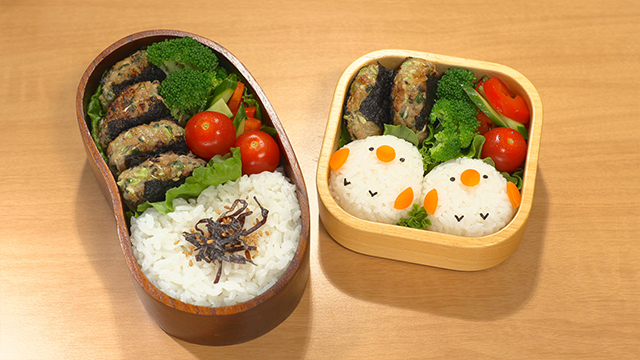
- BENTO RECIPES
- from Episode 10 / Season 7.
- Nori Gyoza Bento
- (For adults 626 kcal, For kids 331 kcal)
-
 by Maki Ogawa
by Maki Ogawa
Bento contents:
- Nori Gyoza
- Rice (220 g for adults, 120 g for kids)
- Red bell pepper and cucumber pickles
- Broccoli
- Cherry tomatoes
- Frill lettuce
- Shiokonbu
- Toasted sesame seeds
Ingredients:
For Nori Gyoza (yields 8)
- 1 sheet nori
- 120 g ground pork
- 50 g onion
- 10 g Chinese chives (also known as garlic chives)
- 5 g shiso leaves
- 70 g cabbage
- 1/2 tsp grated ginger
- A pinch each of salt and pepper
- 1 tsp sesame oil
- 1.5 tsp soy sauce
- 1.5 tsp potato starch
- Vegetable oil, as needed
- Olive oil for pan frying, as needed
For "chick" onigiri
- Rice
- Carrot
- Nori
Directions:
For Nori Gyoza
1. Mince the cabbage, onion, Chinese chives, and shiso leaves.
2. Add the minced vegetables, ground pork, grated ginger, salt, pepper, sesame oil, soy sauce, and potato starch to a bowl, and knead together.
3. Divide the filling into 8 equal portions (about 32-35 g each) and cut the nori into 8 equal pieces.
4. Wrap the filling with nori.
5. Fry both sides in a frying pan without using a lid.
For the "chick" onigiri
1. Use a straw to cut out beaks from slices of boiled carrot. Use a U-shaped cookie cutter to cut out the wings.
2. Use nori for the eyes and feet.
- Tochigi Special
- from Episode 10/ Season 7.
-

Many people come from abroad to work in Tochigi Prefecture. Aleli, who is originally from the Philippines, lives in Ashikaga City. It’s here that she met and married her husband Nadeem, a Pakistani Muslim. They live together with their two daughters, as well as Aleli’s mother. Each day, Aleli makes a halal bento for her husband, who works in a factory.
-
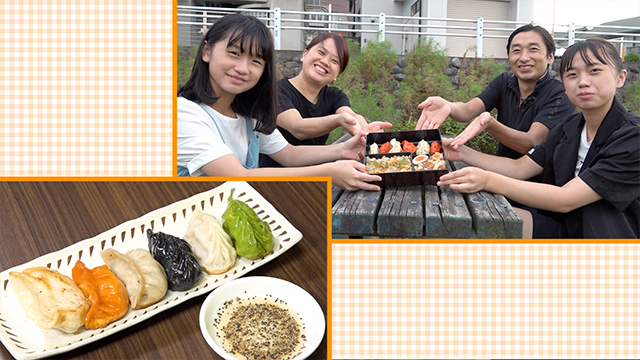
Jiang and Wang, a couple from China, run two restaurants in Utsunomiya, the capital of Tochigi Prefecture. They met in Japan and got married 17 years ago. Now they have two daughters together. Utsunomiya is famous for its gyoza, or Chinese dumplings. The signature dish at one of their restaurants features six different gyoza, each with a different color and flavor, based on Jiang’s grandmother’s secret recipe.
-
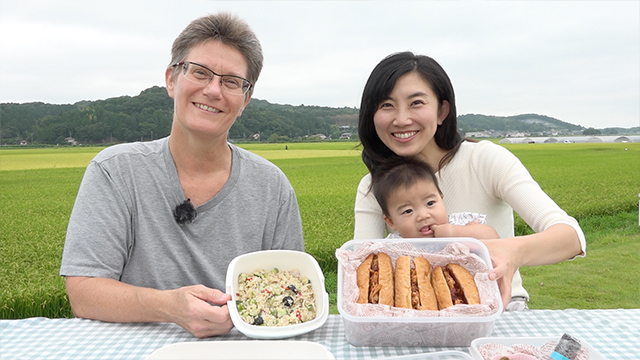
Anne is from Canada. She came to Japan about 30 years ago as a professional golfer. After retiring from golf, she eventually decided to settle in Mashiko, a town with a rich natural environment, where she teaches English and makes processed vegetable products. Once a month, she sets up a food stand at a roadside station, where she serves traditional Canadian homemade food.
-
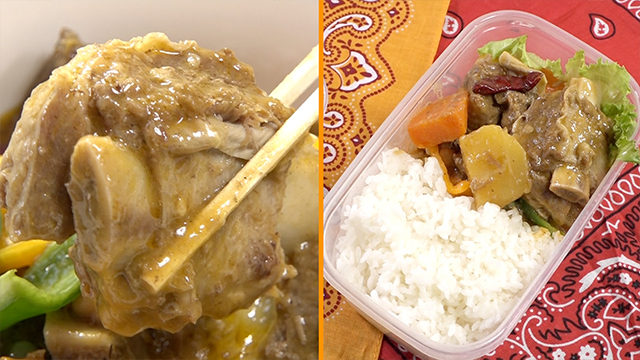
Caldereta is a Filipino stew of bone-in beef and vegetables simmered in a spicy tomato-based broth. Aleli’s husband, Nadeem, loves caldereta and appreciates that Aleli makes him a halal bento every day.
-
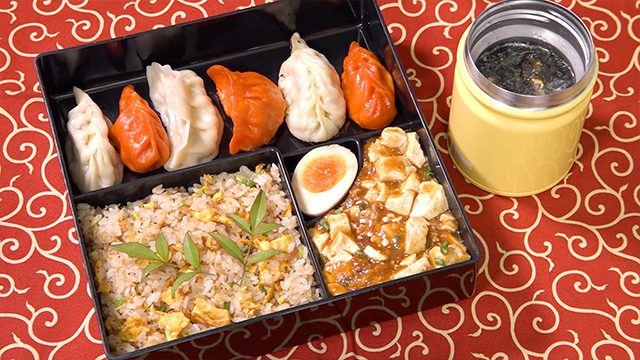
On this day, the daughters prepare a bento for their parents. In China, dumplings are believed to bring good luck. Making them in red and white, which are auspicious colors in Japan, makes for a good-luck bento! Asami teaches her younger sister, Yoshimi, how to wrap gyoza in the shape of rice ears, another symbol of good luck in China. The parents are delighted by the thought that went into the bento their daughters made.
-
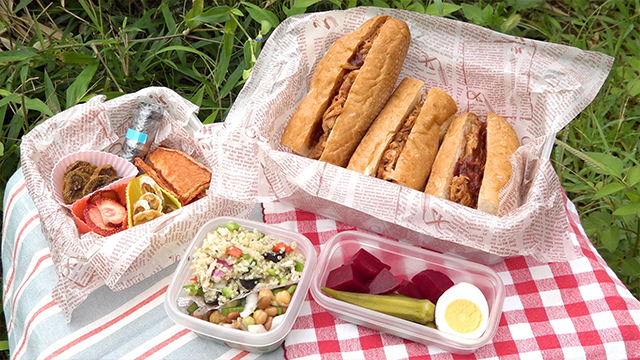
Today, Anne made a pulled pork sandwich for her friend Yukiyo, who loves Anne's cooking. The slow-cooked pulled pork is flavored with a sweet and spicy barbecue sauce. It’s a favorite back home in Canada. Anne also adds dried strawberries, a specialty of Tochigi, to make a bento packed with Japanese and Canadian flavors!
-
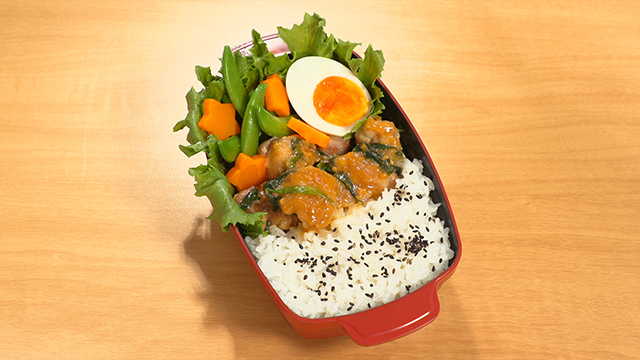
- BENTO RECIPES
- from Episode 9 / Season 7.
- Maple-miso Chicken Bento
- (660 kcal)
-
 by Marc Matsumoto
by Marc Matsumoto
Bento contents:
- Maple-miso Chicken
- White rice
- Black sesame seeds
- Frill lettuce
- Snap peas
- Carrots
- Boiled egg
Ingredients:
Makes enough to pack into 2 bentos
- 2 tbsp maple syrup
- 2 tbsp miso
- 2 tbsp sake
- 250 g chicken thighs, cut into bite-sized pieces
- 2 scallions, sliced
Directions:
1. Whisk the maple syrup, miso, and sake together until the mixture is smooth and free of lumps.
2. Heat a non-stick frying pan over medium heat until hot. Add the chicken with the skin-side down. Let it fry until some fat has rendered out and the skin side has browned.
3. Flip the chicken over and cook the other side.
4. Use paper towels to remove as much fat from the pan as possible.
5. Add the maple miso sauce and boil while tossing the chicken until the mixture starts to thicken.
6. Add the scallions and toss to coat everything with the sauce.
-
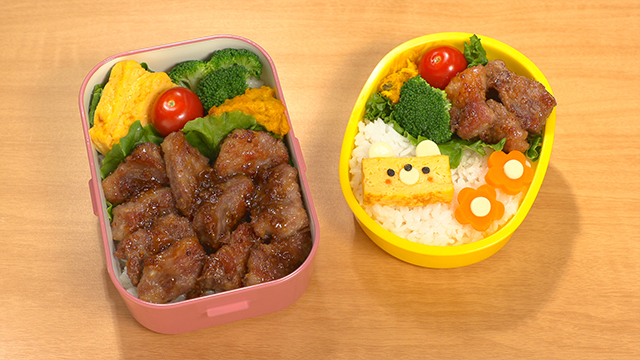
- BENTO RECIPES
- from Episode 9 / Season 7.
- Maple-mustard Pork Bento
- (For adults 730 kcal, For kids 413 kcal)
-
 by Maki Ogawa
by Maki Ogawa
Bento contents:
- Maple-mustard Pork
- Rice (230 g for adults, 120 g for kids)
- Kabocha pumpkin salad
- Tamagoyaki (Japanese rolled omelet)
- Broccoli
- Cherry tomatoes
- Frill lettuce
- "Bear cub" tamagoyaki (for kids)
- Carrot flowers (for kids)
Ingredients:
For Maple-mustard Pork
- 300 g pork
- A pinch each of salt and pepper
- 1 tsp grated garlic
- 1.5 tbsp maple syrup
- 1.5 tsp wholegrain mustard
- 1.5 tsp soy sauce
- Flour, as needed
- Olive oil for stir-frying, as needed
For "bear cub" tamagoyaki
- Tamagoyaki
- Sliced cheese
- Ketchup
- Nori
Directions:
For Maple-mustard Pork
1. Use a fork to pierce the pork (to improve the flavor), then cut into bite-size pieces.
2. Place in a bowl and rub with salt, pepper, and garlic.
3. Coat evenly with flour.
4. Add to a heated pan and fry uncovered. Wipe off the rendered fat and brown both sides until crisp.
5. Mix the maple syrup, wholegrain mustard, and soy sauce. Add to the pan to glaze the pork.
For the "bear cub" tamagoyaki
1. Use a cookie cutter to cut out the ears and nose from the cheese. Use a straw to cut out the nose.
2. Add the ears and nose to the tamagoyaki and use nori for the eyes.
3. Draw the cheeks with ketchup.
4. Use a flower-shaped cookie cutter to cut flowers from boiled carrot slices. Use a straw to cut out pieces of cheese to place in the center of the flowers.
-
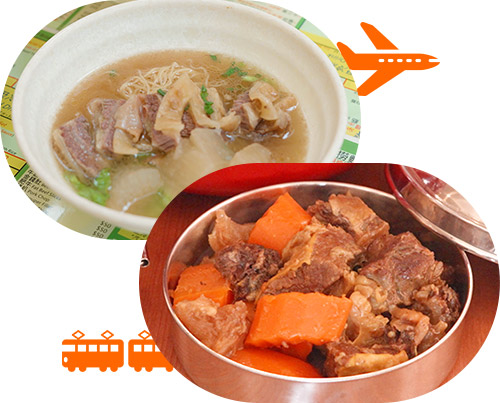
- BENTO TOPICS
- from Episode 9/ Season 7.
- Hong Kong
-

Bento Topics. Today, from an East Asian gourmet paradise, Hong Kong.
-
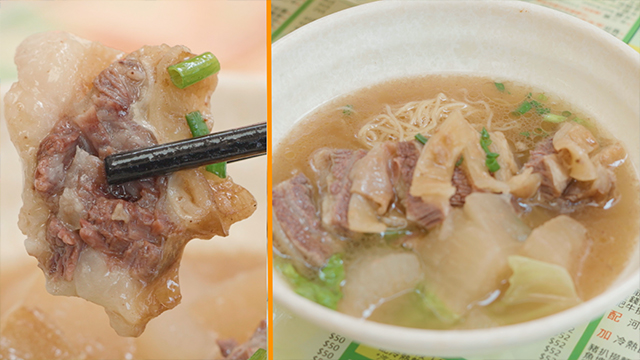
One of the local specialties is Brisket Soup Noodles, a bowl of egg noodles and brisket simmered in a rich beef broth. The brisket is tender enough to melt in your mouth.
-
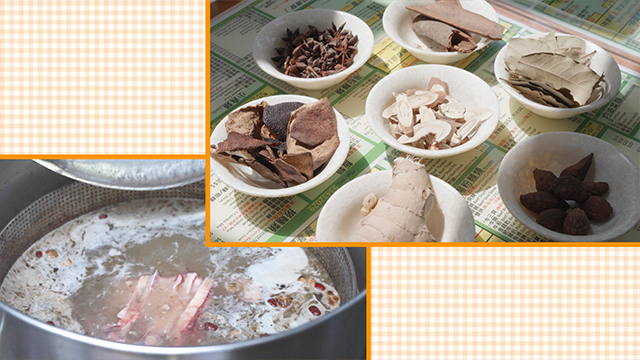
The beef broth contains a medley of spices used in Chinese herbal medicine. For example, the bitter chenpi, or dried citrus peel, is said to be good for the intestines and liver.
-
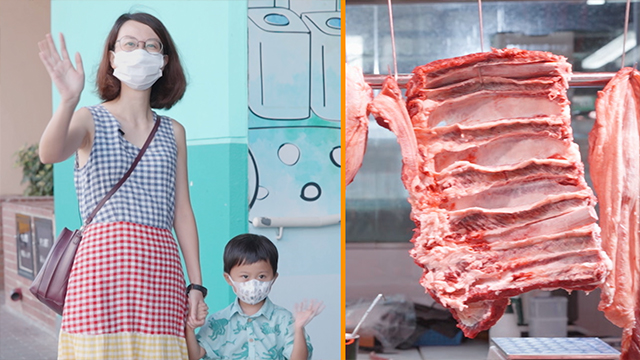
Serena began making bentos two years ago to take on family picnics . Today, she’s going to make a brisket curry bento with her four-year-old son Jasper.
-
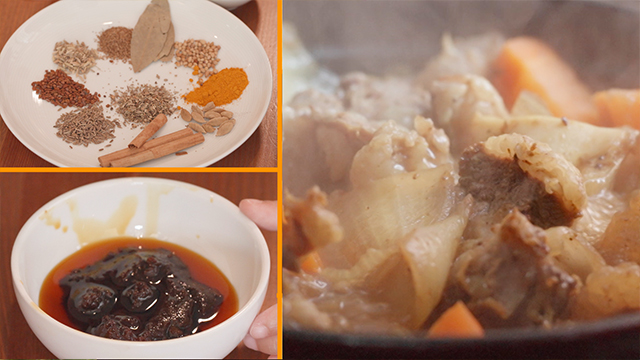
Her homemade curry powder contains ten spices, including fennel seeds and cinnamon. She stir-fries the curry powder with onions, and garlic. She then adds a standard ingredient in Hong Kong-style curry: a curry paste with peanuts. After that, she adds the brisket and simmers it until tender.
-
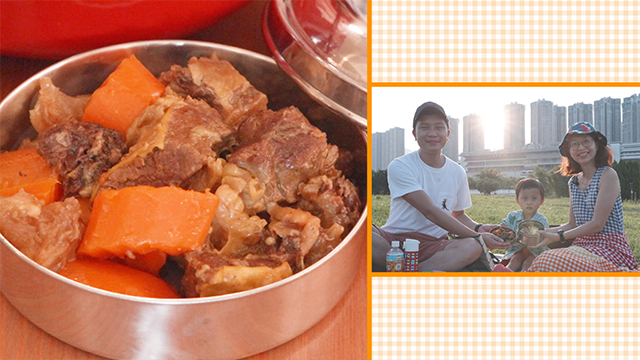
A picnic bento packed with fragrant Hong Kong-style brisket curry.
It’s a big hit with her husband and son, providing them with the energy they need for fun in the park.
-
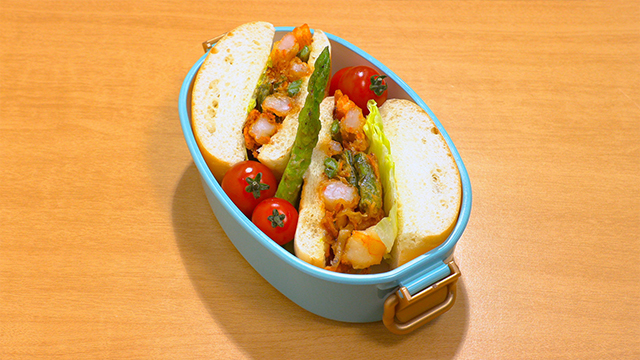
- BENTO RECIPES
- from Episode 8 / Season 7.
- Kakiage Sandwich Bento
- (613 kcal)
-
 by Marc Matsumoto
by Marc Matsumoto
Bento contents:
- Kakiage Sandwich
- Asparagus spears (deep-fried)
- Cherry tomatoes
Ingredients:
Yields 2 Kakiage sandwiches
- 60 g shrimp (shelled, deveined, and chopped)
- 60 g onions, thinly sliced
- 40 g green beans, trimmed and cut into 1-inch pieces
- 40 g carrots, cut into matchsticks
- 30 g cake flour
- 3 tbsp soda water
- Vegetable oil for deep-frying
- 3 tbsp 3S sauce (equal parts soy sauce, sake, sugar)
- 2 tbsp mayonnaise
- Lettuce
- 2 small hamburger buns
Directions:
1. Preheat 1 1/2 inches (4 cm) of vegetable oil to 180 degrees C (355 degrees F).
2. Add the shrimp, onions, green beans, carrots, and cake flour to a bowl. Stir to coat everything with an even layer of flour.
3. Add the soda water to the bowl and stir until the vegetables are evenly coated with batter.
4. Load half of the kakiage mixture onto a flat metal surface such as a large spatula or flat metal cheese grater. Try to get the shape as round as possible.
5. Lower the kakiage batter into the oil and use a heat-proof spatula to push it off the metal surface. Repeat with the remaining batter.
6. Fry the kakiage until it starts to brown around the edges, and then flip over and fry the other side until it is golden brown and crisp.
7. While the kakiage is frying, add the 3S sauce to a small saucepan and bring it to a boil. Continue boiling until it no longer smells like alcohol (about 30 seconds).
8. Set the kakiage directly on the wire rack. Drizzle the 3S sauce over the kakiage while they are still hot and let them cool to room temperature on the rack.
-
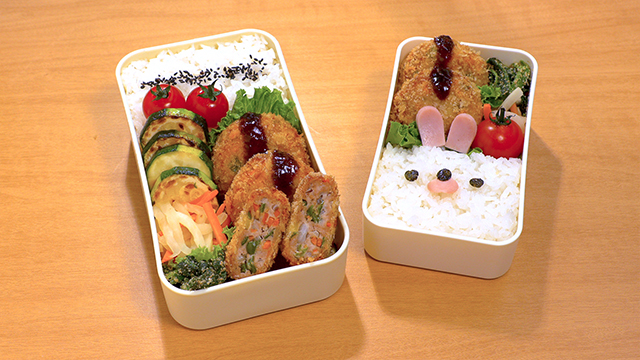
- BENTO RECIPES
- from Episode 8 / Season 7.
- Veggie Menchi-katsu Bento
- (For adults 830 kcal, For kids 551 kcal)
-
 by Maki Ogawa
by Maki Ogawa
Bento contents:
- Veggie Menchi-katsu
- Rice (200 g for adults, 130 g for kids)
- Spinach salad with sesame dressing
- Sweet pickled daikon and carrot
- Cherry tomatoes
- Lettuce
- Grilled zucchini (for adults)
- Black sesame seeds (for adults)
- Bunny face decoration (for kids)
Ingredients:
For Veggie Menchi-katsu (yields 6)
- 150 g ground pork
- 75 g onion
- 20 g zucchini
- 20 g sweet corn kernels
- 20 g green pepper
- 20 g carrot
- 1 tsp flour
- Salt and pepper
- Vegetable oil for frying
- Batter
- Egg
- Flour
- Panko breadcrumbs
For the bunny face decoration
- Sliced ham
- Nori
Directions:
For Veggie Menchi-katsu
1. Mince the onion, zucchini, green pepper, and carrot.
2. Combine the ground pork, minced vegetables, flour, salt and pepper. Knead well.
3. Divide the mixture into 6 equal portions (approx. 40 g each) and shape into patties.
5. Bread with flour, beaten egg, and panko. Fry in oil preheated to 160-170 degrees C.
6. If you like, mix equal parts ketchup and Worcestershire sauce to make a sauce, and pack separately.
For the bunny face decoration
1. Use a heart-shaped cookie cutter to cut out the nose from a slice of ham.
2. Use a two-pronged fork to cut out the ears from the ham.
3. Cut out the eyes and nose from a piece of nori.
-
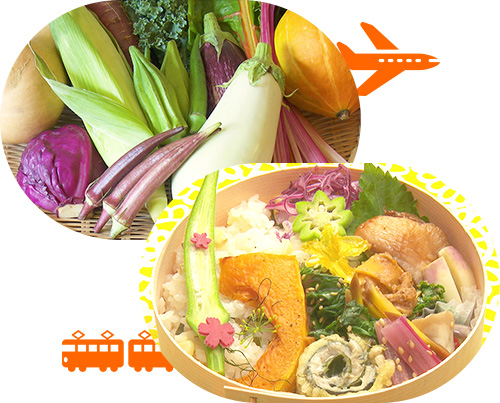
- BENTO TOPICS
- from Episode 8/ Season 7.
- Kamakura
-

Today, from Kamakura, surrounded by the sea and mountains.
It's a popular summer destination for people living in Tokyo. -
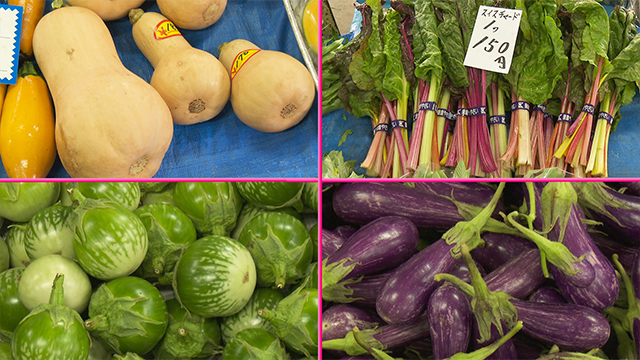
Thanks to its fertile land, Kamakura is famous for its vegetables.
Maki visits a farmer’s market that has been around for nearly a century.
Many of the vegetables here are difficult to find elsewhere.
She finds butternut squash, Swiss chard, and Thai eggplant. -
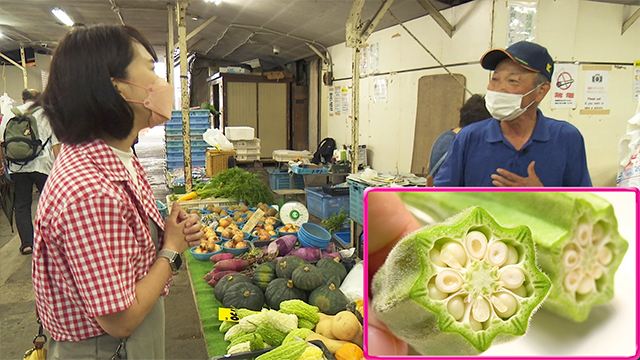
Farmer Yamamori grows 120 varieties of vegetables a year.
He says he does so to cater to the requests of his customers, many of whom are chefs of French and Italian cuisine.
He introduces Maki to an unusual okra with a cute star-shaped cross-section.
-
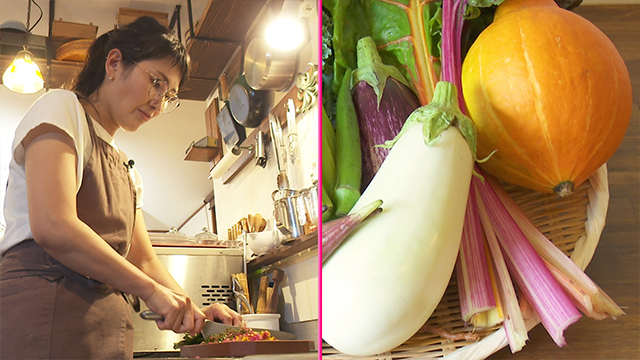
Maki visits Mori Yuiko, a chef who runs a bento delivery service.
Mori says she aims to bring out the inherent rich flavor of Kamakura vegetables by keeping things simple. -
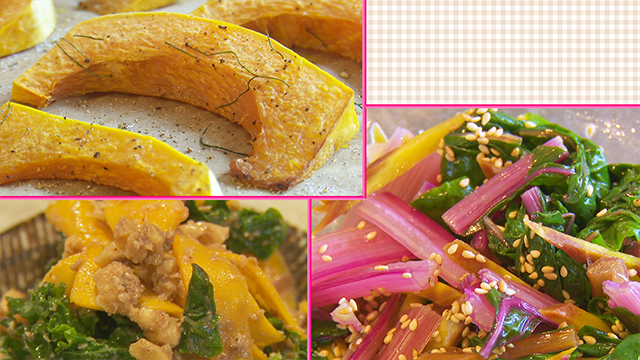
First, she grills butternut squash with fragrant dill.
She then makes a salad of colorful carrots and Swiss chard with sesame oil dressing.
Next, colinky squash, kale, and walnuts are dressed with miso sauce. -
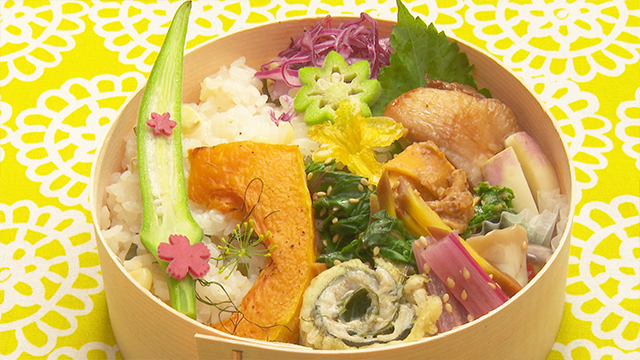
She also makes a sardine and shiso wrap tempura to add to her bento.
For a finishing touch, she adds star okra marinated in seasoned dashi, as well as cucumber flower tempura.
A Kamakura veggie bento that looks like a flower garden!
-
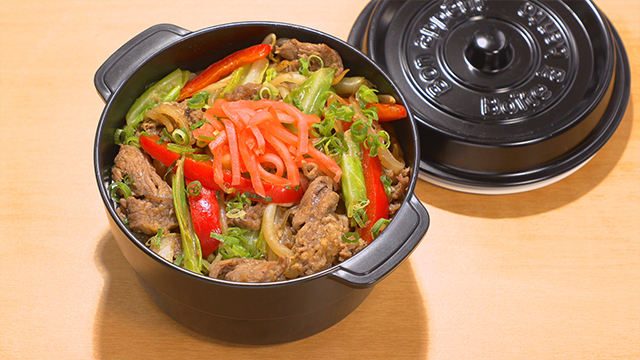
- BENTO RECIPES
- from Episode 7 / Season 7.
- Lamb and Veggie Stir-fry Bento
- (779 kcal)
-
 by Marc Matsumoto
by Marc Matsumoto
Bento contents:
- Lamb and Veggie Stir-fry
- Rice
- Benishoga (red pickled ginger)
Ingredients:
Makes enough to pack into 2 bentos
For marinade
- 25 g kiwi, peeled
- 25 g onion, peeled
- 7 g garlic, peeled
- 3 tbsp 3S sauce (equal parts soy sauce, sake, sugar)
- 2 tsp toasted sesame oil
- 1/2 tsp salt
- 1/2 tsp black pepper
- 200 g lamb shoulder, thinly sliced
- 2 tsp vegetable oil
- 120 g bean sprouts
- 60 g cabbage, chopped
- 60 g onion, sliced
- 60 red bell pepper, seeded and sliced
- 1 scallion, finely chopped
Directions:
1. To make the marinade, grate the kiwi, onion, and garlic into a bowl. Add the 3S sauce, toasted sesame oil, salt, and black pepper, and stir together.
2. Add the lamb and marinate overnight.
3. To make the Lamb and Veggie Stir-fry, heat the vegetable oil in a frying pan over medium-high heat until hot.
4. Drain off the marinade and reserve it for later. Next, add the lamb to the frying pan and stir-fry until it's browned and cooked through. When the lamb is fully cooked, transfer it to a plate.
5. Add the bean sprouts, cabbage, onion, and red bell peppers. Stir-fry the vegetables until they start to brown around the edges but are still crisp. Add the reserved marinade and stir-fry until all of the liquid has evaporated.
6. Return the meat to the pan and toss to distribute evenly.
7. Pack the stir-fry over a bento box of white rice. Garnish with scallions.
-
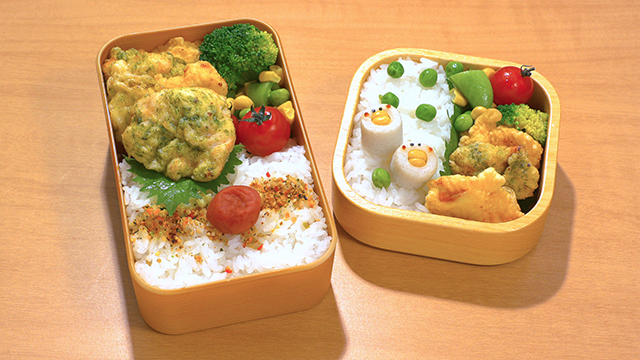
- BENTO RECIPES
- from Episode 7 / Season 7.
- Tori-ten Bento
- (For adults 802 kcal, For kids 356 kcal)
-
 by Maki Ogawa
by Maki Ogawa
Bento contents:
- Tori-ten
- Rice (250 g for adults, 100 g for kids)
- Sweet corn and snap peas sautéed in butter
- Broccoli
- Cherry tomatoes
- Shiso leaves
- Umeboshi (for adults)
- Colorful furikake rice seasoning (for adults)
- Green peas (for kids)
- Chikuwa "chickens" (for kids)
Ingredients:
For Tori-ten
- 1 chicken breast (220-250 g)
- 1 tbsp grated ginger
- 1/2 tsp grated garlic
- 2 tbsp sake
- 1/2 tsp sugar
- A pinch each of salt and pepper
- 1 tsp sesame oil
- Aonori, as needed
- Batter
- 1 egg
- 30 g flour
- 10 g potato starch
- 1.5 tbsp cold water
For the chikuwa "chickens"
- Chikuwa (tube-shaped fish cake)
- Sweet corn
- Nori
- Ketchup
Directions:
For Tori-ten
1. Remove excess fat and tendons from the chicken breast and cut into bite-size pieces.
2. Cut against the grain as shown.
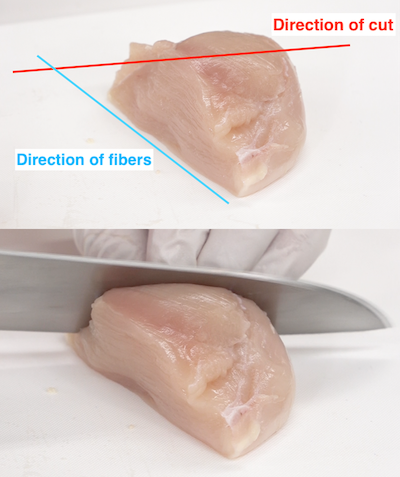
3. Add the chicken and seasonings in a food storage bag or bowl and marinate for 20-30 minutes. (You can also marinate overnight in the fridge.)
4. Drain the chicken and wipe off the marinade.
5. Make the batter.
6. Coat half of the chicken in batter and fry in oil preheated to 170 degrees C.
7. Add aonori to the batter, coat the remaining chicken, and fry.
For the chikuwa "chickens"
1. Trim both ends of the chikuwa.
2. Pack the chikuwa with a double layer of corn.
3. Cut out the chick's eyes from a piece of nori. Use a toothpick to draw the cheeks with ketchup.
4. Place a corn kernel on top for the rooster’s comb.
-
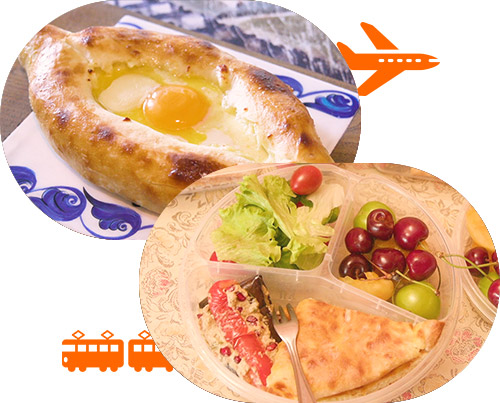
- BENTO TOPICS
- from Episode 7/ Season 7.
- Georgia
-

Georgia is a country in the Caucasus region. Famous for its rich food culture, it’s said to be the birthplace of wine.
-
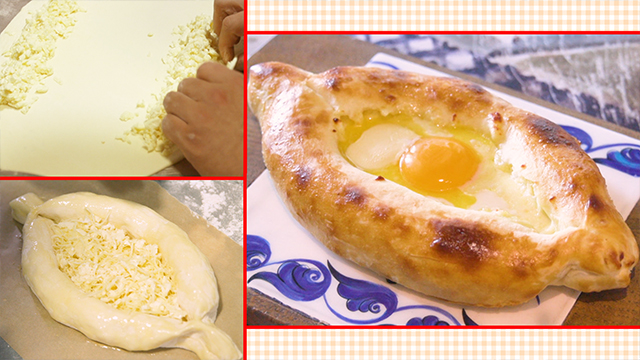
Khachapuri, bread filled with cheese, is regarded by many as a national comfort food. There are many variations on this dish, but the most popular type comes in the shape of a boat and is topped with egg yolk and butter.
-
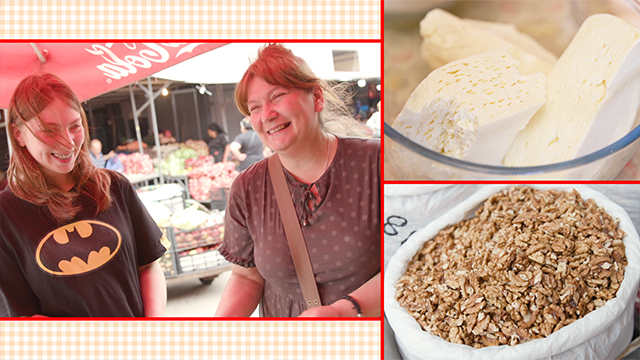
Bento maker Tata is a music teacher. She and her daughter, Taso, head to the market to buy fresh cheese and walnuts, which are essential to Georgian cooking. They’re going to make a bento filled with khachapuri and other traditional dishes.
-
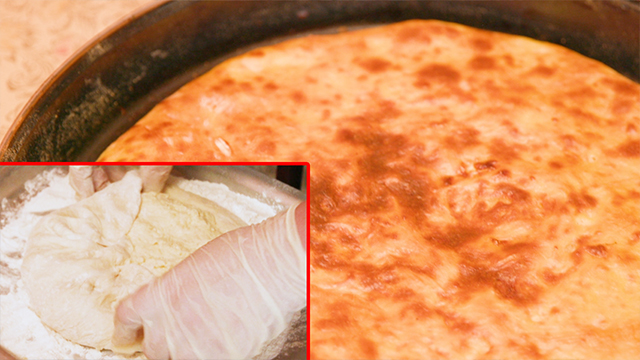
Tata uses equal amounts of cheese and dough for her khachapuri. She wraps the cheese in dough and coats it with an egg wash that contains yogurt. After it’s baked, she cuts it so it will fit easily into a bento box.
-
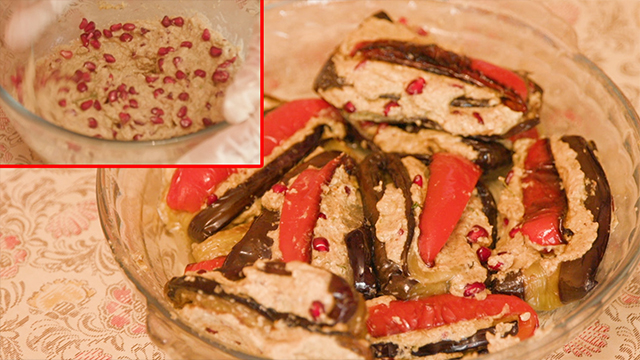
To go with the khachapuri, she makes a local dish that includes walnuts and eggplant. She layers the grilled eggplant and a paste made with walnuts, coriander, pomegranate, and various spices, and tops it with red bell peppers.
-
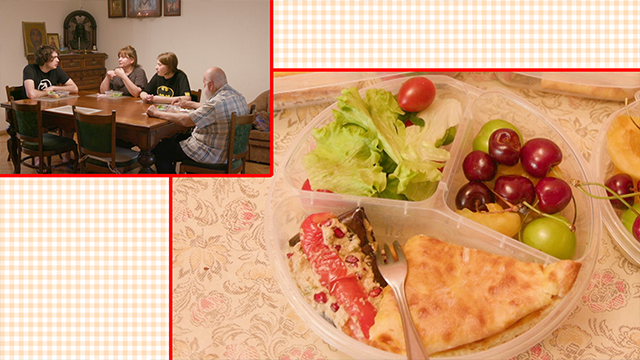
She packs the food into bento boxes along with an assortment of fresh fruit and vegetables. Tata's son and father-in-law join them to sing a prayer before enjoying their bentos filled with traditional Georgian food.
-
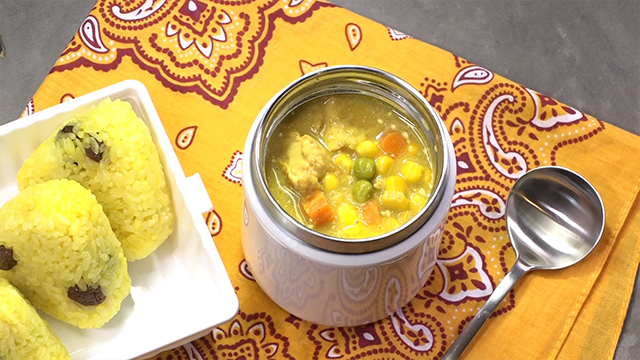
- BENTO RECIPES
- from Episode 6 / Season 7.
- Curry Soup Bento
- (208 kcal)
-
 by Marc Matsumoto
by Marc Matsumoto
Bento contents:
- Curry Soup Bento
- Turmeric raisin onigiri
Ingredients:
Makes enough for two 300 ml soup jars
- 50 g onion
- 30 g carrot
- 5 g garlic
- 5 g ginger
- 1/16 tsp baking soda
- 300 ml dashi
- 2 tbsp 3S sauce
- 2 tsp potato starch
- 150 g chicken thighs
- 1/4 tsp salt
- 2 tsp vegetable oil
- 1 tbsp curry powder
- 100 g mixed frozen vegetables
- 2 tbsp sour cream
Directions:
*Preheat your vacuum flasks by filling them with boiling water.
1. Grate the onion, carrot, garlic, and ginger, then stir in the baking soda.
2. Mix the dashi, 3S sauce, and potato starch together in a bowl.
3. Season the chicken with salt.
4. Heat a pot over medium-high heat until hot. Add the oil and chicken in a single layer with the skin-side down.
5. Fry the chicken until browned on one side, then flip and brown the other side.
6. Remove the chicken from the pan and add the grated vegetables and curry powder. Fry the mixture until it forms a thick paste after 2-3 minutes.
7. Add the dashi mixture, and frozen vegetables, then return the chicken to the pot. Bring the mixture to a boil.
8. Pour out the hot water from the vacuum flasks. Divide the hot curry between the two flasks, and add a tablespoon of sour cream to each one. Tightly close the lids. Let the curry continue to cook in the vacuum flasks for 3-4 hours.
-
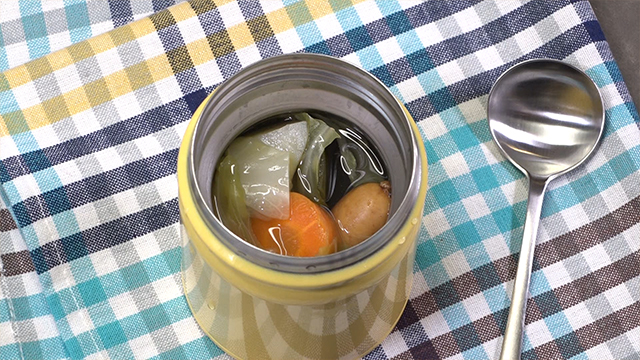
- BENTO RECIPES
- from Episode 6 / Season 7.
- Pot-au-feu-style Soup
- (114 kcal)
-
 by Ariga Kaoru
by Ariga Kaoru
Ingredients:
Makes enough for one 300 ml soup jar
- 1 (20 g) sausage
- 1/2 (60 g) potato
- 1 cm (12 g) carrot
- 1/2 leaf (60 g) cabbage
- 1 square piece of konbu (about 2-3 cm, or 1 g in size)
- 200 ml water
- 1/3 tsp salt
- A pinch of pepper
Directions:
*Preheat your vacuum flask by filling with boiling water.
1. Peel the potato and cut into bite-size pieces. Tear the cabbage into bite-size pieces.
2. Pour 200 ml of water into a pot, add all the ingredients and seasonings, and bring to a boil.
3. Pour into the flask and close the lid tightly.
-
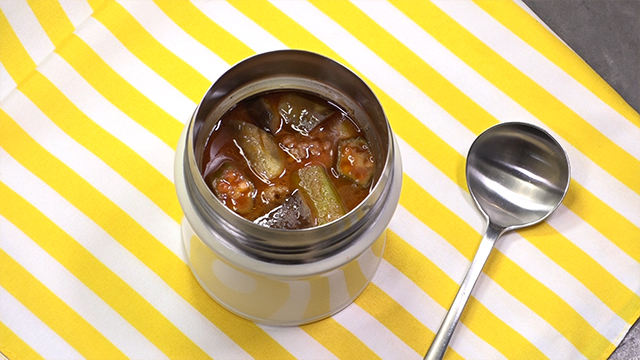
- Tomato Vegetable Soup
- (198 kcal)
-
 by Ariga Kaoru
by Ariga Kaoru
Ingredients:
Makes enough for one 300 ml soup jar
- 40 g ground meat (mixed pork, beef, or chicken)
- 1/2 an eggplant (40 g)
- 2 okra (30 g)
- A little grated garlic
- 100 ml tomato juice
- 100 ml water
- 1/3 tsp salt
- 2 tsp olive oil
Directions:
*Preheat your vacuum flask by filling with boiling water.
1. Cut the eggplant and okra into bite-size pieces.
2. Sauté the grated garlic in olive oil until aromatic. Add the eggplant, ground meat, and okra and continue to cook. Add the salt, water, and tomato juice and bring to a boil.
3. Pour into the flask and close the lid tightly.
-
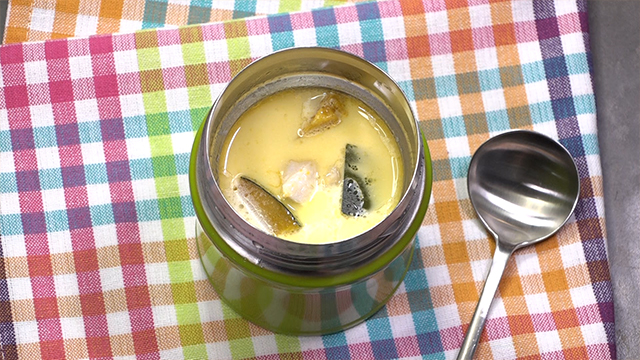
- Creamy Kabocha Soup
- (372 kcal)
-
 by Ariga Kaoru
by Ariga Kaoru
Ingredients:
Makes enough for one 300 ml soup jar
- 60 g chicken thigh
- 80 g kabocha pumpkin
- 2 tbsp rolled barley
- 100 ml milk
- 100 ml water
- 1/3 tsp salt
- 1 tsp vegetable oil
Directions:
*Preheat your vacuum flask by filling with boiling water.
1. Cut the chicken and kabocha into 2-2.5 cm cubes.
2. Add the chicken, kabocha, salt, vegetable oil, and water to a pot. Cover and simmer for 4 minutes.
3. Add the milk and rolled barley and bring to a boil. Pour into the flask and close the lid tightly.
-
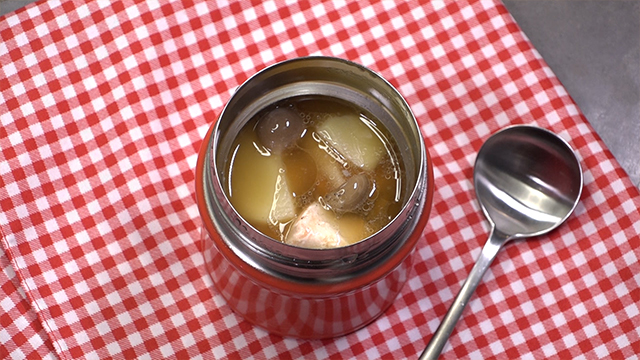
- Salmon Miso-butter Soup
- (286 kcal)
-
 by Ariga Kaoru
by Ariga Kaoru
Ingredients:
Makes enough for one 300 ml soup jar
- 1 fillet salmon (80 g, skinned)
- 80 g potato (peeled)
- 20 g shimeji mushrooms
- 200 ml water
- 2 tsp miso
- 5 g butter
- A pinch of pepper
Directions:
*Preheat your vacuum flask by filling with boiling water.
1. Cut the salmon and potato into bite-size pieces.
2. Add the potatoes, salmon, shimeji, and water to a pot. Cover and simmer for 3 minutes.
3. Dissolve the miso and pour into the flask. Add butter and pepper, and close the lid tightly.
-
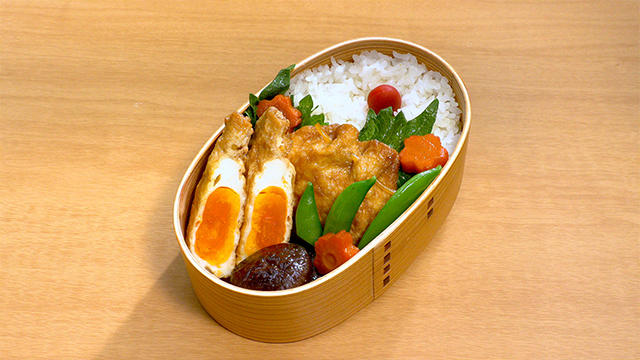
- BENTO RECIPES
- from Episode 5 / Season 7.
- Kinchaku Tamago Bento
- (615 kcal)
-
 by Marc Matsumoto
by Marc Matsumoto
Bento contents:
- Kinchaku Tamago
- Snap peas
- Shiso leaves
- Crunchy umeboshi
- Rice
Ingredients:
Makes 4 kinchaku tamago
- 400 ml water
- 4 dried shiitake mushrooms (8 g)
- 90 ml 3S sauce
- 1/2 tsp salt
- 4 eggs
- 2 pieces abura-age (fried tofu sheets)
- 1 piece dry spaghetti
- 1 carrot, sliced and cut into flowers
Directions:
1. Soak the dried shiitake mushrooms in the water until they are fully rehydrated.
2. When the mushrooms are done rehydrating, pour the liquid into a frying pan, leaving any sediment behind in the bowl. Next, add the 3S sauce and salt to the pan.
3. Break the eggs into two small bowls.
4. Cut the abura-age in half, then use your fingers to open up a pocket into each half.
5. Pour an egg into one pocket of abura-age, then use a piece of spaghetti to sew the pocket shut. Repeat with the other pocket.
6. Bring the sauce to a full boil and lower the kinchaku into the liquid. Add the cut carrots and shiitake mushrooms around the pockets.
7. Reduce the heat to maintain a full simmer and let the kinchaku cook for 10 minutes, flipping them over every two minutes.
8. When the egg is cooked through, and there is almost no liquid left in the pan, the kinchaku tamago is done.
-
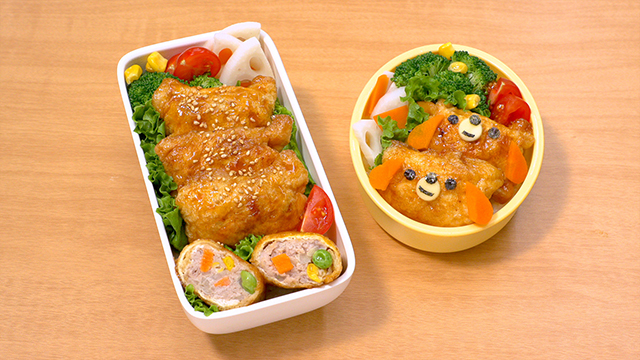
- BENTO RECIPES
- from Episode 5 / Season 7.
- Pork Inari Bento
- (For adults 912 kcal, For kids 484 kcal)
-
 by Maki Ogawa
by Maki Ogawa
Bento contents:
- Pork Inari
- Rice (180 g for adults, 100 g for kids)
- Lotus root
- Carrot
- Broccoli
- Sweet corn
- Cherry tomatoes
- Leaf lettuce
- Toasted sesame seeds (for adults)
- Puppy decorations (for kids)
Ingredients:
For Pork Inari (6 pouches)
- 3 abura-age
- 150 g ground pork
- 40 g mixed vegetables
- 50 g onion
- A pinch each of salt and pepper
- Vegetable oil, as needed
- A pinch of potato starch
- 2 tbsp water
- 3 tbsp 3S sauce (1 tbsp each of sugar, sake, and soy sauce)
For the puppy decorations
- Cheese
- Nori
- Carrot
Directions:
For Pork Inari
1. Cut the abura-age in half and open to form pockets.
*You can pour boiling water over the abura-age to remove excess oil.
2. Boil the mixed vegetables and drain. Add to a bowl along with the ground pork, minced onion, salt, and pepper. Mix well.
3. Stuff the inari pouches with the meat filling (about 40 g per pouch). Fold down the top to close.
4. Sprinkle evenly with potato starch.
5. Oil the frying pan and place the pouches seam-side down to seal. Brown both sides.
6. Add the 3S sauce and water to the pan, cover and steam for 4-6 minutes until the pouches are cooked through. Use a chopstick to prod and test them. If they’re springy, they’re done.
For the puppy decorations
1. Use an oval-shaped cookie cutter to cut out four puppy ears from sliced boiled carrot.
2. Cut out two circles from a slice of cheese.
3. Use nori for the eyes, nose, and mouth.
-
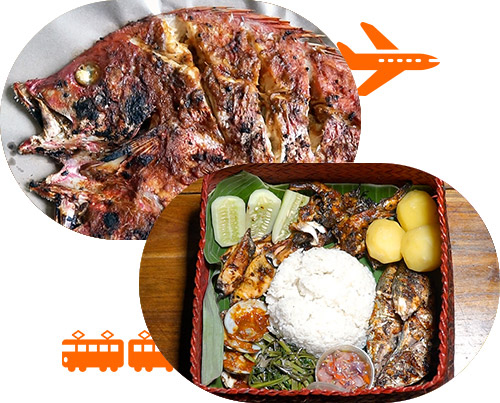
- BENTO TOPICS
- from Episode 5/ Season 7.
- Indonesia
-

Today, from the Indonesian island of Bali. This fishing village on the southern beach of Jimbaran Bay still retains much of the traditional way of life. It’s bustling with activing in the early morning as the fish are landed.
-

The fish go straight to the local fish market, the largest in Bali. It offers a huge variety of fresh seafood, including colorful fish, crabs, and lobsters from the Indian Ocean.
-
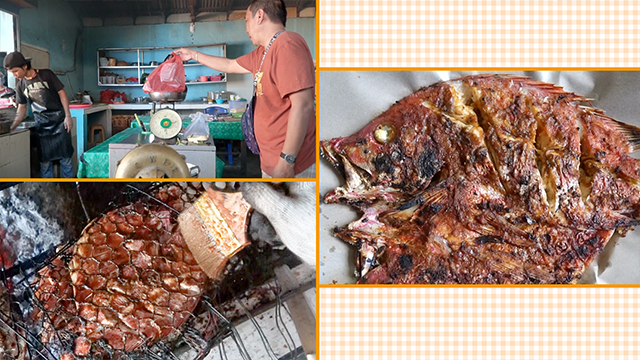
Many of the nearby restaurants will offer to prepare a traditional dish called ikan bakar using the seafood purchased at the market. The seafood is grilled over charcoal, coated evenly with chili sauce, and grilled until it’s crisp on the outside, and fluffy and moist on the inside.
-
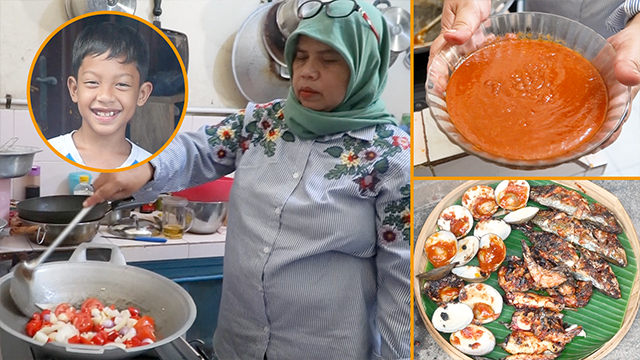
Bento maker Rahma and her son Akhtar are going to make an ikan bakar bento with horse mackerel, squid, shrimp, and clams. To make chili sauce, Rahma stir-fries chili peppers, tomatoes, shallots, onions, and garlic until aromatic, then puts the mixture in a blender. She adds a variety of seasonings, including coconut sugar, to make a hot and sweet sauce that pairs well with seafood.
-
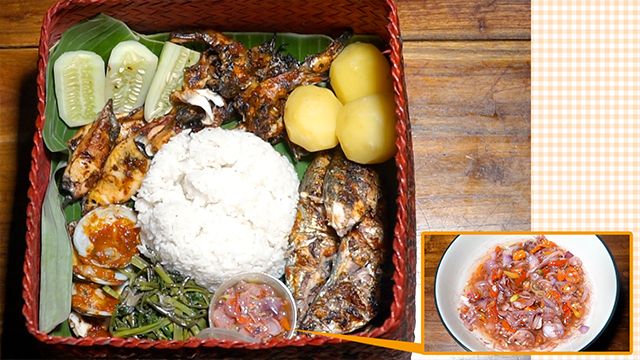
Ikan bakar is typically served with stir-fried Chinese water spinach and steamed potatoes. It's accompanied with sambal matah, a spicy condiment of chili peppers and shallots seasoned with seared fermented shrimp paste. Rahma packs everything into a huge bento box to go on a family picnic.
-
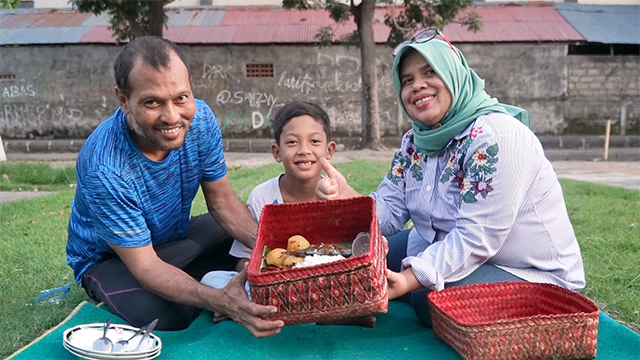
The family heads out on a picnic to enjoy the meal they made together. Have fun and enjoy the Indonesian-style seafood bento!
-
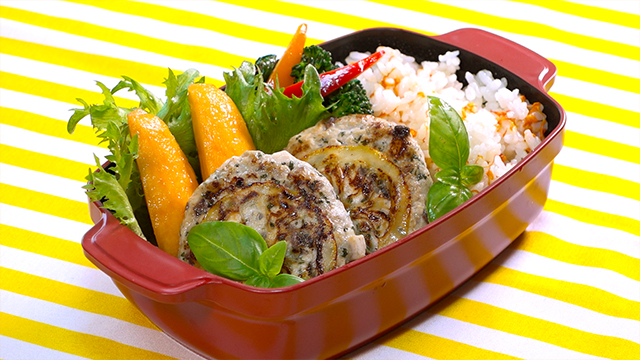
- BENTO RECIPES
- from Episode 4 / Season 7.
- Sanga-burg Bento
- (491 kcal)
-
 by Marc Matsumoto
by Marc Matsumoto
Bento contents:
- Sanga-burg
- Common marigold rice
- Biwa (loquat)
- Bell pepper spears
- Frill Lettuce
- Stick broccoli sautéed with garlic and olive oil
- Basil leaves
Ingredients:
For Sanga-burg (yields 6)
- 400 g horse mackerel filets (700 g whole fish; cleaned, skinned, and deboned)
- 60 g new onions, minced
- 10 g fresh basil, minced
- 2 g garlic, grated
- 1 tbsp olive oil, plus more for frying
- 1 tsp nam pla
- 1/3 tsp salt
- 6 very thin slices of lemon (1 mm thick)
For Common Marigold rice
- 3 g dried common marigold flower petals
- Boiling water
- 2 rice cups (360 ml) rice
Directions:
For Sanga-burg
1. Cut 1/4 of the fish into 6 mm (1/4 inch) cubes, and add it to a bowl.
2. Chop the remaining fish with your knife until it forms a paste.
3. Add the onions, basil, and garlic into the paste and continue chopping until the mixture is evenly combined.
4. Add the mixture to the bowl with the chopped mackerel, then add the olive oil, nam pla, and salt. Knead the mixture together with your hands until the ingredients are uniformly combined.
5. Flatten out the mixture and divide it into 6 segments.
6. Heat a frying pan over medium heat until hot. Add a splash of olive oil and swirl it around to coat the pan.
7. Rub your hands with some more olive oil, and grab a segment of the Sangayaki mixture. Toss the mixture between your hands to shape it into an oval patty, and then place a lemon slice on one side. Continue tossing the mixture between your hands until the lemon is securely embedded in the patty.
8. Place the patty lemon-side down in the frying pan and repeat with the remaining Sangayaki mixture.
9. Fry the patties until they appear cooked 2/3 through, and then flip them over. Fry the other side until they're cooked through (internal temperature of 60 degrees C (140 degrees F).
For Common Marigold rice
1. Pour boiling water over the flowers until they are covered, then let them steep while you prepare the rice.
2. Wash the rice until the water runs mostly clear, and fill the rice cooker to the 2-cup marker.
3. Drain and rinse the blossoms and squeeze out any excess water. Add the flower petals to the rice and stir to distribute evenly.
4. Cook the rice according to your rice cooker's directions.
-
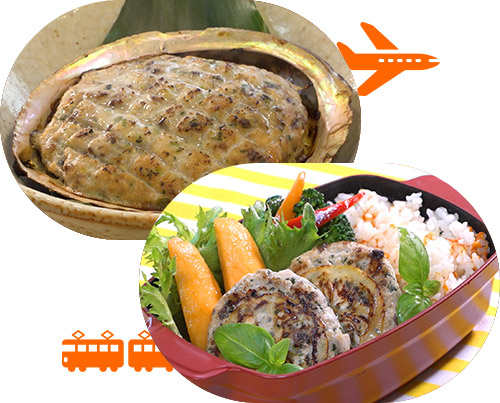
- Chiba Special
- from Episode 4/ Season 7.
- Boso Peninsula Chiba
-

Today on Bento Expo, Marc reports from the Boso Peninsula in Chiba Prefecture, located just to the east of Tokyo.
It boasts one of the richest fishing grounds in Japan. -
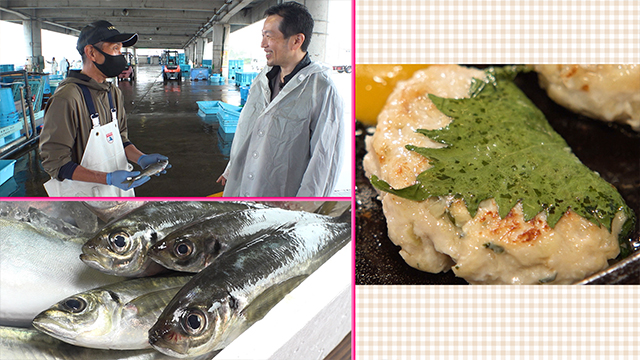
Marc visits the fishing port of Chikura. There, a local fisher treats him to a dish of sashimi made with aji, or horse mackerel.
Marc then visits a restaurant to try the local specialty: sangayaki, a miso-flavored fish patty. -
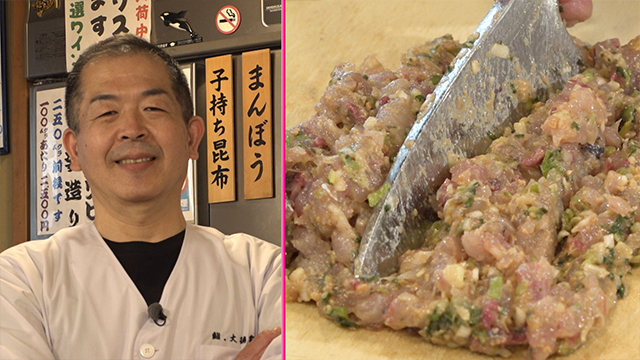
Sushi chef Kurihara Kazuyuki is an expert on sangayaki.
According to him, the dish evolved from namero, a dish prepared by fishers at sea.
Freshly caught fish is finely chopped with miso, Japanese leek, shiso leaves, and ginger until it becomes sticky.
-
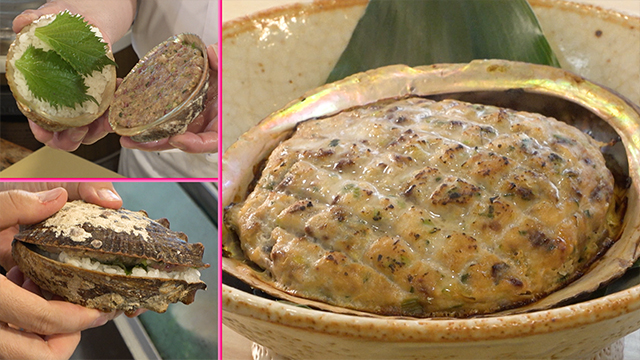
Abalone shells were once used as bento boxes.
Fishers would stuff one half of an abalone shell with namero and the other half with rice.
They would then grill this in a mountain hut called a sanga, which is one theory as to how sangayaki came into being. -
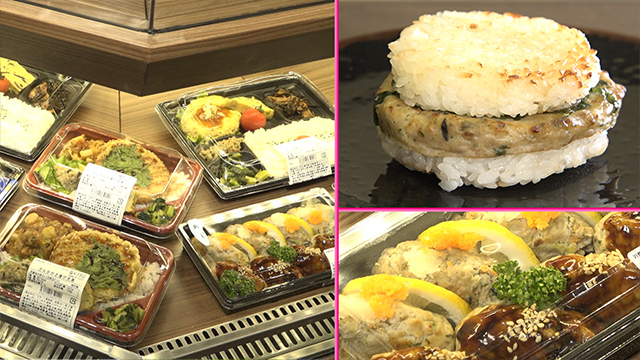
Marc also visited a shop that serves a variety of sangayaki bentos, including sushi rice topped with sangayaki, as well as sangayaki rice burgers.
-
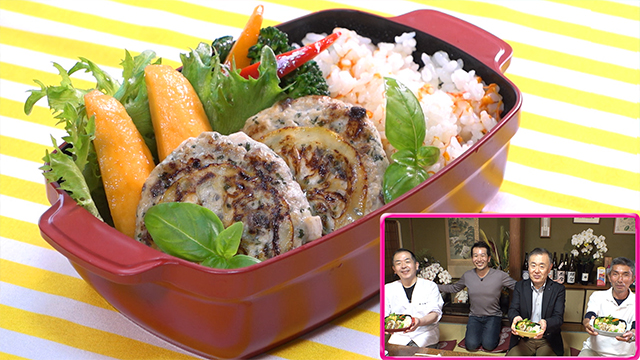
The bentos inspired Marc to create his own original sangayaki bento.
He uses basil instead of shiso, and nam pla fish sauce instead of miso to make a western-style sangayaki, topped with lemon.
He enjoys the bento together with the locals he has met in Chiba.
-
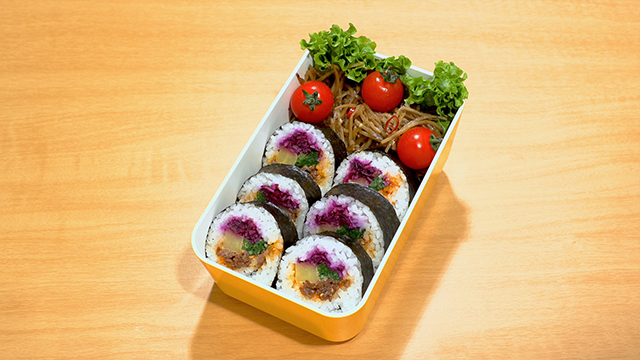
- BENTO RECIPES
- from Episode 3 / Season 7.
- Beef & Spicy Mayo Roll Bento
- (591 kcal)
-
 by Marc Matsumoto
by Marc Matsumoto
Bento contents:
- Beef & Spicy Mayo Roll
- Green lettuce
- Kinpira Gobo with black sesame seeds
- Small cherry tomatoes
Ingredients:
Makes 3 rolls
- 100 g spinach
- 130 g red cabbage
- 45 ml seasoned sushi vinegar
- 3 tbsp mayonnaise
- 1 tbsp sriracha
- 200 g very thinly sliced beef (shaved beef)
- 60 ml 3S sauce (equal parts soy sauce, sake, sugar)
- 3 tsp toasted sesame seeds
- 70 g takuan pickles (cut into 1 cm thick sticks)
- 2 rice cups (360 ml) Japanese short-grain rice, cooked in a rice cooker and cooled to room temperature
- 3 sheets nori
Directions:
1. Wash the spinach, but do not cut the roots off. Take care to rinse out any grit from between the stems.
2. Bring a large pot of water to a boil, and lower the spinach into the water root ends first. Return the water to a full boil, then drain the spinach and rinse under cold water until chilled.
3. Gather up the spinach by the roots, and squeeze as much excess water out as possible.
4. Line the root ends up on a cutting board and cut the roots off.
5. Divide the spinach into 3 piles. Flip half of each pile around so half the stems point in one direction and the other half point in the other direction.
6. To prepare the red cabbage, trim away the tough stems. Then, stack the cabbage leaves up and use a sharp knife to slice the cabbage into thin strips.
7. Put the cabbage in a bowl along with the sushi vinegar. Toss to coat evenly, then let marinate for at least 4 hours or overnight.
8. For the spicy mayonnaise, add the mayonnaise and sriracha to a bowl and mix until evenly combined.
9. To prepare the beef, add the meat and 3S sauce to a cold frying pan, and turn the heat to medium heat.
10. Cook the beef, shaking the slices loose so they don't clump together.
11. Continue cooking the beef until there is no liquid left in the pan and the beef is dark brown and shiny. Add the sesame seeds and let the meat cool completely.
12. To make the roll, line a sushi mat with plastic wrap. Next, prepare a bowl of water.
13. Drain the vinegar from the cabbage and lightly squeeze to eliminate any excess liquid.
14. Place a piece of nori on the sushi mat with the shiny side down.
15. Keep your hands wet using the bowl of water. Distribute the rice across the nori, leaving a 1 cm gap at the top. Use a picking and placing motion rather than a smearing motion to spread the rice.
16. Spread a strip of beef along the bottom edge of the rice, then top with a line of spicy mayo.
17. Line up the takuan pickles on top of the mayonnaise, and top with a strip of 1/3 of the spinach and 1/3 of the cabbage.
18. Grabbing the sushi mat, flip the edge of the nori up and over the fillings to meet the rice on the other side.
19. Give the roll a gentle squeeze to compress the contents, then use the mat to continue rolling the nori the rest of the way.
20. Give the roll a few squeezes, applying pressure evenly to all sides using the sushi mat.
21. To cut the roll, wet a long sharp knife and cut the roll in half using a rapid back-and-forth motion.
22. Line the halves up and slice them into quarters.
-
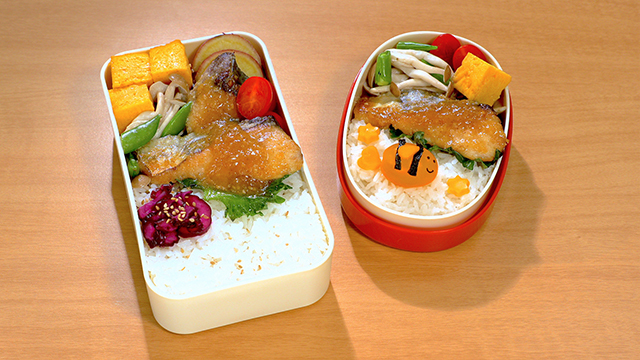
- BENTO RECIPES
- from Episode 3 / Season 7.
- Miso-mayo Sawara Bento
- (For adults 814 kcal, For kids 429 kcal)
-
 by Maki Ogawa
by Maki Ogawa
Bento contents:
- Cooked rice (190 g for adults, 100 g for kids)
- Miso-mayo Sawara
- Cherry tomatoes
- Boiled sweet potato
- Tamagoyaki (Japanese rolled omelet)
- Snap Peas and Shimeji Mushrooms Sautéed in Butter
- Shiso leaves
- Shibazuke pickles (for adults)
- Toasted sesame seeds (for adults)
- "Clownfish" made with yellow cherry tomatoes (decoration for kid’s bento)
Ingredients:
For Miso-mayo Sawara
- 2 filets Spanish mackerel
- 1 heaped tbsp (15 g) mayonnaise (preferably Japanese)
- 1 1/3 tbsp (20 ml) sake
- 1/2 heaped tbsp (10 g) miso
- 1 heap tbsp (10 g) sugar
- 2 tsp ground sesame seeds
- Flour, as needed
- A dash of vegetable oil
For the Snap Peas and Shimeji Mushrooms Sautéed in Butter
- Snap peas
- Shimeji mushrooms
- Butter
- Salt and pepper
For the "Clownfish" decoration
- Yellow cherry tomatoes
- Nori
- Cheese
Directions:
For Miso-mayo Sawara
1. Cut the fish into easy-to-eat pieces.
2. Sprinkle salt on both sides and set aside for 5 minutes to draw out the excess moisture. Pat dry with paper towels.
3. Dust both sides with flour.
4. Combine the mayonnaise, miso, sugar, sake, and ground sesame seeds.
5. Oil the pan and place the fish skin-side down (the fish will be plated skin-side up). Fry both sides to a golden brown.
6. Add the miso-mayo to the pan and coat both sides of the fish. Fry until most of the liquid has evaporated, then turn off the heat. Plate the fish and drizzle with any remaining sauce.
For the Snap Peas and Shimeji Sautéed in Butter
1. Blanch the snap peas for about a minute and drain. Remove the woody ends of the shimeji. Add the snap peas, shimeji, and butter to a heat resistant dish and microwave until the shimeji are cooked through. Season with salt and pepper.
For the "Clownfish" decoration
1. Coat the yellow cherry tomatoes with oil and wrap two thin strips of nori around the middle.
2. Use a heart-shaped cookie cutter to cut out the fin and tail from a slice of cheese.
3. Cut out the eyes and mouth from nori.
-
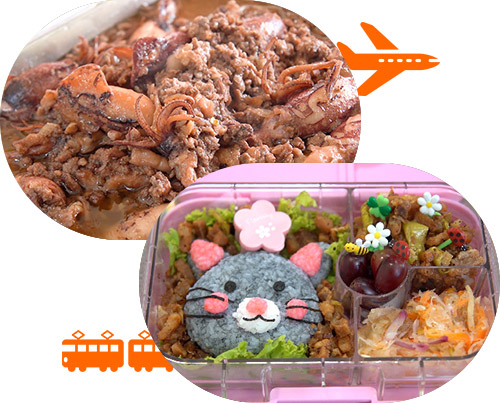
- BENTO TOPICS
- from Episode 3/ Season 7.
- The Philippines
-

Today, from Malabon in The Philippines. It's where many commuters who work in Manila live.
-
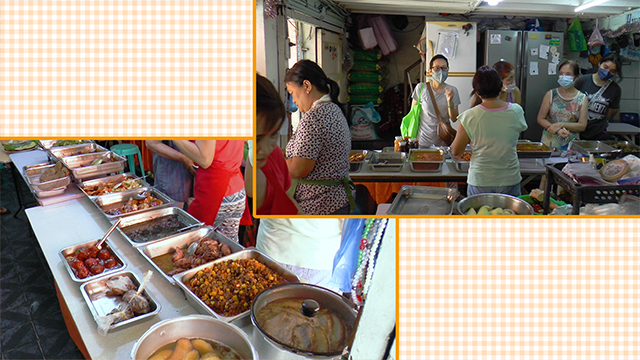
Road-side eateries called carinderias are a vital part of the local food culture. They serve a wide array of traditional dishes that customers are free to pick and choose. One carenderia is particularly beloved for its traditional flavors.
-
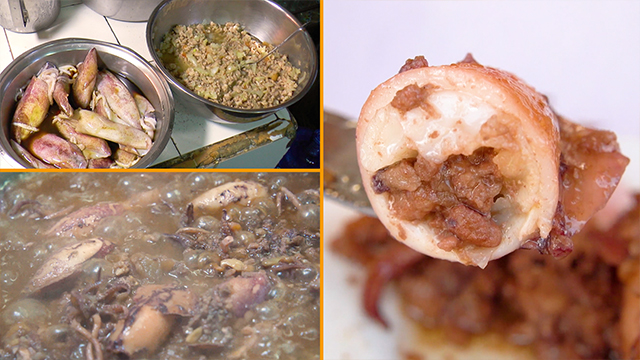
The favorite dish at this carenderia is squid stuffed with pork. Squid tubes are stuffed with a fragrant mixture of pork fried with onions and red bell peppers, and then simmered for half an hour. One bite, and the synergy of pork and squid bursts in your mouth.
-

Bento maker Regine has three daughters. Together they’re going to make a kyara-ben, or cute character bento. Her husband Tom is in charge of the main dish, sisig.
-
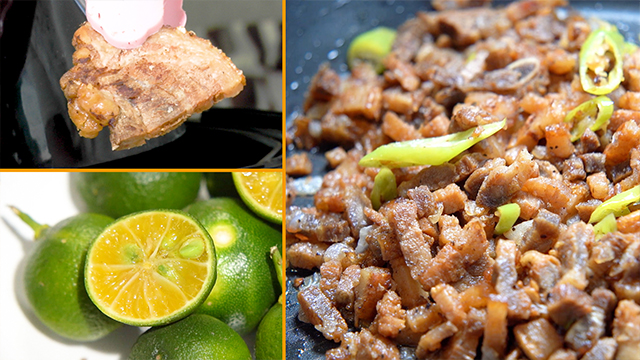
He starts off by frying boiled pork belly so that it’s crunchy on the outside but juicy on the inside. He then chops it up and stir-fries it together with onions, mayonnaise, and juice from calamansi, a citrus fruit widely used in Filipino cuisine. The tangy juice pairs well with the rich umami of pork.
-
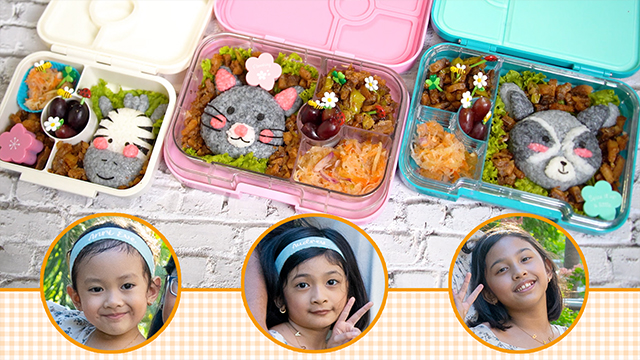
Regine uses natural colorings to make pink and gray onigiri, which she then turns into a zebra, a kitty cat, and a raccoon to represent her daughters. She packs these with Tom's sisig, and for a side dish she includes atchara, a type of pickles. This completes her cute kyara-ben, packed with Filipino cuisine!
-
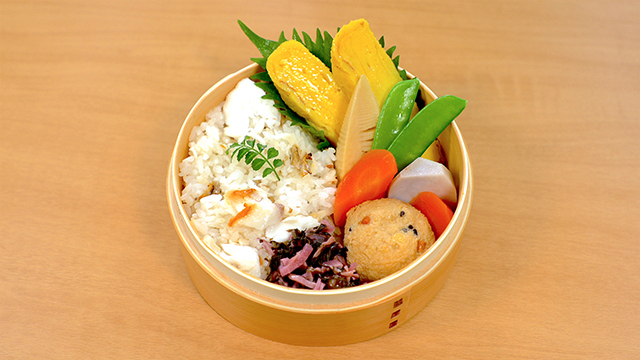
- BENTO RECIPES
- from Episode 2 / Season 7.
- Taimeshi Bento
- (511 kcal)
-
 by Marc Matsumoto
by Marc Matsumoto
Bento contents:
- Taimeshi
- Tamagoyaki
- Nimono (Takenoko, carrot, satoimo, ganmodoki)
- Snow peas
- Shiso leaf
- Kinome
- Shibazuke
Ingredients:
For Taimeshi
Makes enough to pack into 3-4 bentos
- 225 g sea bream
- 1/2 tsp salt
- 2 rice cups (360 ml) Japanese short-grain rice
- 1 tbsp sake
- 3 g konbu kelp
Directions:
1. Remove any scales or bones from the sea bream. Pat dry and sprinkle on all sides with the salt. Set the fish on a few layers of paper towels and let them drain for at least 15 minutes or up to overnight.
2. Wash the rice until the water runs mostly clear. Put the rice in the rice cooker bowl, then add the sake and fill the bowl up to the 2-cup marker with cold water. Let the rice soak while you finish preparing the fish.
3. When the sea bream is done salting, pat any liquid off the surface. Set it on a non-stick surface, then grill it in a toaster oven (set to broil) until the fish is cooked through and has started to brown around the edges.
4. When the fish is cooked, add half of it on top of the rice, and set the other half aside.
5. Cook the rice according to the rice cooker's directions.
6. When the rice is done, add the reserved sea bream and let it steam on top of the rice for a few minutes to reheat.
7. Once the fish has been reheated, break it up with a rice paddle or spatula and stir it into the rice.
8. Let the rice cool before packing it into bento.
-
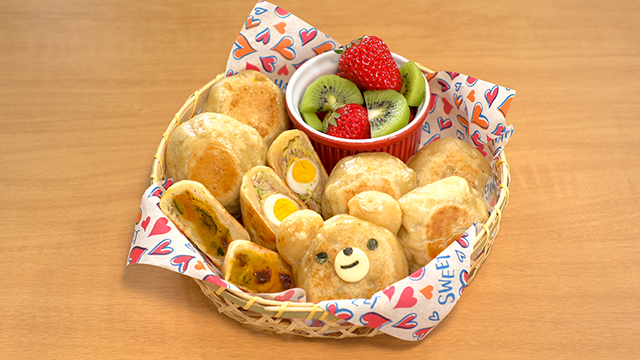
- BENTO RECIPES
- from Episode 2 / Season 7.
- Oyaki Bento
- (1098 kcal)
-
 by Maki Ogawa
by Maki Ogawa
Bento contents:
- Oyaki
- 6 Oyaki stuffed with a ground meat and quail egg filling
- 2 Oyaki stuffed with a condensed milk, kabocha, and raisin filling
- Strawberries
- Kiwi
Ingredients:
For Oyaki (yields 8)
- 150 g flour
- Approx. 50 g of mashed potatoes (made with instant mashed potato flakes)
- 4 g baking powder
- 15 g sugar
- A pinch of salt
- 1 tsp vegetable oil
- 75 ml warm water (about 50 degrees C)
- Oyaki bear cubs
- Nori
- Cheese
For the ground pork and quail egg filling (one batch for about 8 oyaki)
- 100 g ground pork
- 130 g cabbage
- 30 g Japanese leek
- 2 tsp soy sauce
- A pinch of salt and pepper
- A pinch of salt (for the salted and squeezed cabbage)
- 8 hard-boiled quail eggs
For the condensed milk, kabocha, and raisin filling (one batch)
- 100 g frozen kabocha
- Raisins, as needed
- Condensed milk, as needed
Directions:
1. Add the flour, sugar, salt, vegetable oil, baking powder, and mashed potatoes to a food processor.
2. Use a spoon to mix the warm water into the baking powder.
3. Switch on the food processor and mix the dough. Remove, place in a bowl, cover with plastic wrap and let rest for 30 minutes. In the meantime, make the filling.
4. Cut the cabbage into shreds and massage with salt to draw out the excess water. Squeeze to drain. (No need to rinse the cabbage)
5. Combine the ground meat, chopped leek and cabbage, soy sauce, salt, and pepper, and knead until sticky. Form 30 g meat balls, flatten and wrap each around a quail’s egg.
6. Heat the kabocha in a microwave. Stir in condensed milk to taste. Mix with raisins and form 30 g balls.
7. Divide the dough into eight pieces and shape into patties about 35 g each.
8. Flatten the edges with your hands.
9. Press the filling into the center and gather the dough around to form a dumpling.
10. Cut off the tops and save for the ears of the oyaki bear cubs.
11. Oil a pan and fry both sides of the oyaki. (Make sure to use a large pan as the oyaki will swell!)
12. Once both sides are golden brown, add 100 ml of water and steam for 7-8 minutes.
13. Let cool and decorate to look like bear cubs. Place sliced cheese cut into circles for the nose, and use nori to form the eyes, nose, and mouth.
-
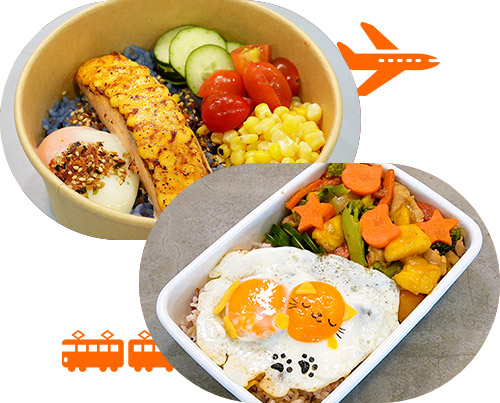
- BENTO TOPICS
- from Episode 2/ Season 7.
- Singapore
-

Today, from one of Asia’s most diverse countries, Singapore.
-
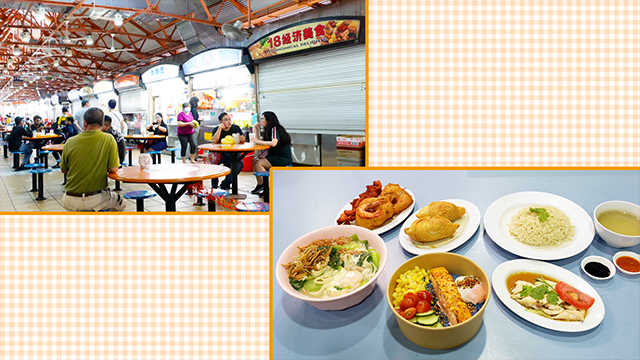
Hawker Centers are food courts home to stalls that feature a wide range of cuisines. They're an important part of everyday life in Singapore. In 2020, Singapore’s Hawker Culture was listed as a UNESCO Intangible Cultural Heritage.
-
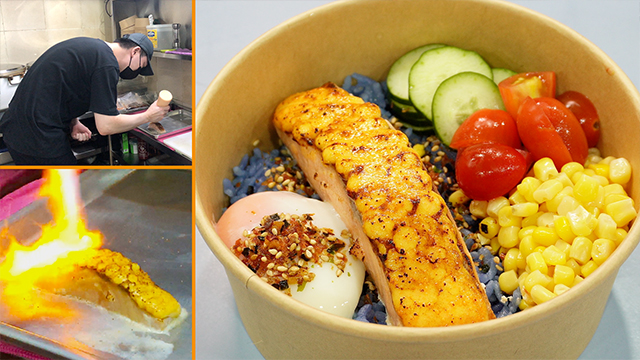
This innovative hawker bento features seared salmon with mentaiko sauce on top of butterfly pea rice, evocative of a blue lagoon. It looks and tastes delicious.
-
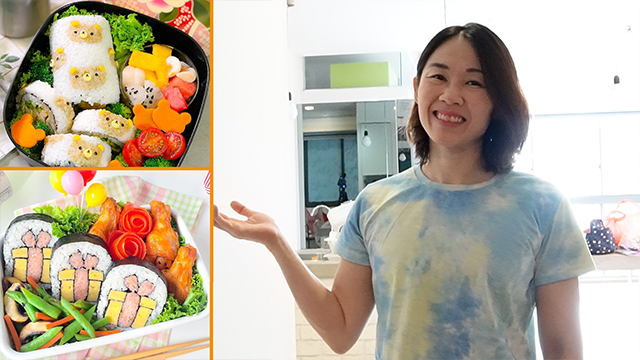
Shirley Wong is a bento artist whose social media account has over 300,000 followings. Her cute kyaraben made with everyday ingredients have helped spread bento culture worldwide.
-
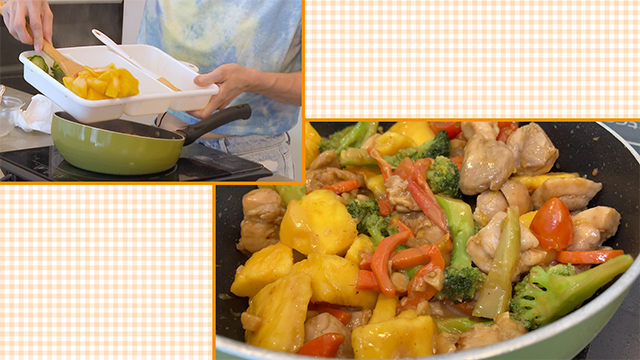
Her concern over food loss has led her to focus on making bentos with imperfect produce. Today, she’s using imperfect mangos to make a tropical and fruity stir-fry. Sweet mangos and umami-rich chicken are a great match.
-
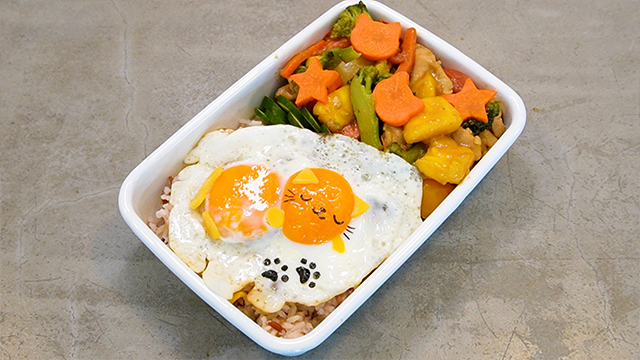
She places two fried eggs on a bed of brown rice and adds pieces of nori and cheese to make a cute kitty cat. She manages to transform imperfect produce into a delightful bento.
-
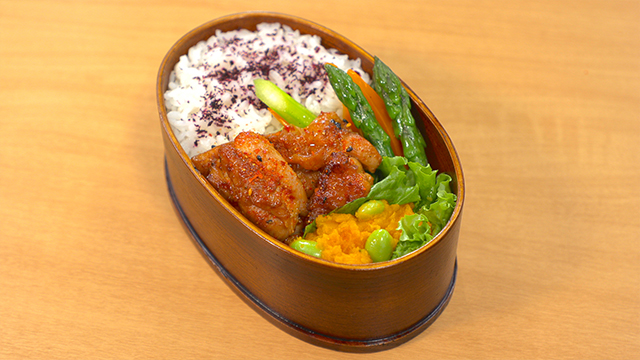
- BENTO RECIPES
- from Episode 1 / Season 7.
- Shichimi Chicken Bento
- (787 kcal)
-
 by Marc Matsumoto
by Marc Matsumoto
Bento contents:
- Shichimi Chicken
- Rice topped with yukari
- Asparagus and mini peppers stir-fried with garlic and black sesame seeds
- Kabocha salad (kabocha with mayonnaise, edamame and salt)
- Frill lettuce
Ingredients:
For Shichimi Chicken
Makes enough to pack into 2 bentos
- 1 1/2 tbsp mayonnaise (preferably Japanese)
- 1 1/2 tbsp soy sauce
- 1 packed tbsp brown sugar
- ½ tsp shichimi togarashi, plus more for garnish
- 350 g boneless skin-on chicken thighs, cut into bite-size pieces
Directions:
1. Make the marinade by whisking the mayonnaise, soy sauce, brown sugar, and shichimi togarashi together in a bowl.
2. Add the chicken and stir to coat evenly. Let this marinate for at least 15 minutes or up to overnight.
3. Heat a frying pan over medium heat and add the chicken with the skin side down to fry the chicken. Let this fry until the chicken is cooked halfway through and the skin has browned.
4. Flip the chicken over and continue cooking it until it's browned on the other side. Now turn the pieces around as needed until it is cooked through (you can cut one in half to check for doneness).
5. Transfer the chicken to a plate and let cool completely before packing it into a bento box. You can garnish the chicken with an extra sprinkle of shichimi togarashi if you'd like.
-
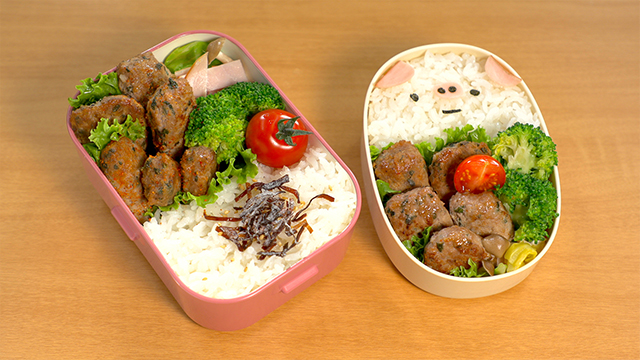
- BENTO RECIPES
- from Episode 1 / Season 7.
- Shichimi Sausage Bento
- (For adults 834 kcal, For kids 510 kcal)
-
 by Maki Ogawa
by Maki Ogawa
Bento contents:
- Rice(230 g for adults, 130 g for kids)
- Shichimi Sausage
- Cabbage, Ham, and Shimeji Mushrooms Steamed with Butter
- Broccoli
- Lettuce
- Cherry tomatoes
- Shiokonbu (shredded salted konbu) (for adults)
- White sesame seeds (for adults)
- Little Piggy decoration
- Ham
- Nori
Ingredients:
For Shichimi Sausage
- 250 g ground pork
- 2 g salt
- 0.5 g pepper
- 5 g shiso leaves
- 1 tbsp mayonnaise (preferably Japanese)
- 1 g shichimi togarashi (seven spice)
- 1.5 g garlic powder
- Vegetable oil for stir-frying, as needed
For the Cabbage, Ham, and Shimeji Mushrooms Steamed with Butter
- 5 g butter
- Approx.60 g shimeji mushrooms
- 2 leaves cabbage (chopped)
- 15 g ham
- A pinch of salt and pepper
Directions:
For the Shichimi Sausage
1. Cut the shiso into shreds.
2. Place all the ingredients except for the vegetable oil into a large flat food storage bag with a zipper seal. Knead until the mixture is sticky.
3. Flatten the bag.
4. Divide into four long sections by pressing down with a chopstick.
5. Squeeze the middle of each section with your fingers to create smaller sections, and freeze overnight. Once frozen, you can easily break it up into pieces.
6. Place the sausages in a heated pan.
7. Once both sides are brown, add 50 ml of water, cover, and steam to cook through.
For the Cabbage, Ham, and Shimeji Steamed with Butter
Place the ingredients in a heat-resistant dish, cover lightly with plastic wrap, and microwave. Season with salt and pepper.
For the Little Piggy
1. Use an oval-shaped cookie cutter to cut out a slice of ham. Cut in half to form the ears.
2. Use a straw to cut out the nose from the leftover ham.
3. Place the ham parts on the rice and use nori for the eyes, nostrils, and mouth.
-
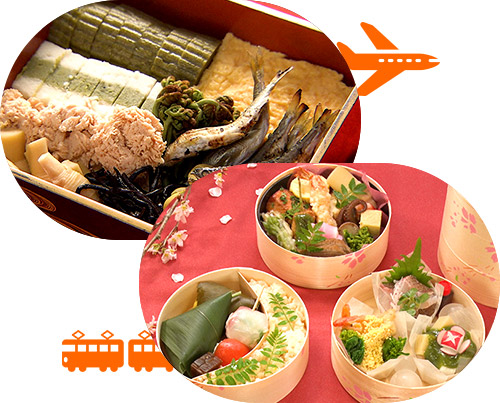
- BENTO TOPICS
- from Episode 1/ Season 7.
- Tokyo
-

Today, from Tokyo in spring, where cherry blossoms are blooming.
People celebrate the coming of spring by enjoying the custom of hanami, cherry-blossom viewing. -
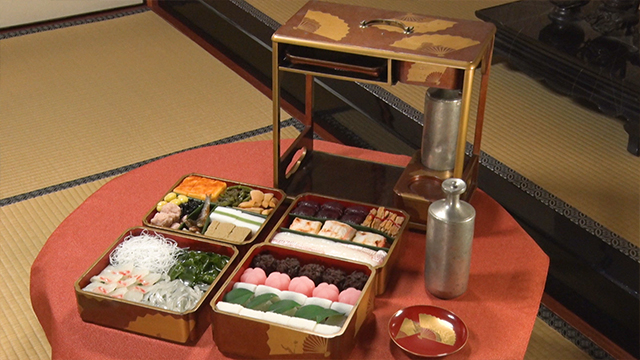
This is a recreation of a bento enjoyed during hanami 200 years ago.
The bento box is fitted with drawers to hold small dishes and sake vessels as well as food.
The four-tier stacking box contains a full-course meal, from spring mountain vegetables and sushi to sweets. -
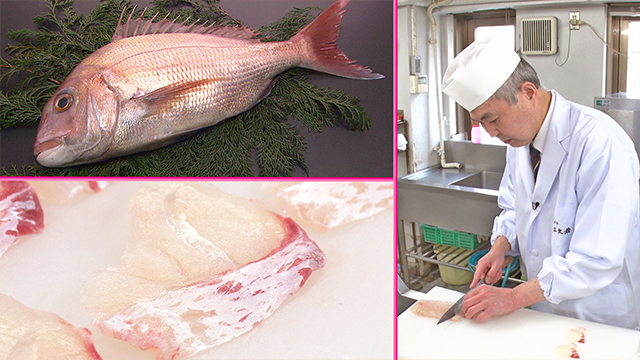
Festive hanami bentos are still enjoyed today.
This restaurant offers a bento featuring sakuradai, the moniker for female sea bream that turn cherry pink when they’re in season.
Since ancient times, sakuradai have been enjoyed as a spring delicacy.
-
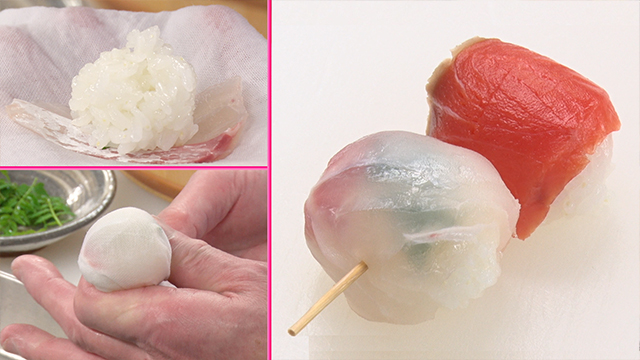
These bite-size sushi balls are made by wrapping sushi rice, sakuradai, and kinome in a cloth.
Threaded on a skewer along with similarly made salmon sushi, they make a cute and delicious finger food perfect for hanami. -
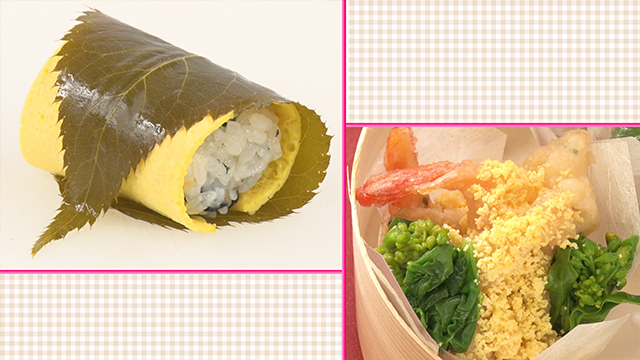
Simmered kanpyo, shiitake, and nori are mixed with sushi rice and wrapped in a thin omelet and salted cherry blossom leaf to make a sushi infused with the scent of cherry blossoms.
Fried shrimp and small fish are topped with scrambled egg to look like nanohana blossoms. -
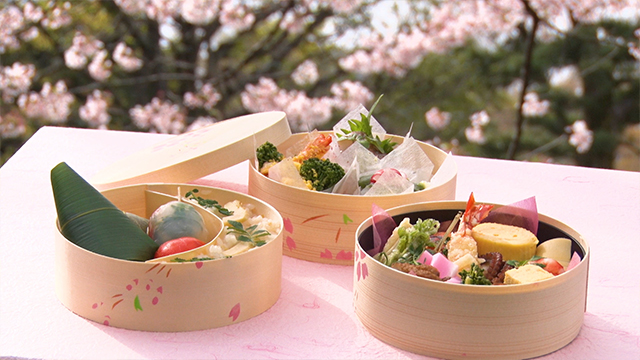
The visually stunning bento also contains bamboo rice, baby octopus, and mountain vegetable tempura. It’s packed with spring flavors.
A hanami bento, made to celebrate spring's arrival.



